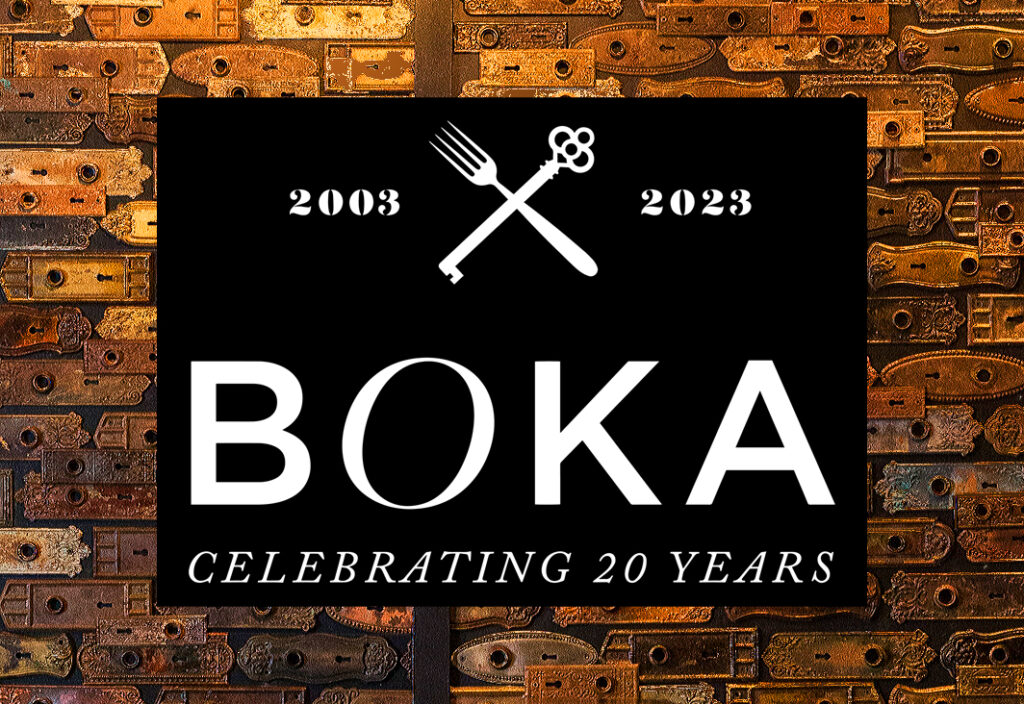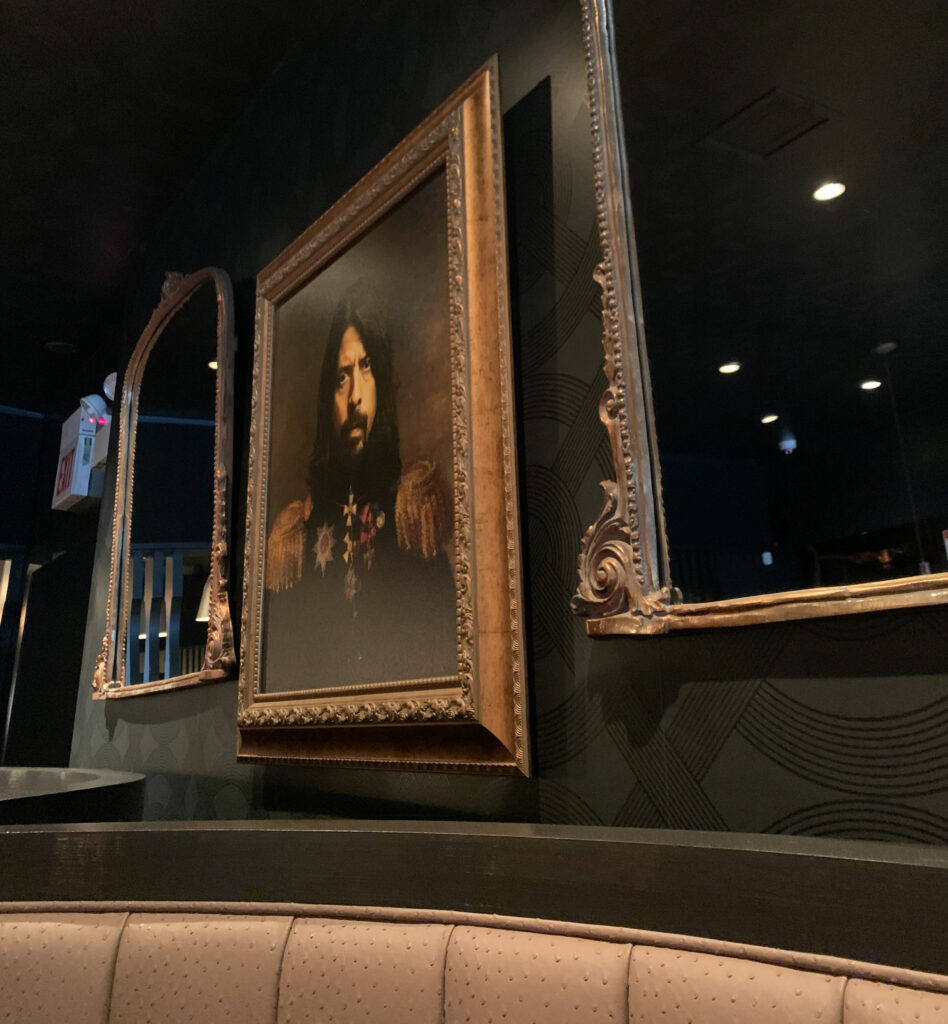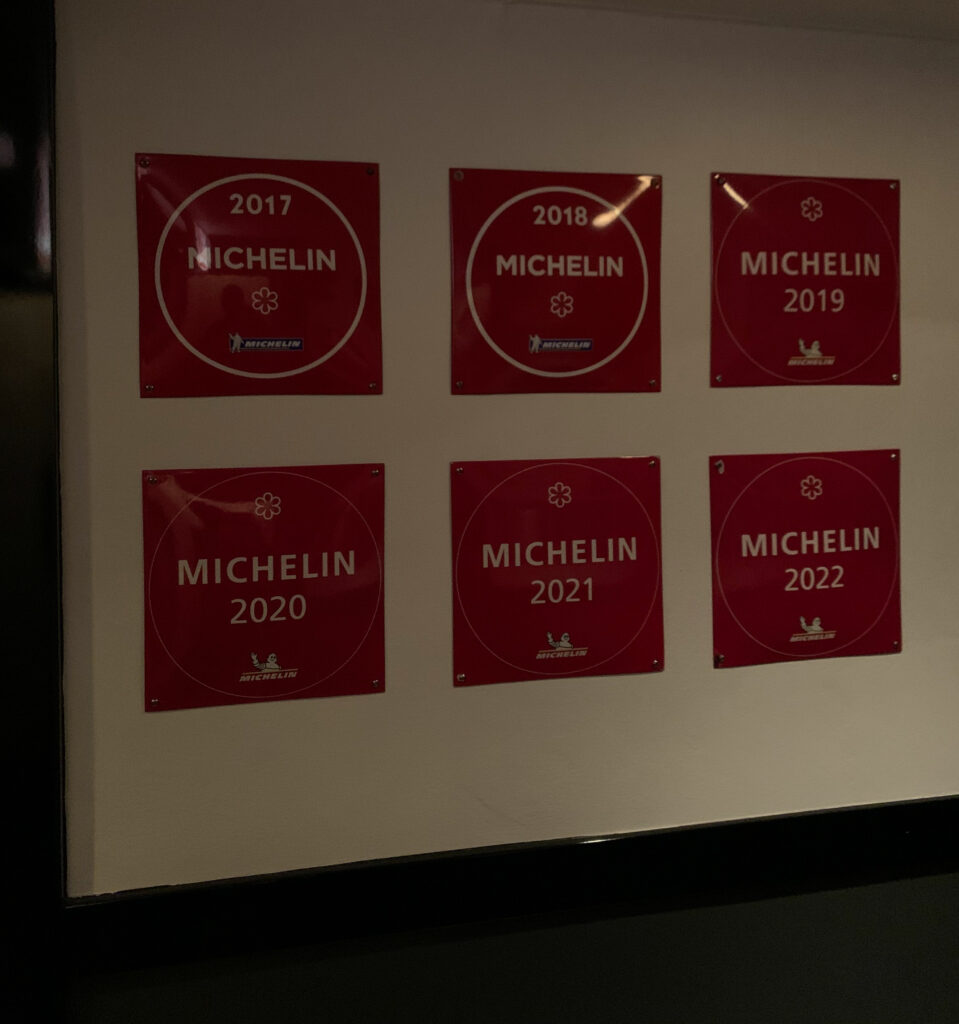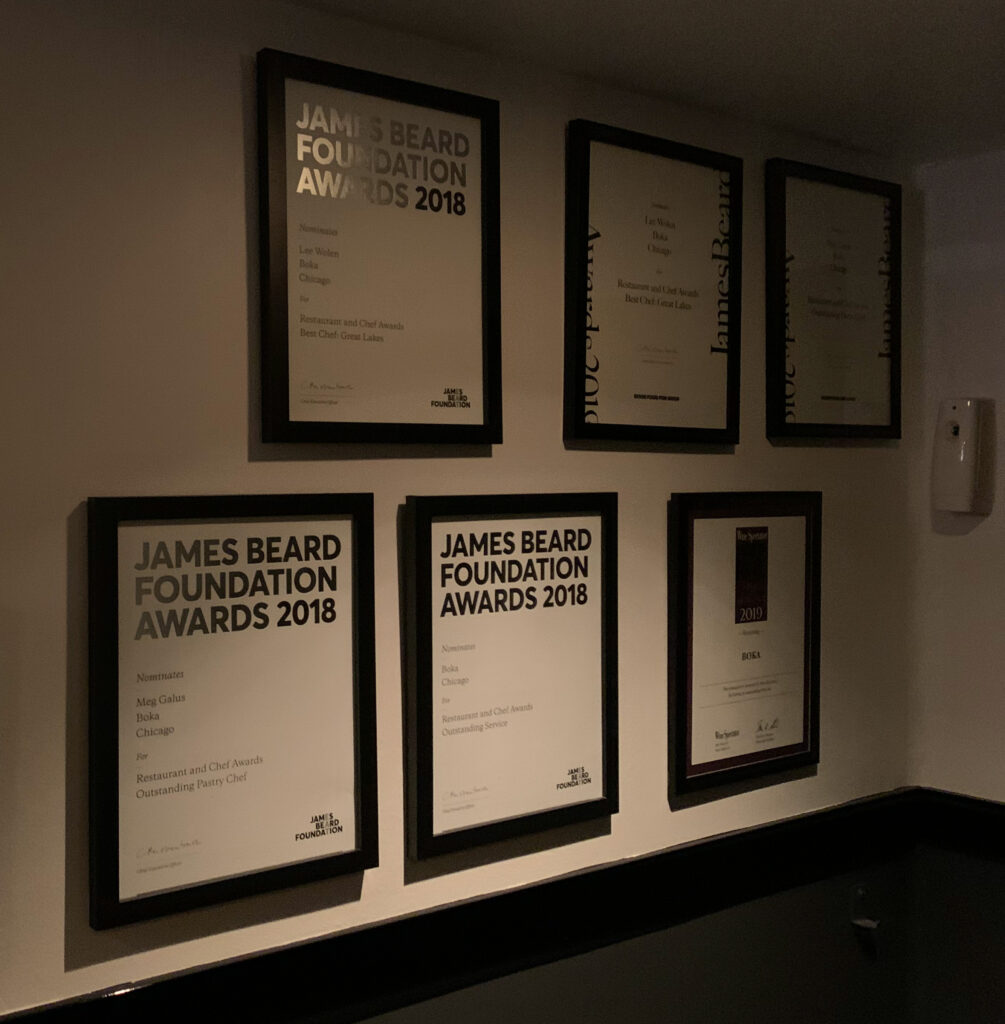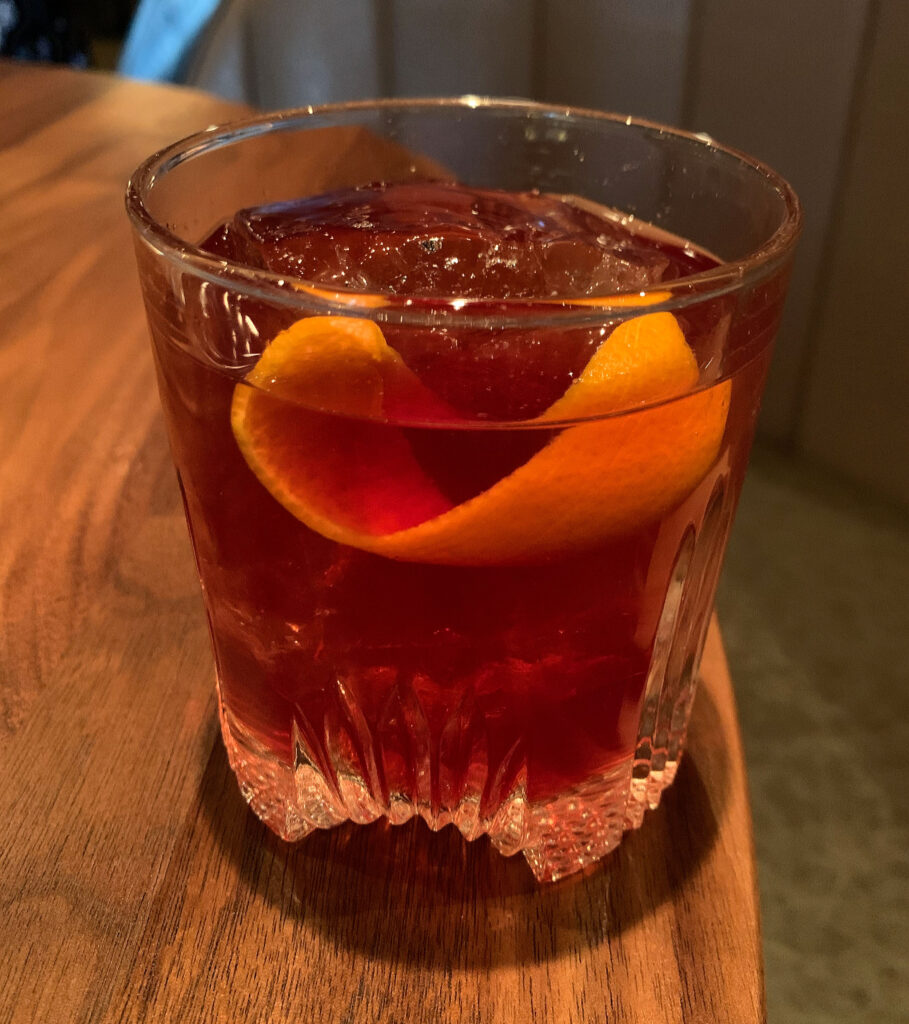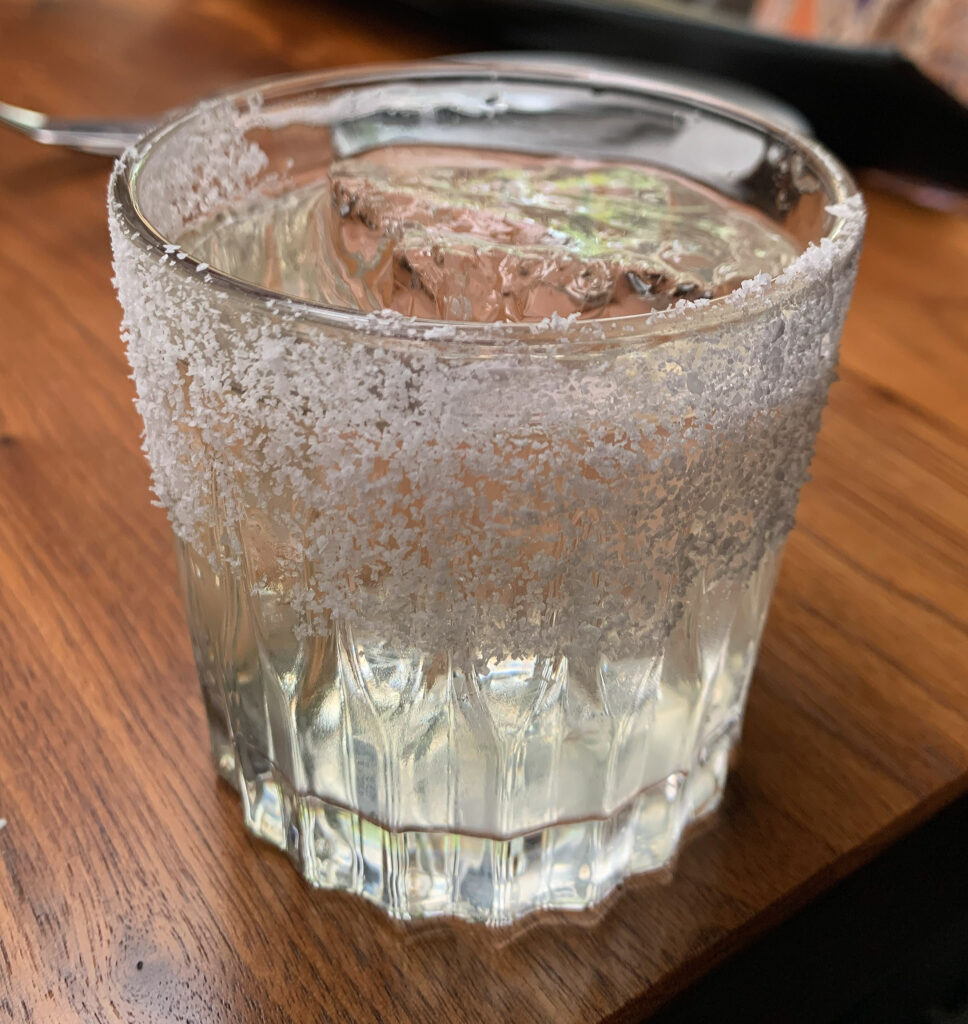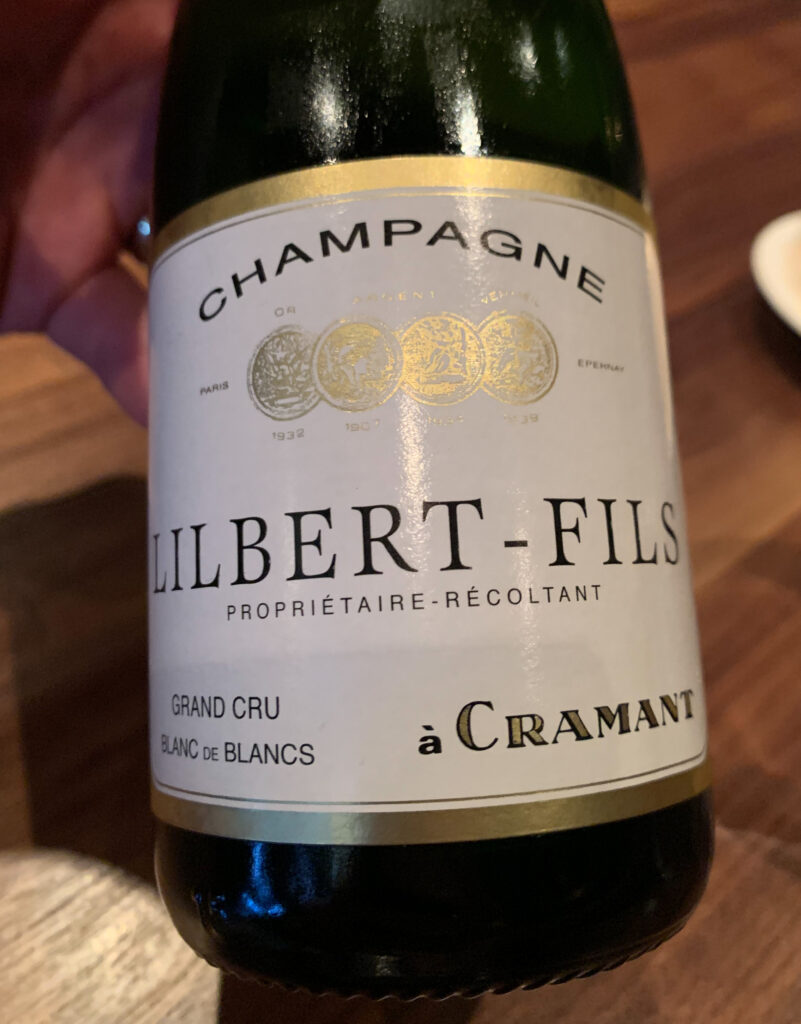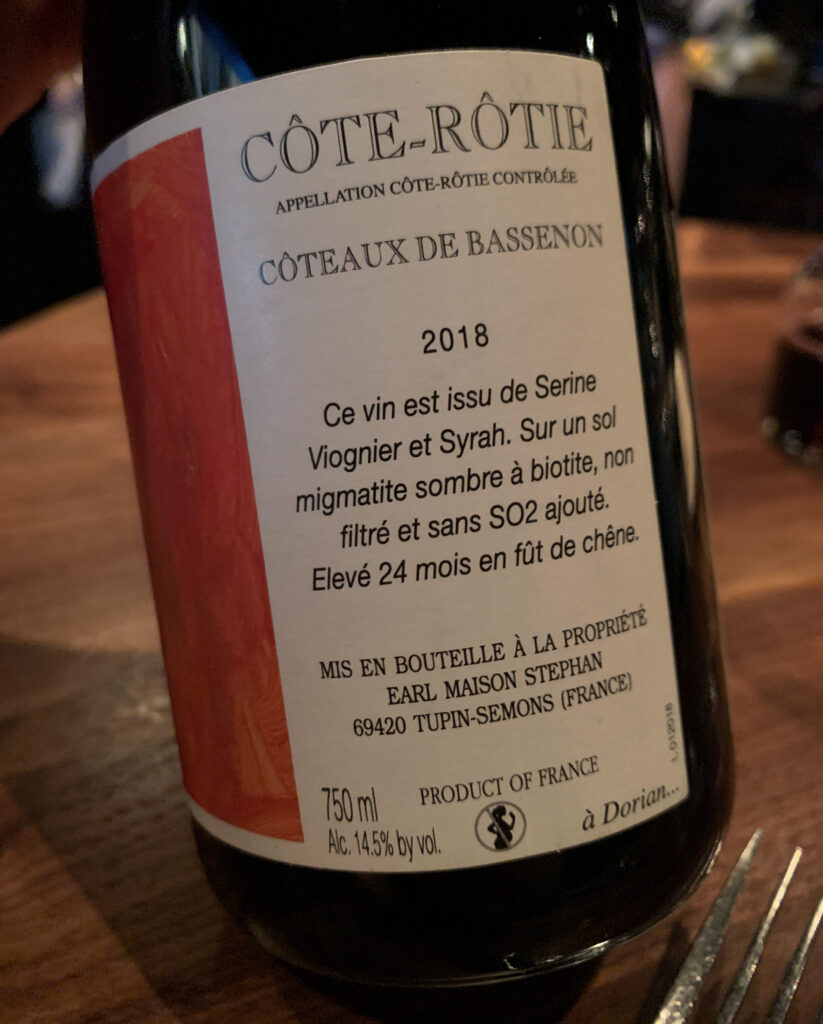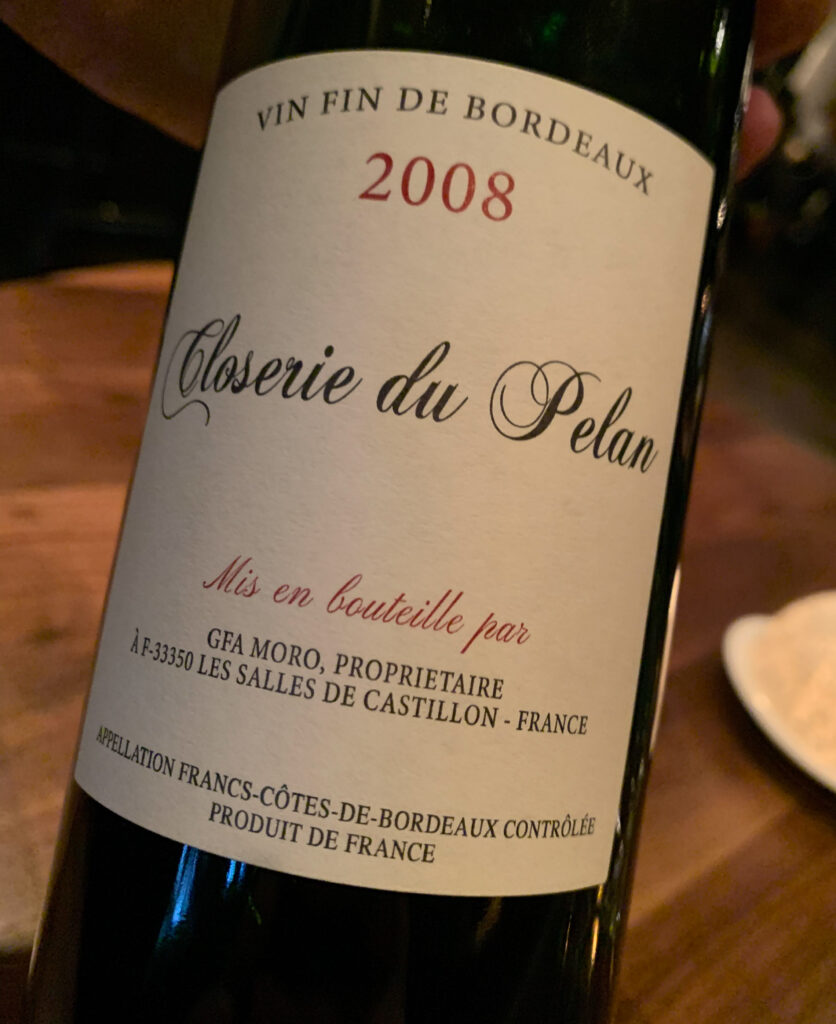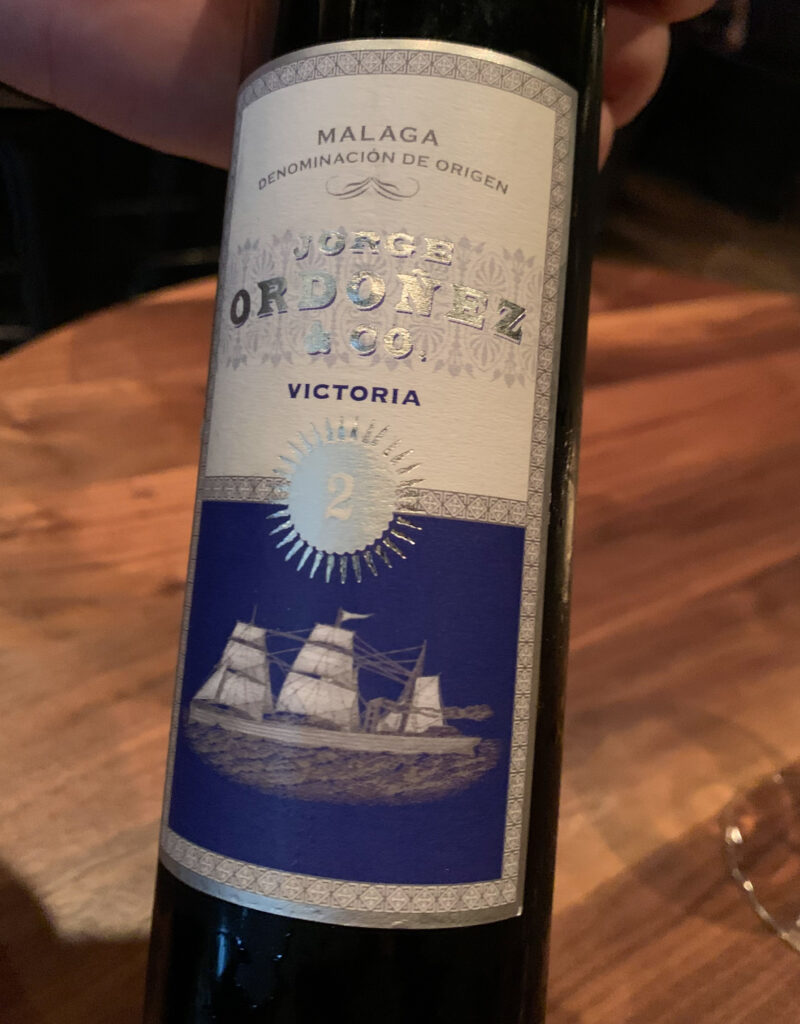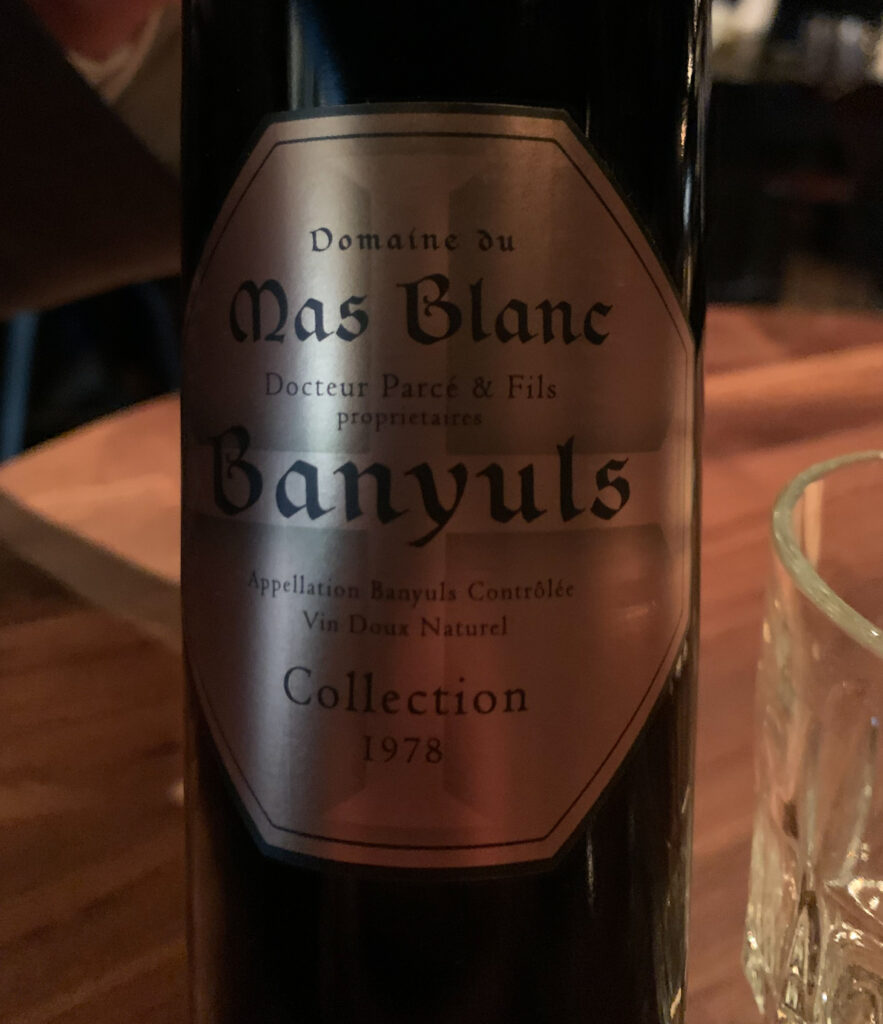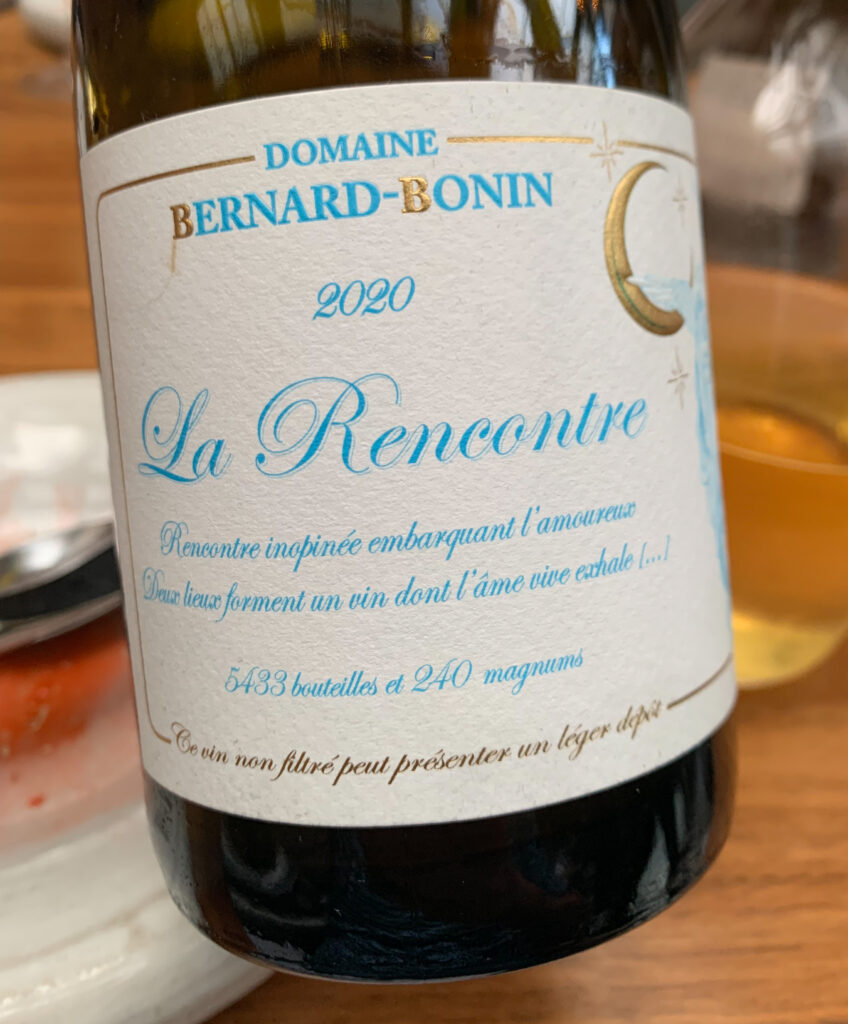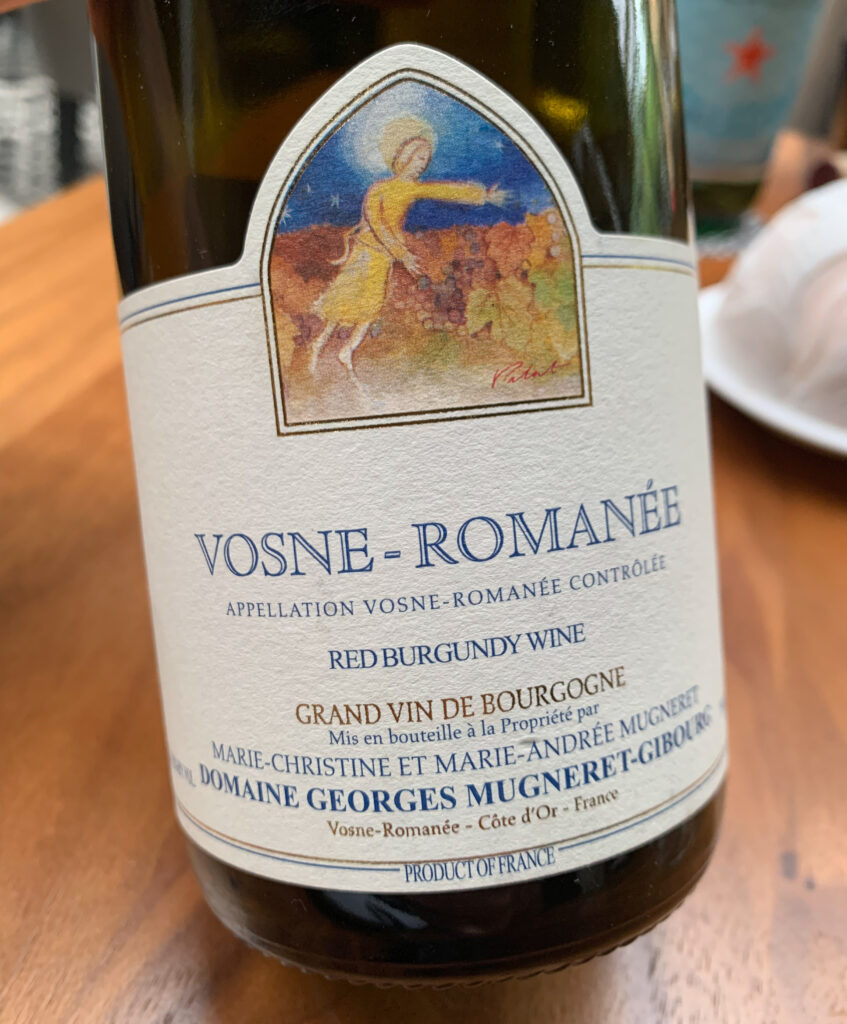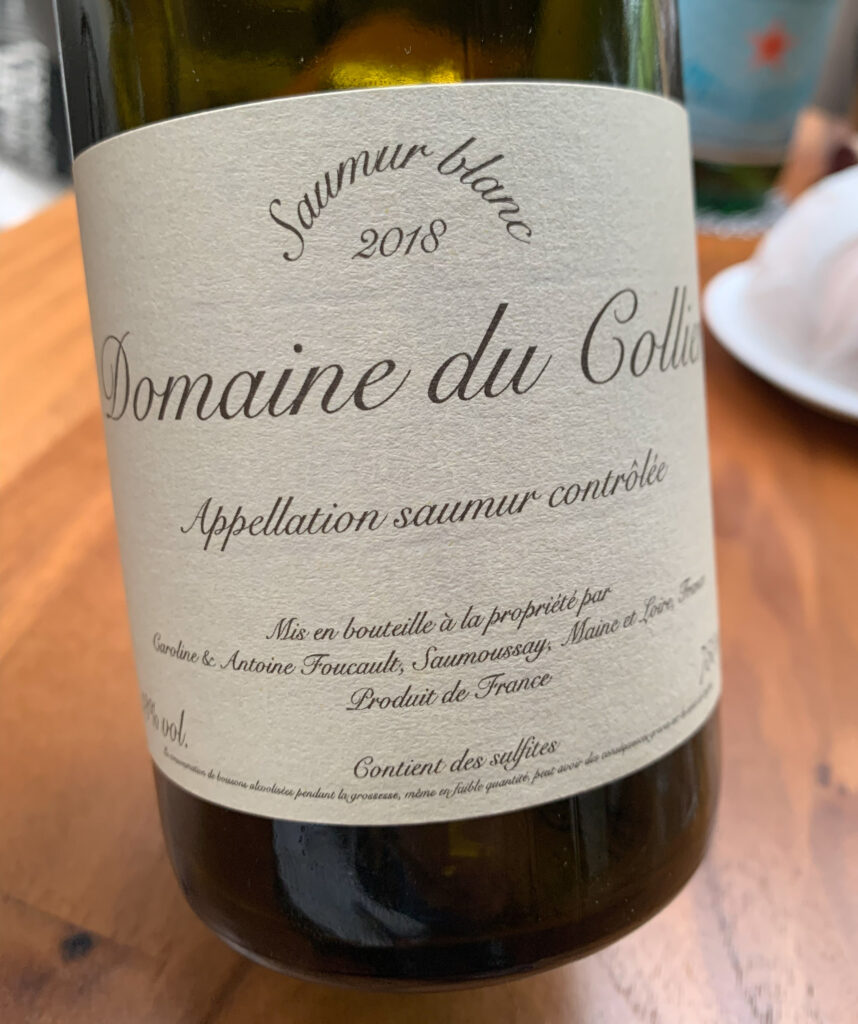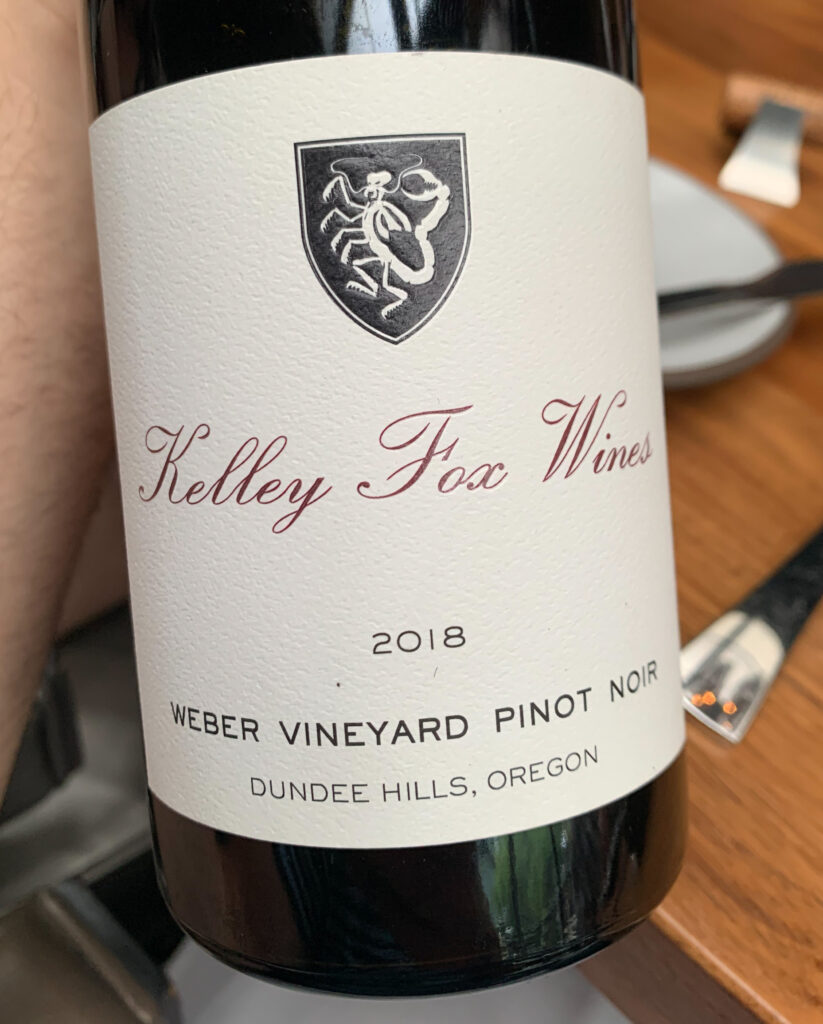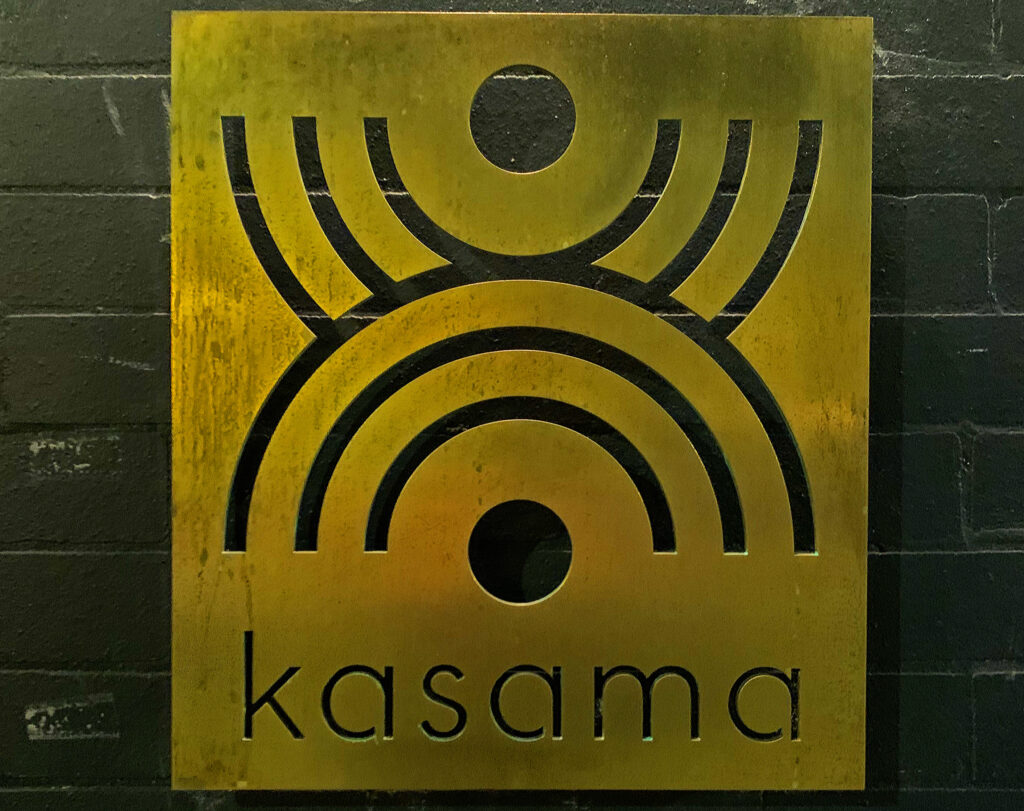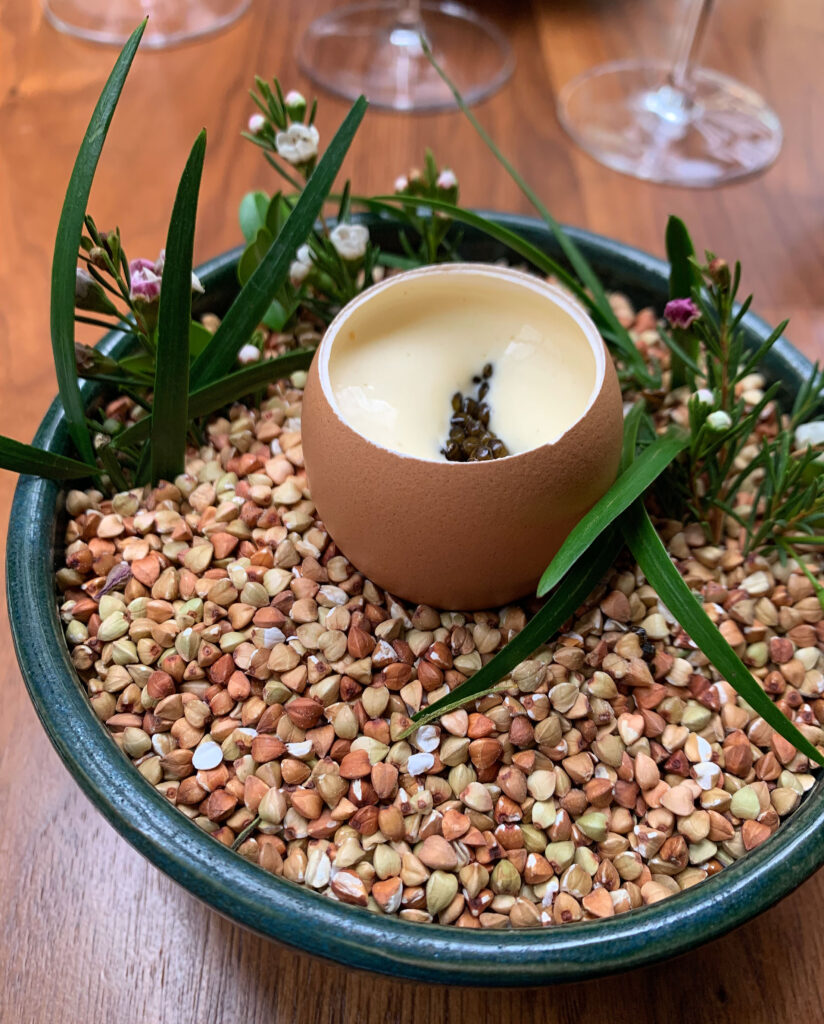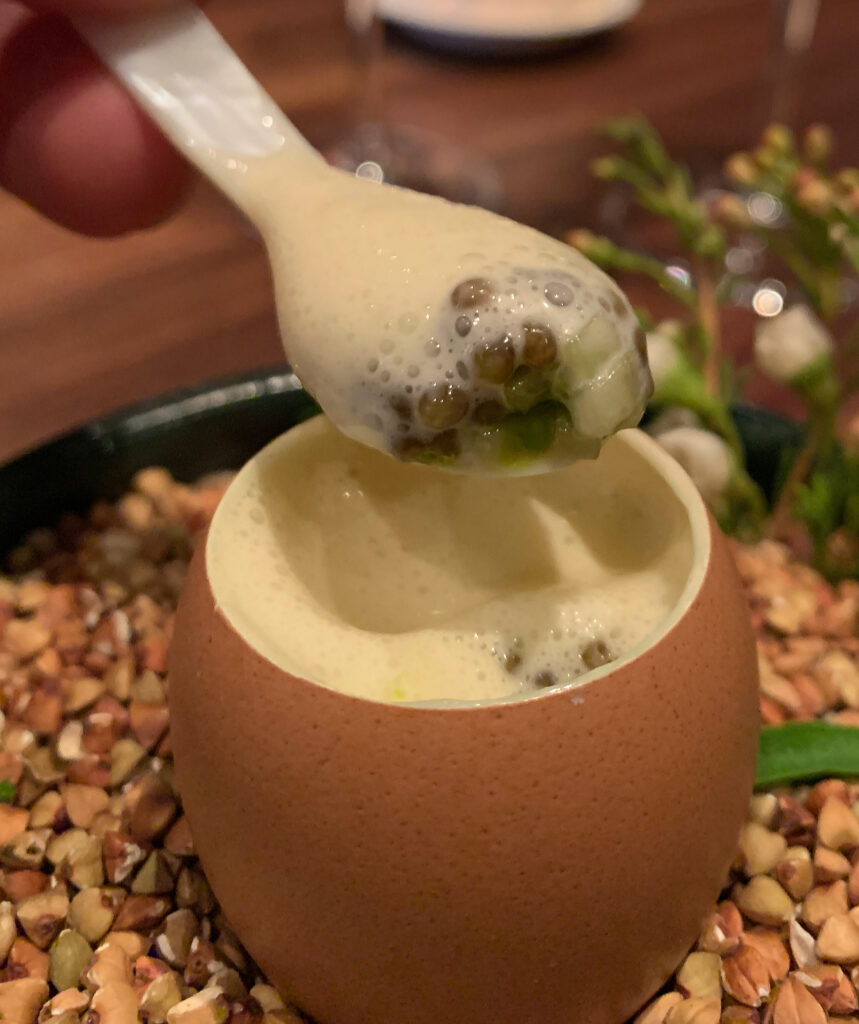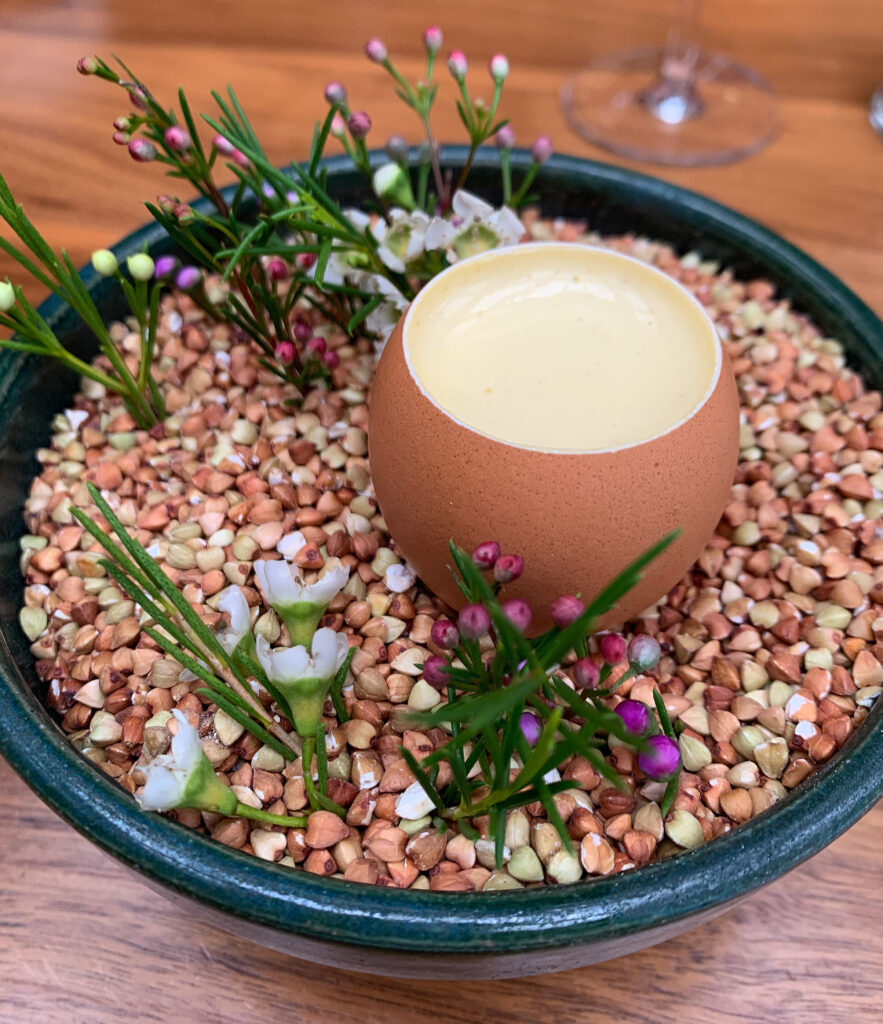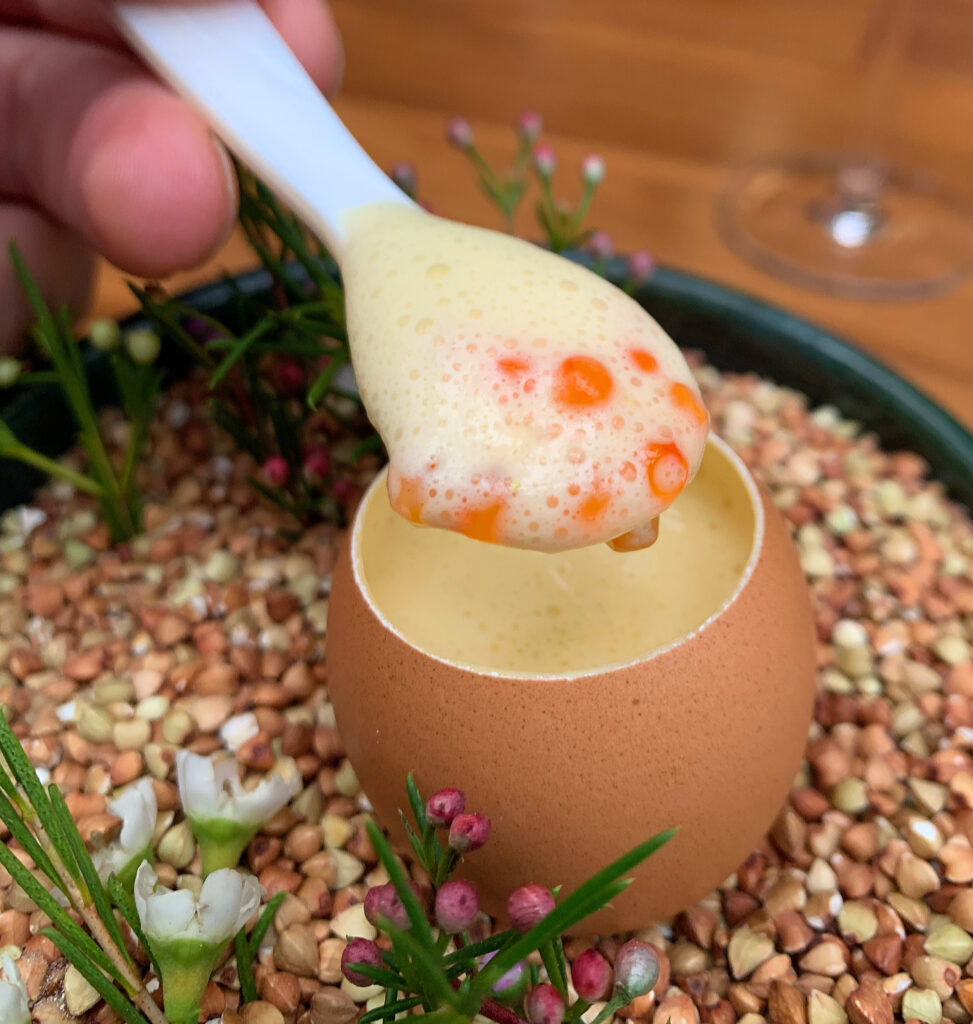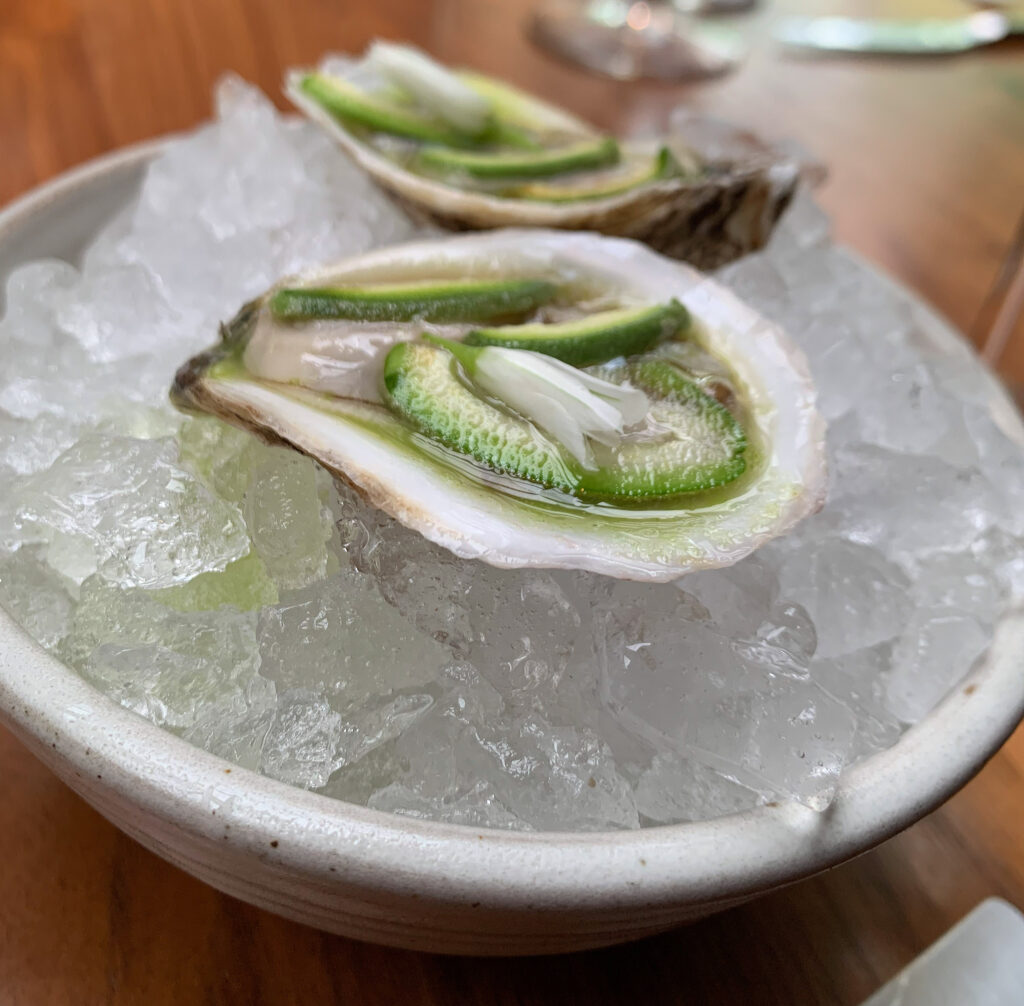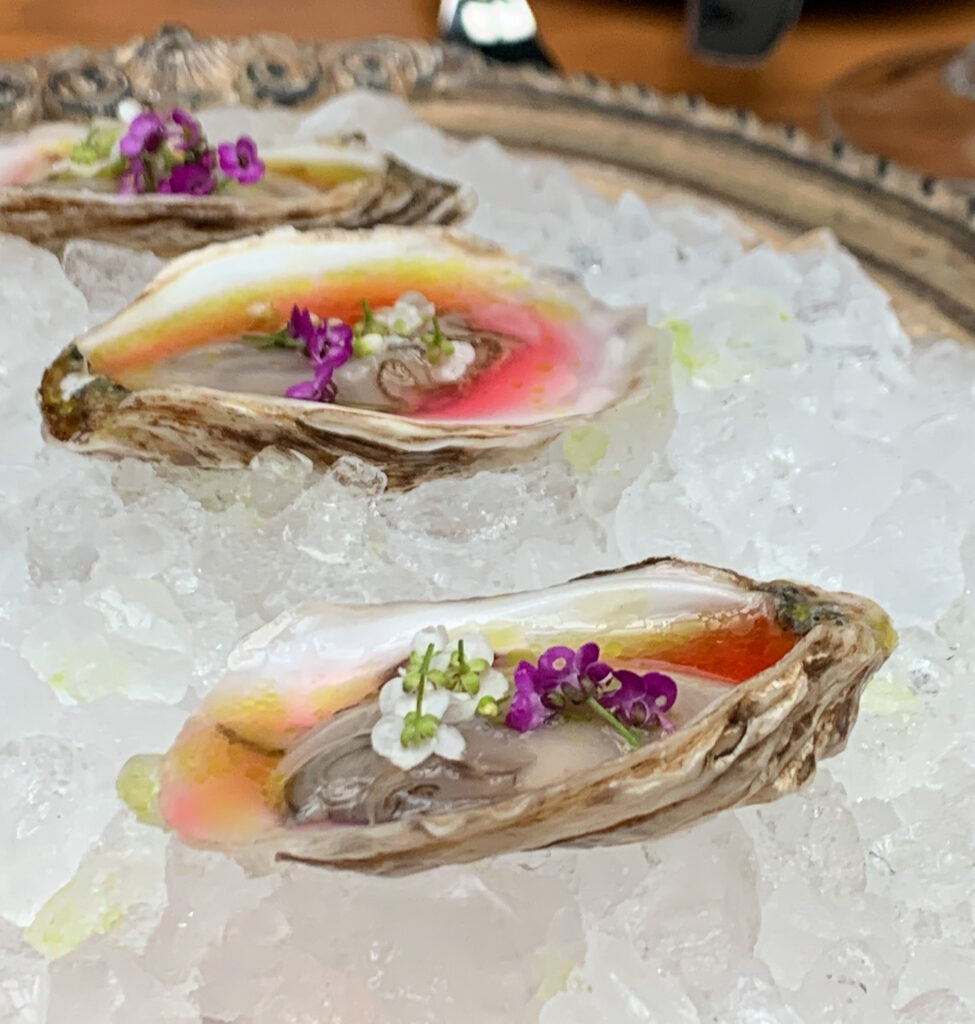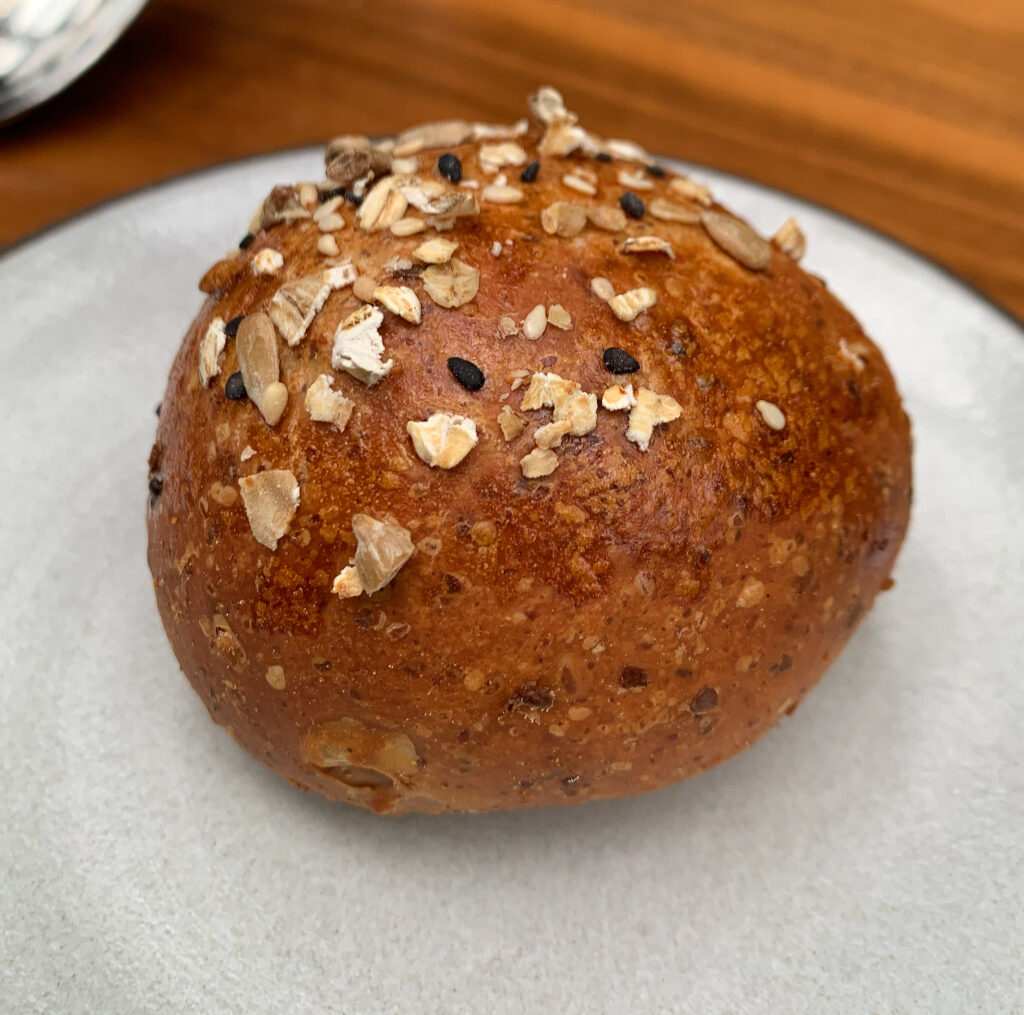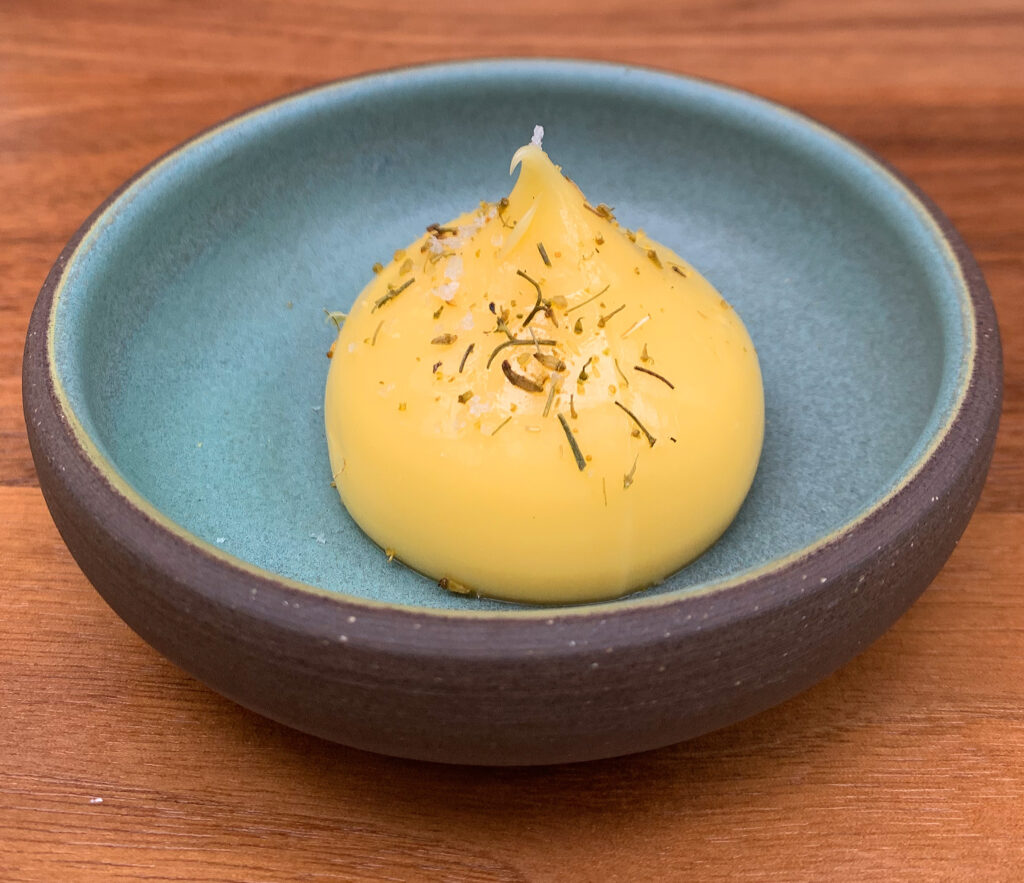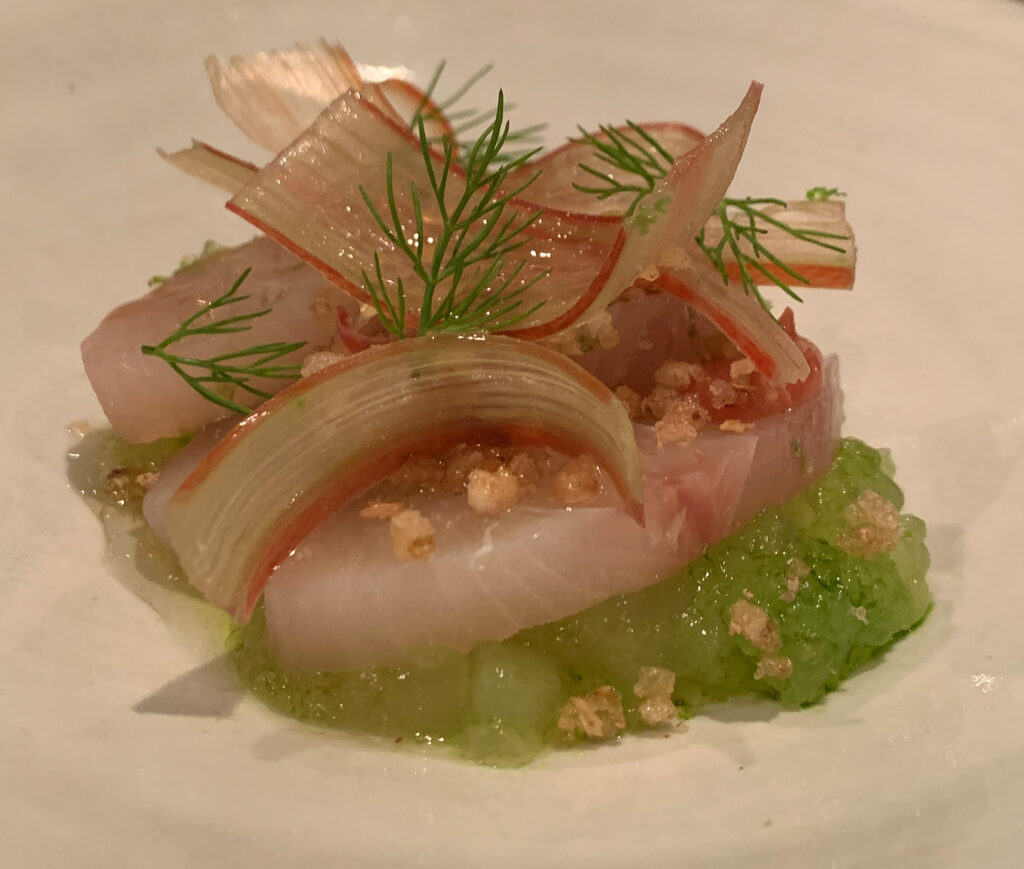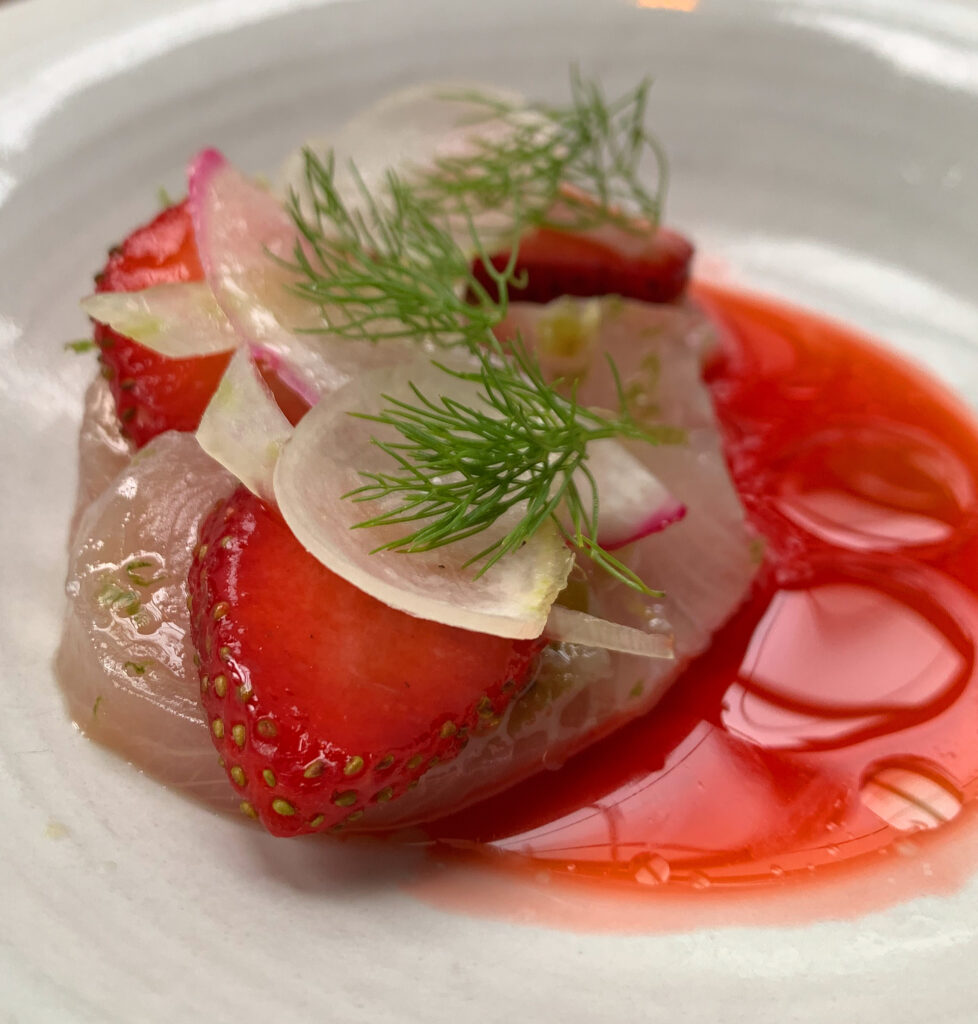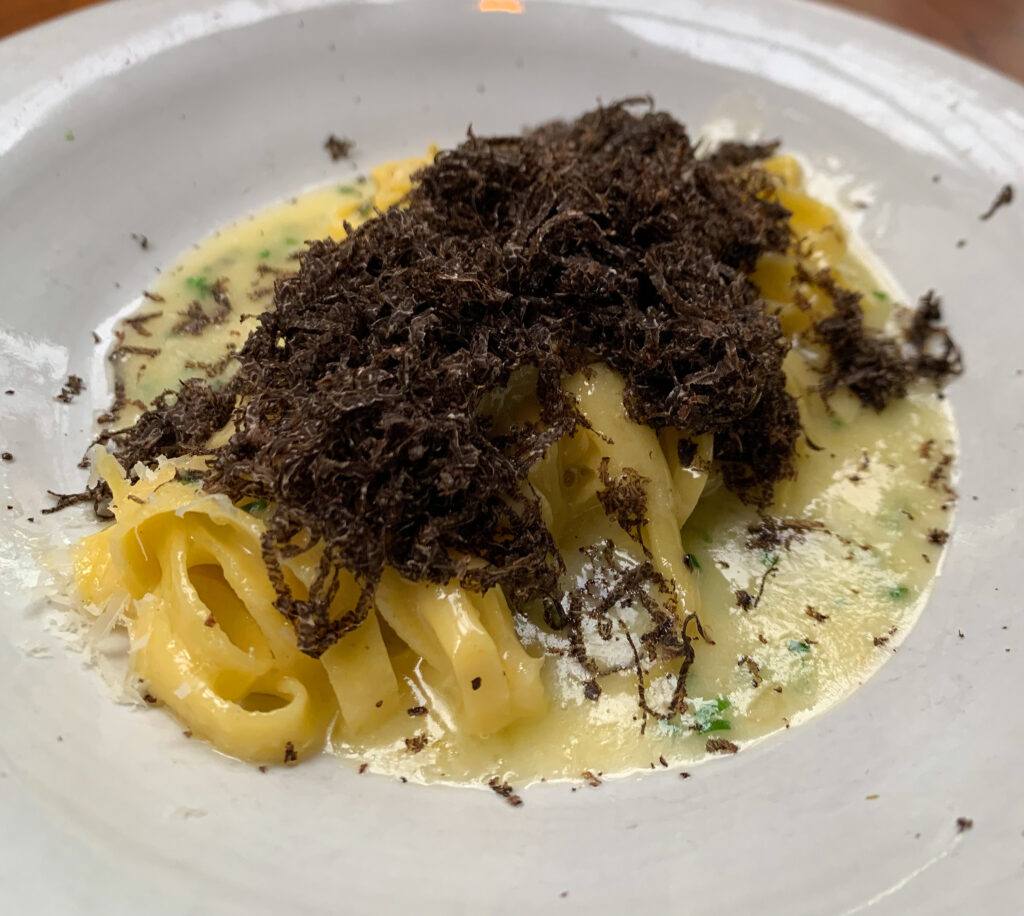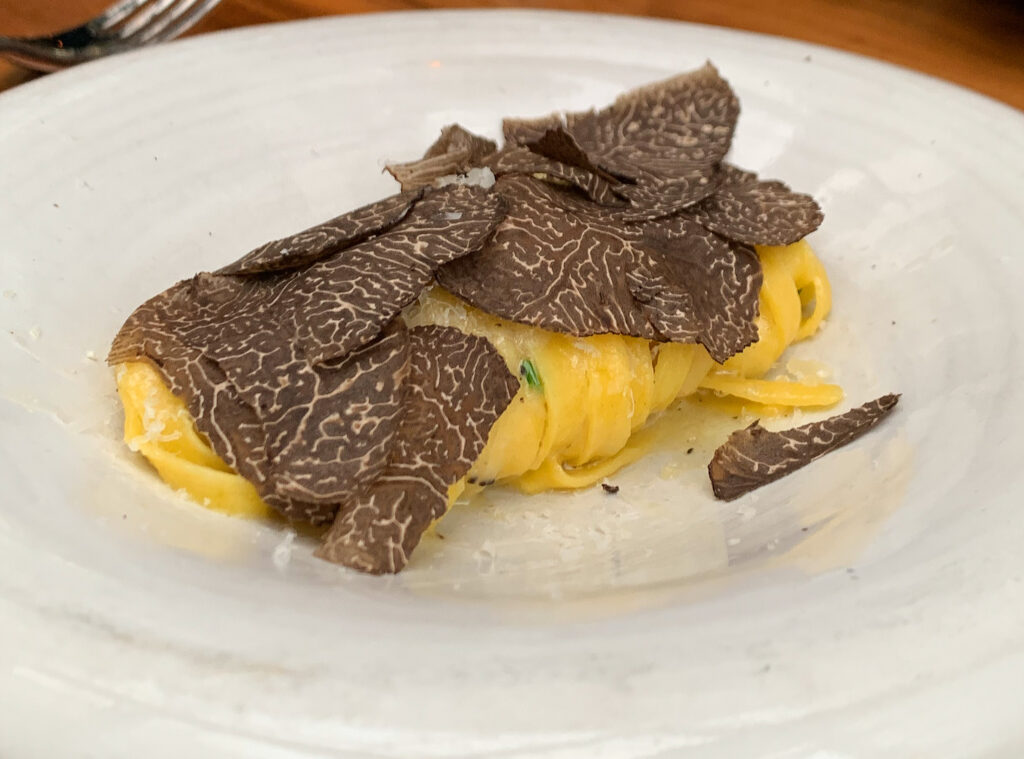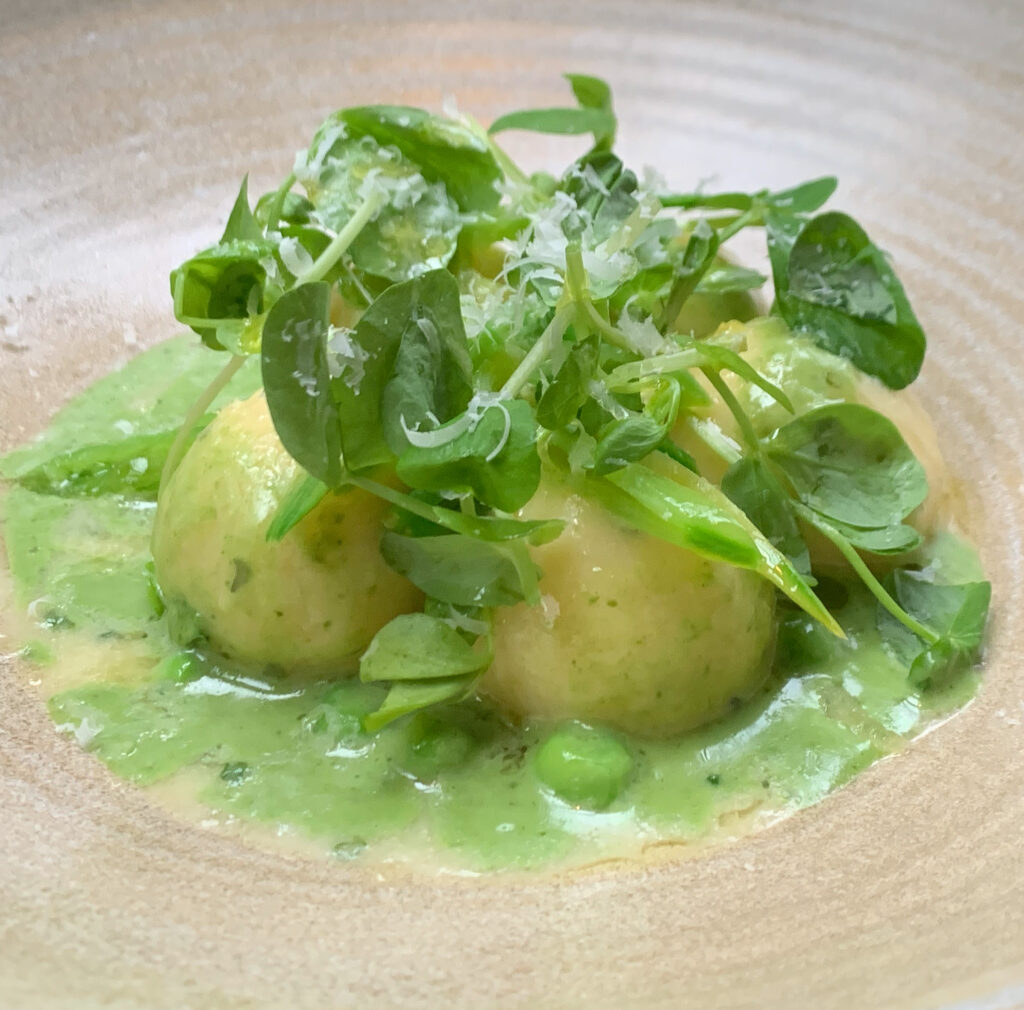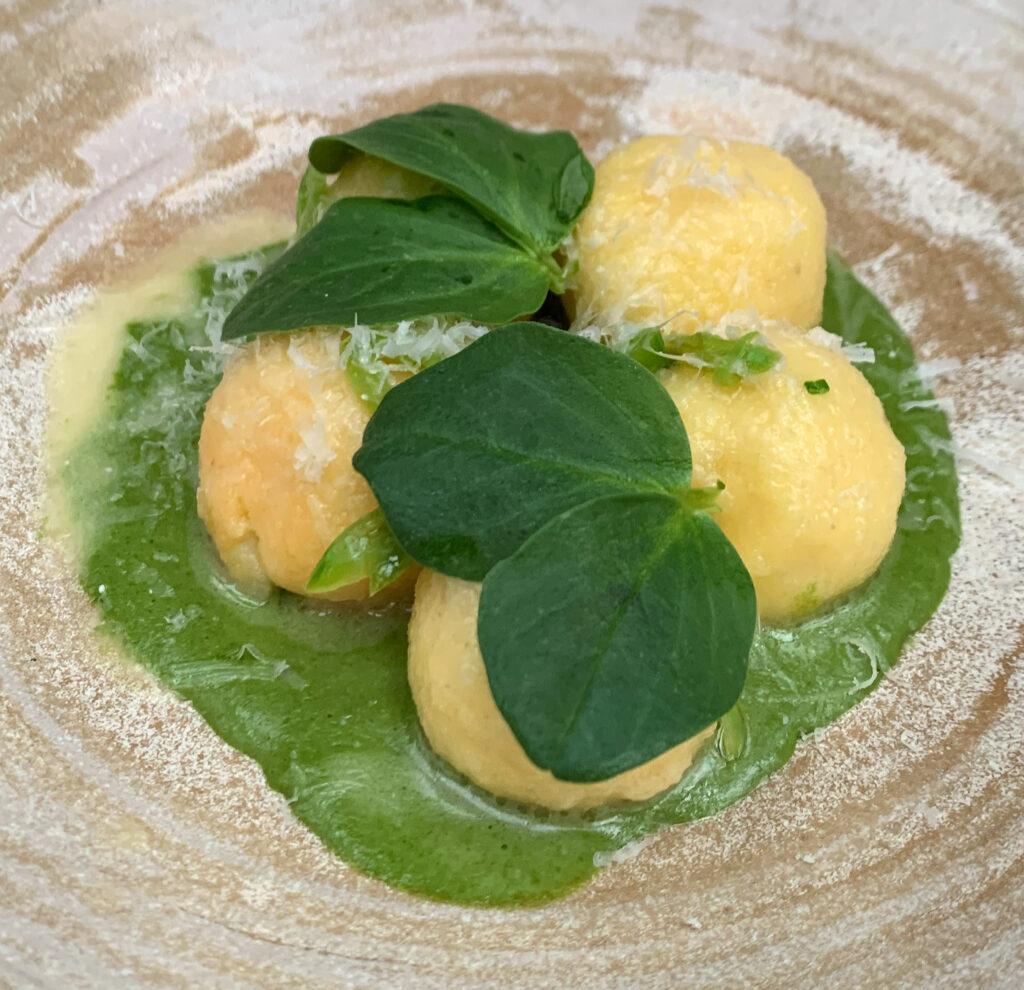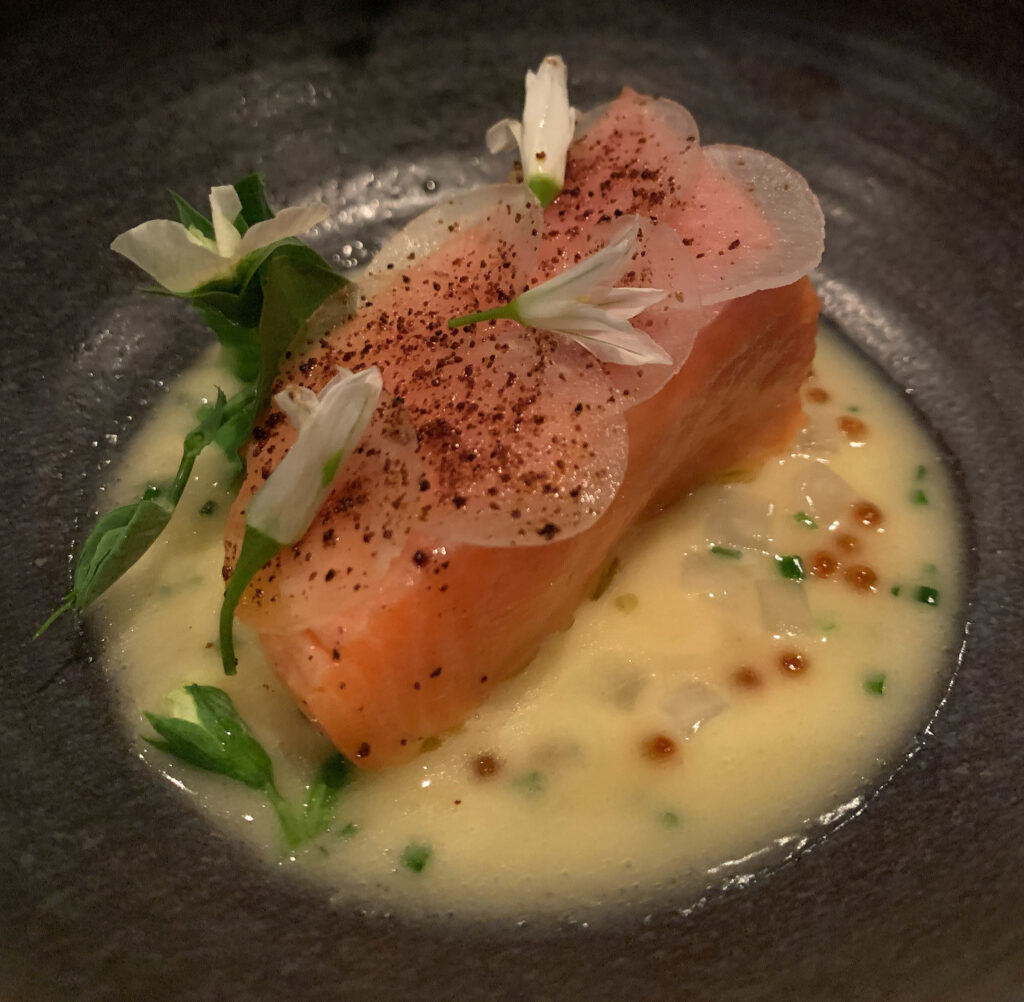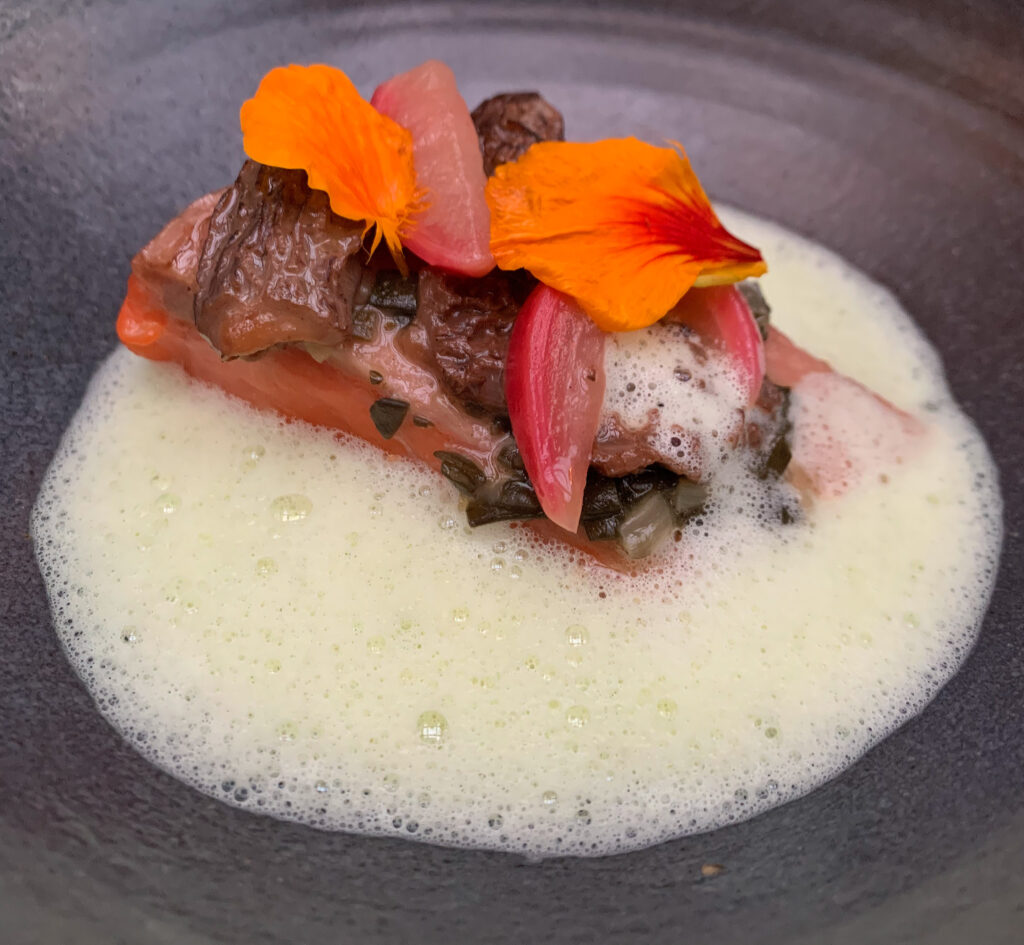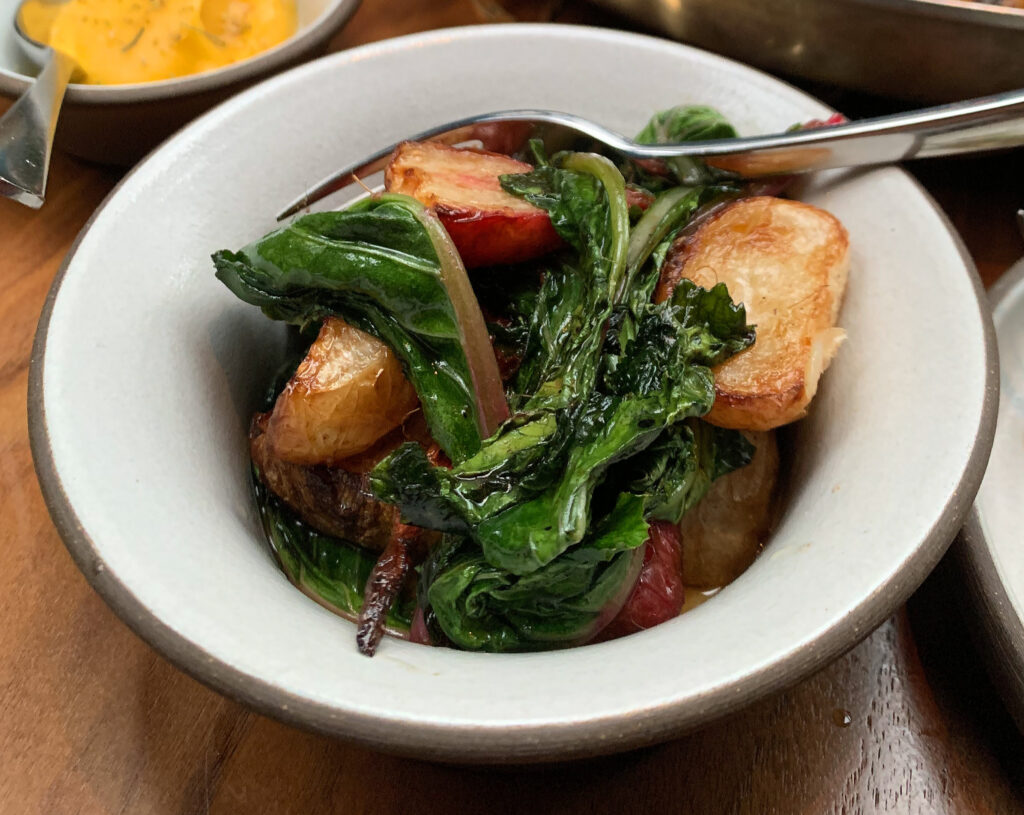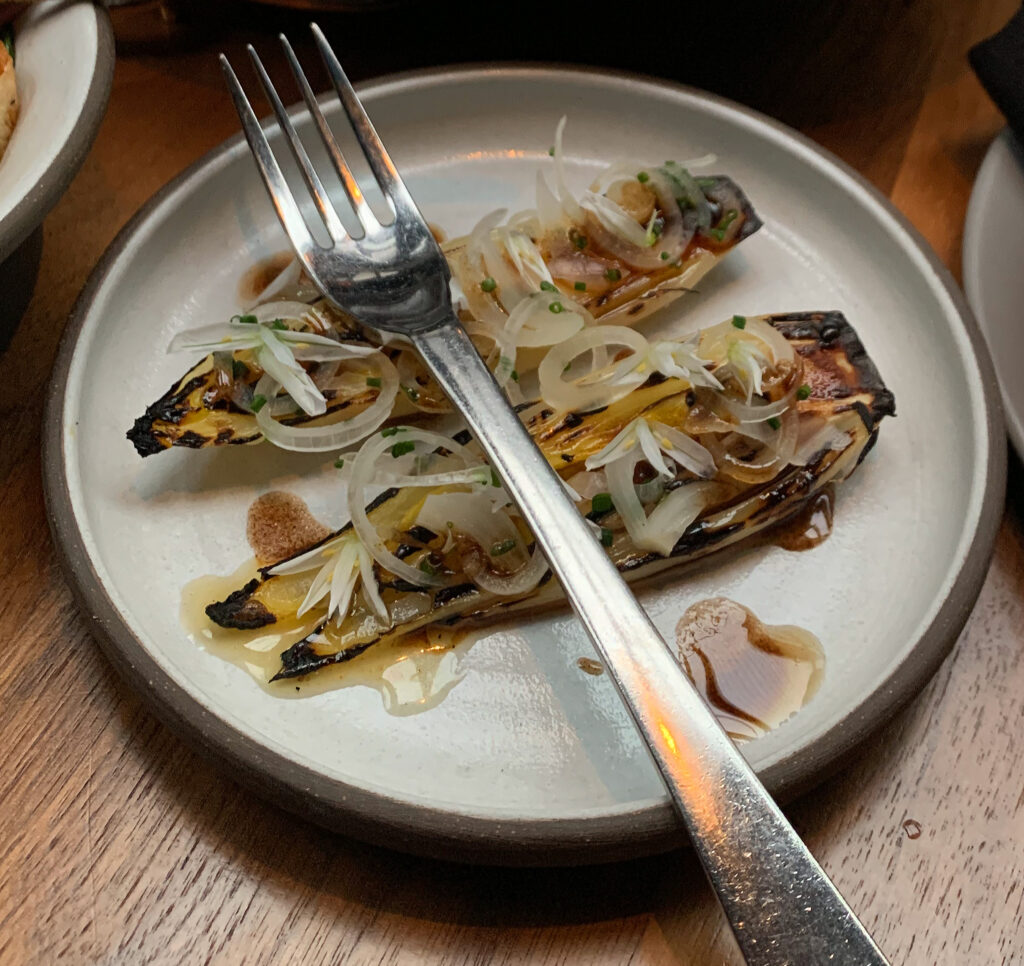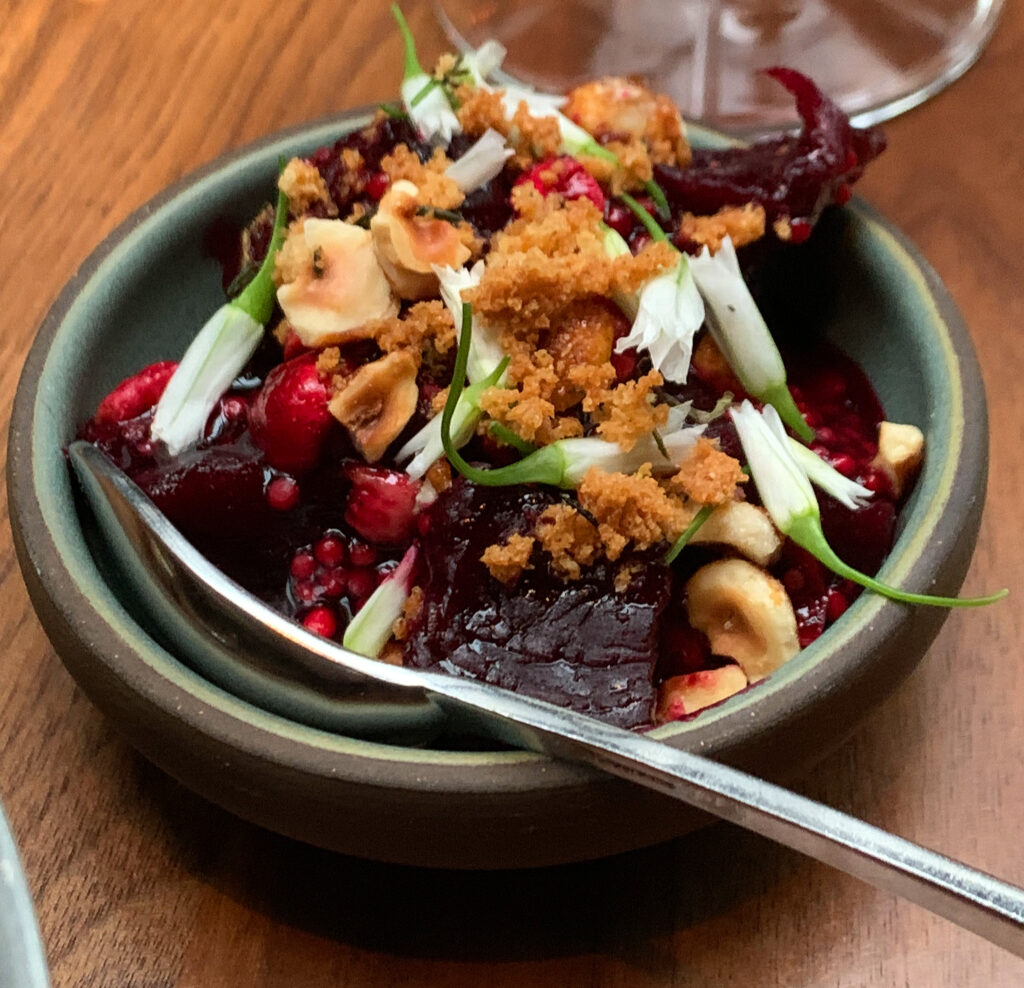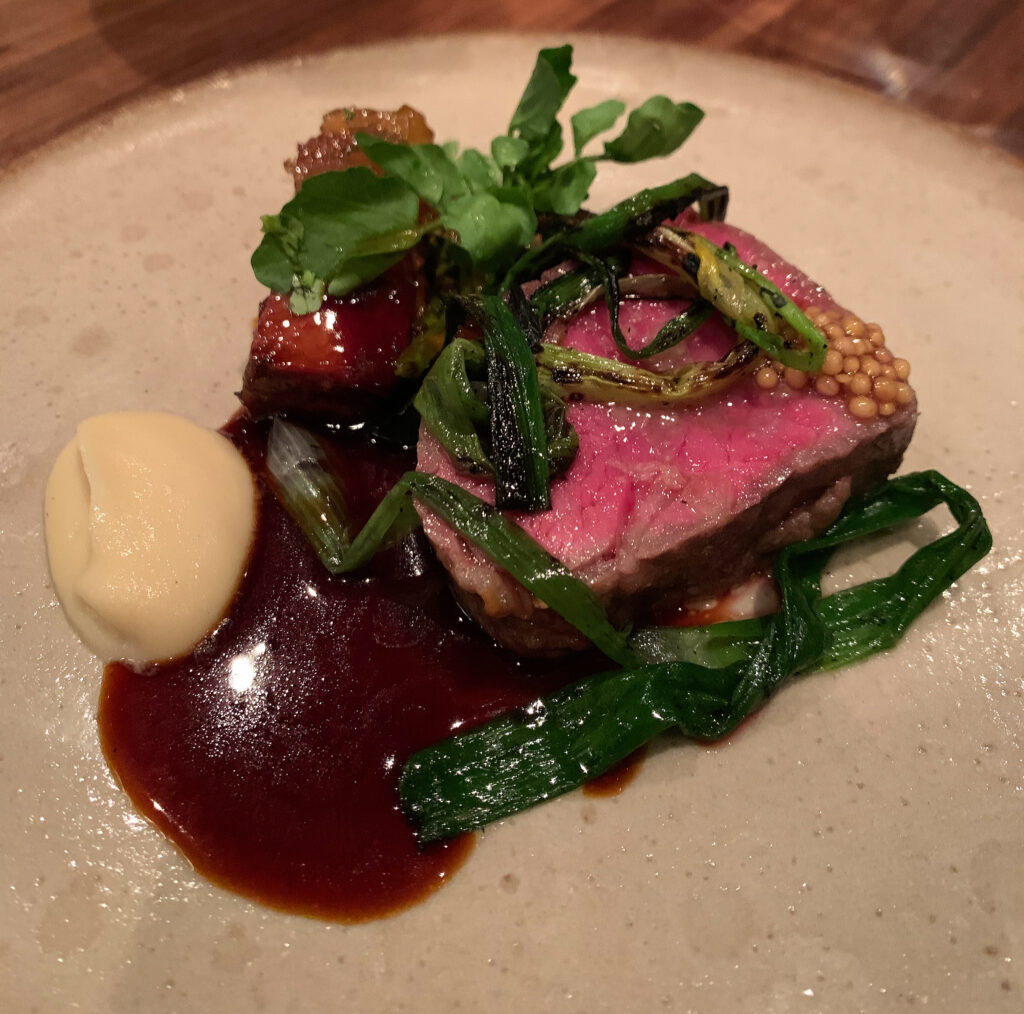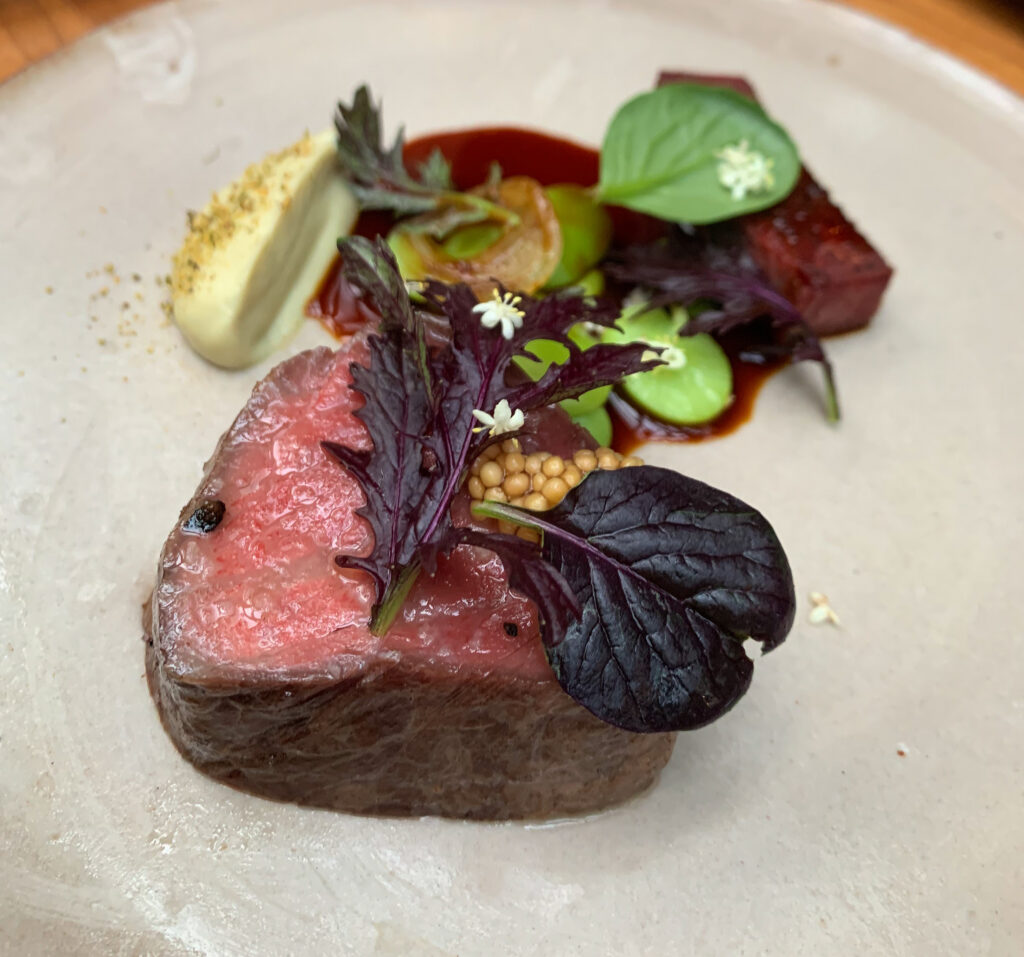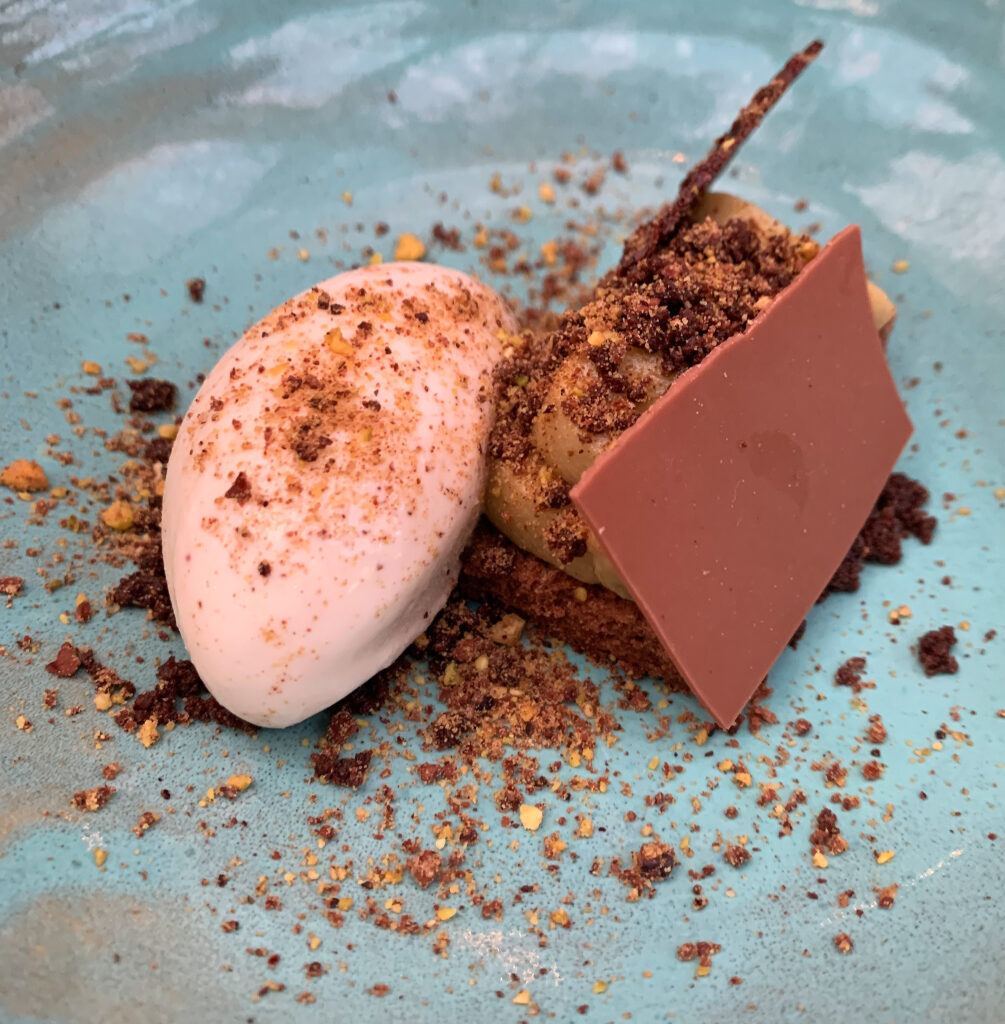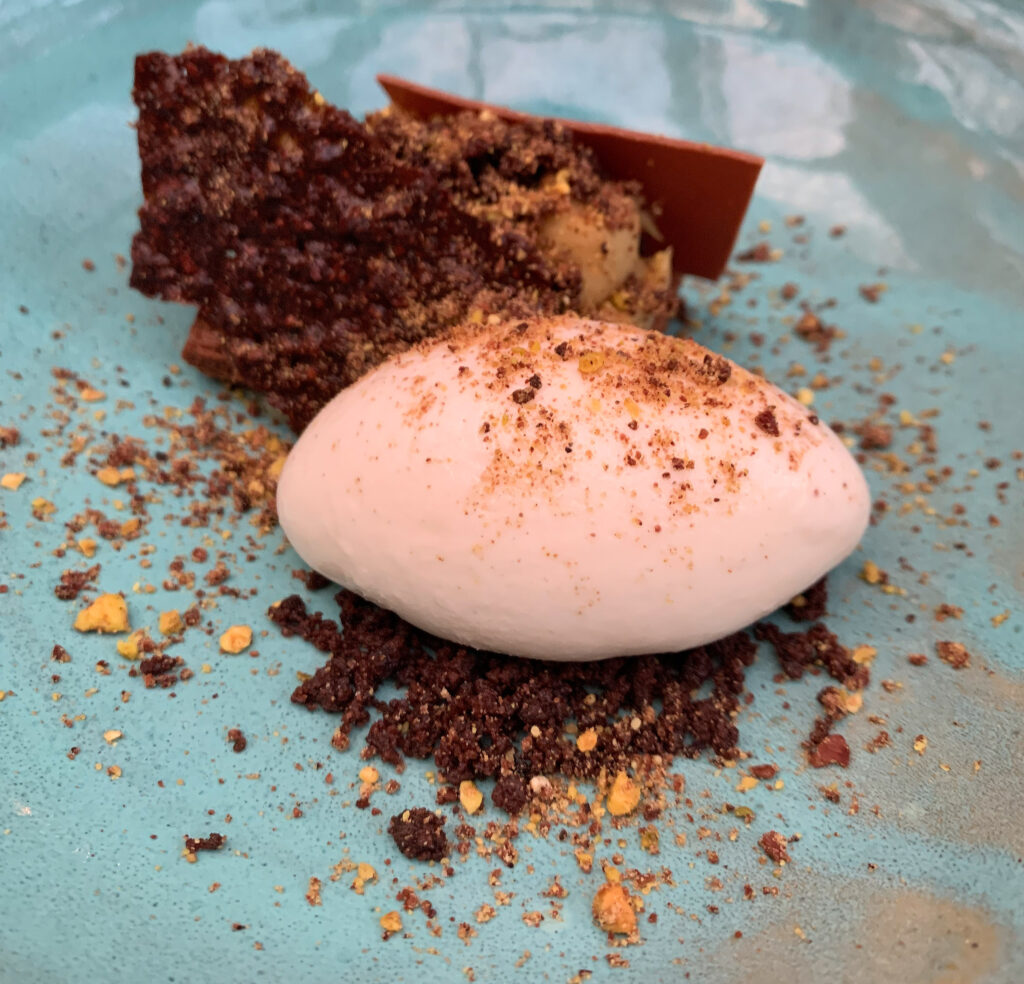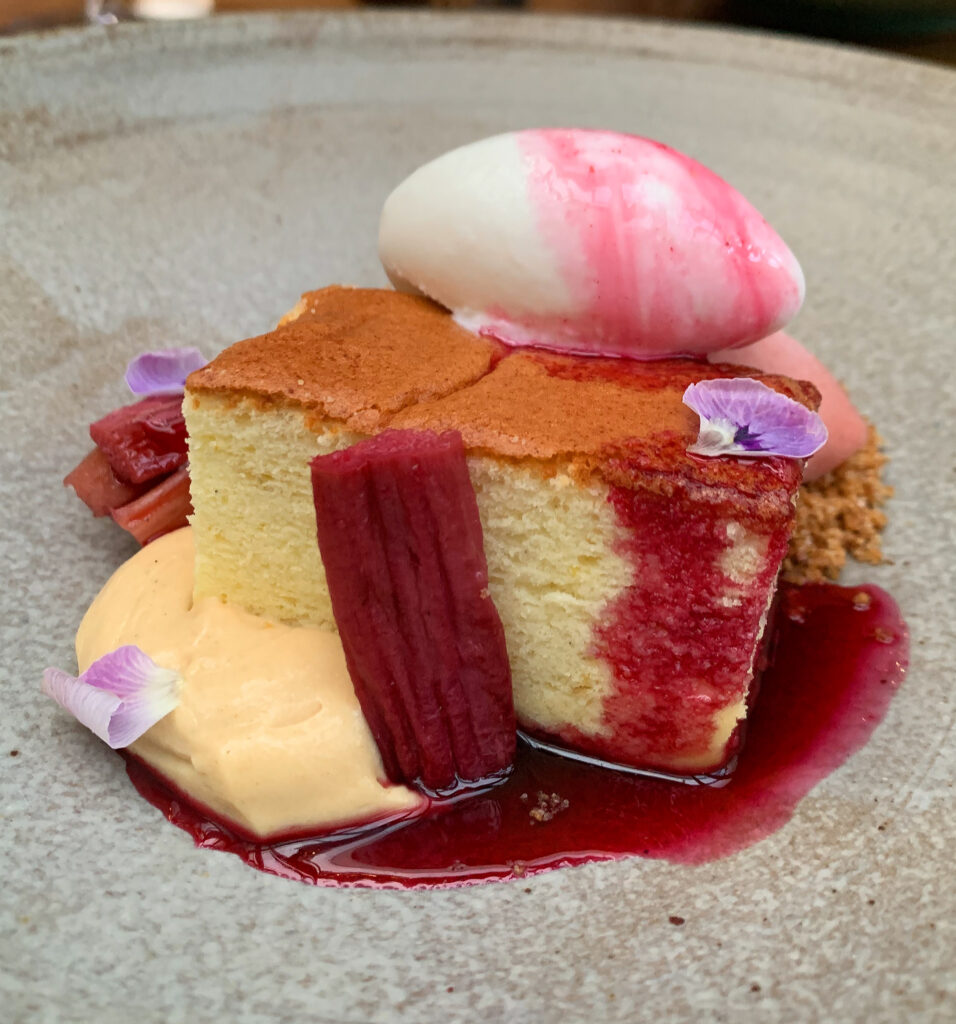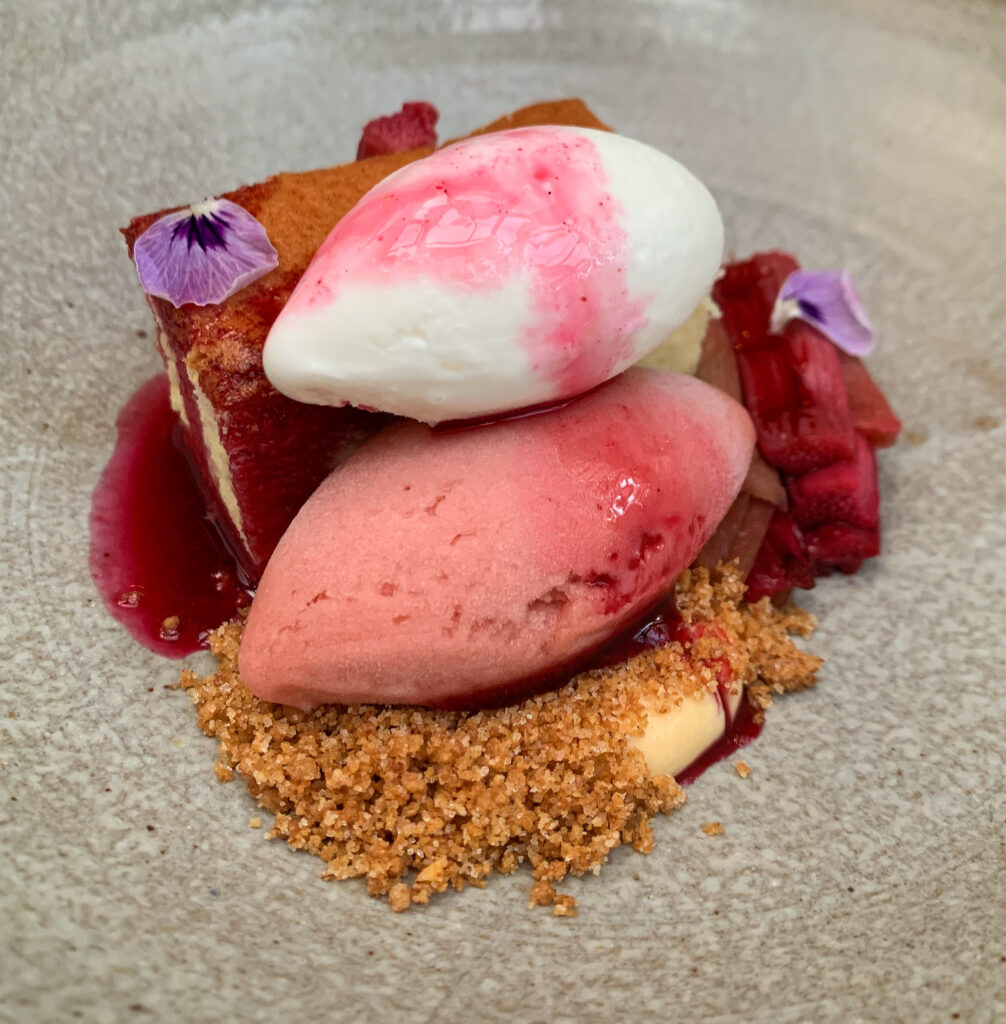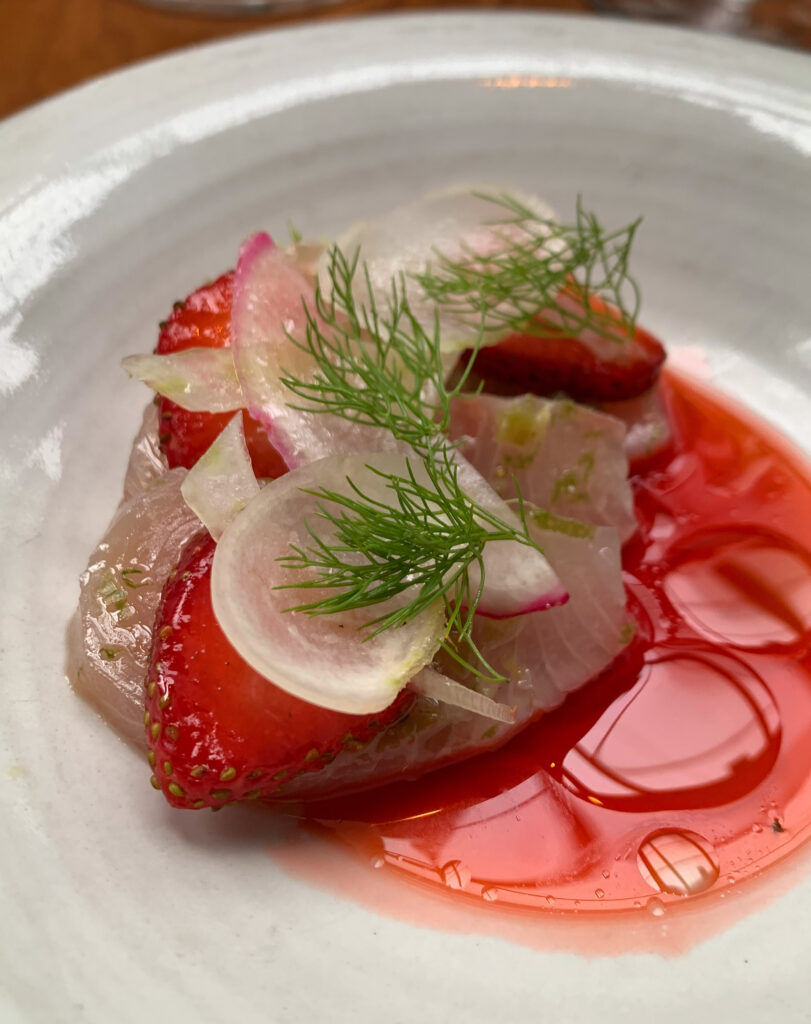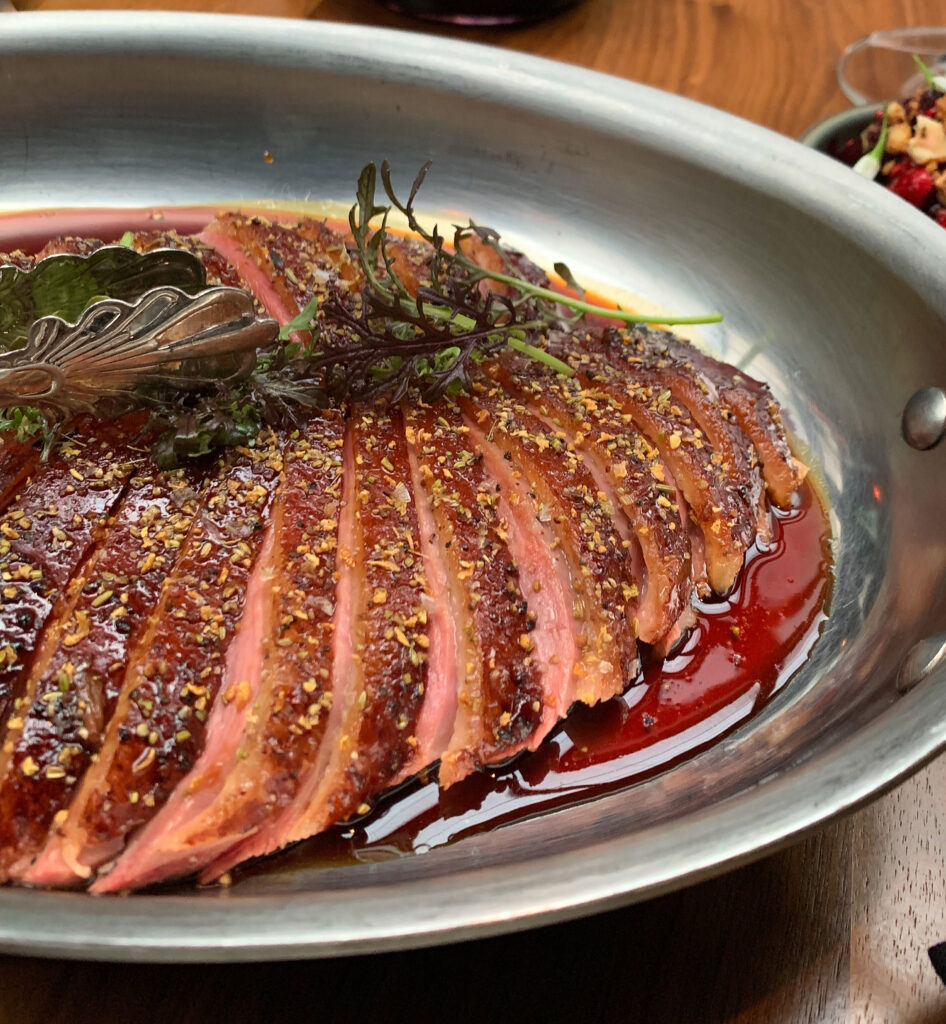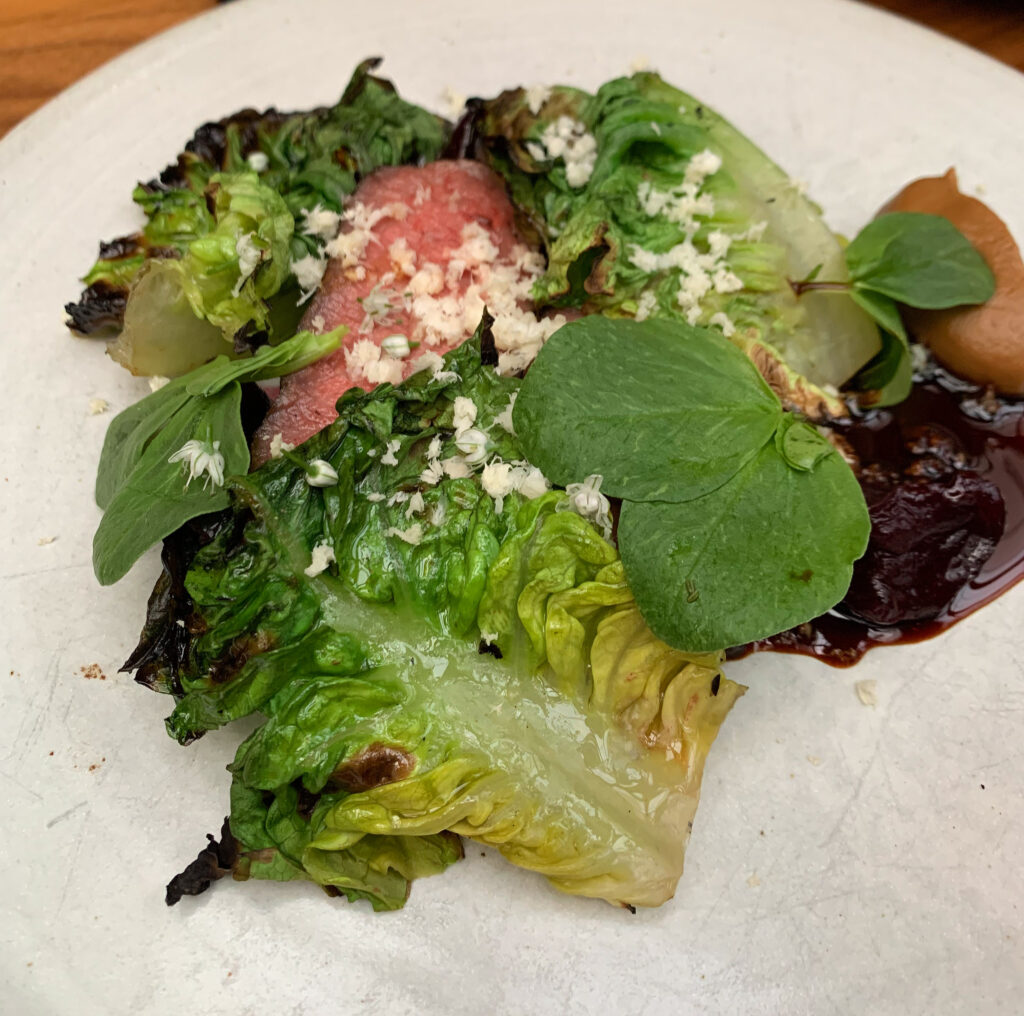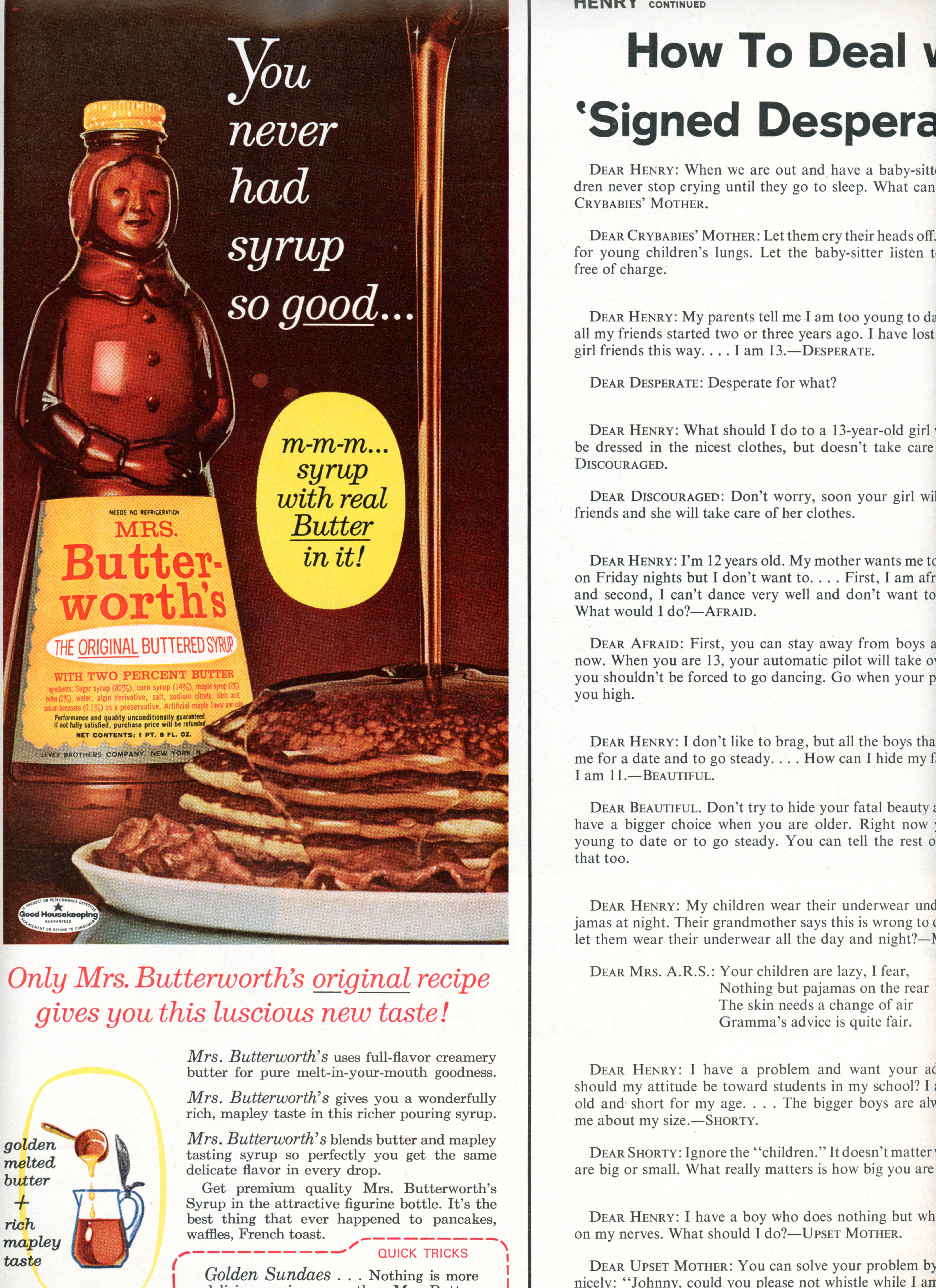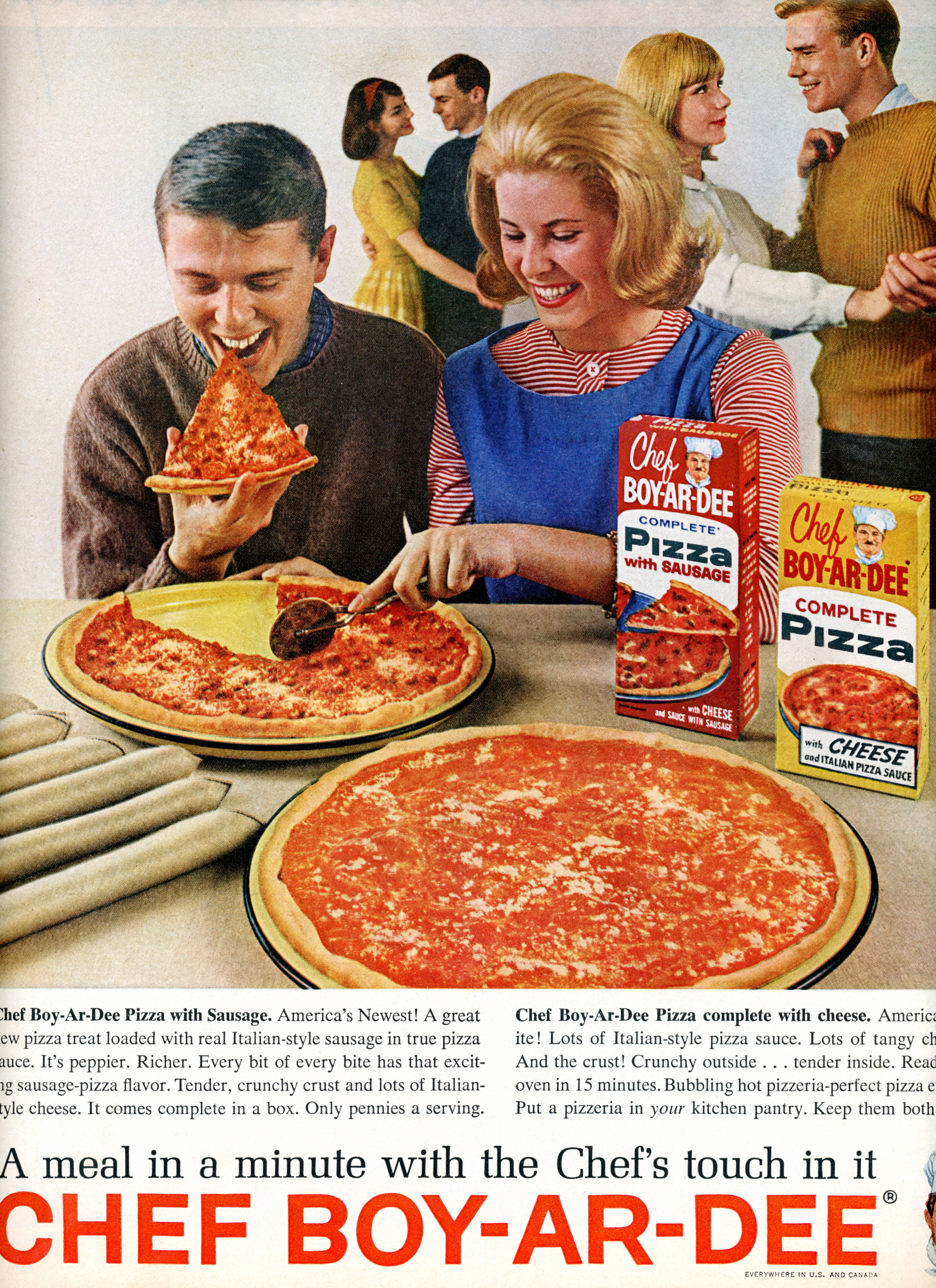You have minced few words regarding Boka Restaurant Group over the years, particularly when it came to the demise of Bellemore and that restaurant’s replacement by the decidedly tepid Alla Vita. Back then, BRG founders Kevin Boehm and Rob Katz were still fresh off the back of their 2019 James Beard Award for Outstanding Restaurateur(s), having beaten Hugh Acheson, JoAnn Clevenger, Ken Oringer, Alex Raij, Eder Montero, and Ellen Yin to take home the prize on their fourth attempt. But, rather than channeling that national affirmation toward developing the finest concepts Chicago had ever seen, the Boka honchos seemed set to ease up and cash out.
Sure, there was a pandemic to contend with somewhere along the way: decisions—hard ones—were made and the BRG portfolio of properties suffered the same exodus of talent that touched groups of greater size and restaurants of greater acclaim alike. Crown jewels like Girl & the Goat, formerly the kind of concept that defined the city’s dining scene, came back floundering. Izard’s eatery, as proclaimed by Adrian Kane (in what amounts to an all-too-rare critical reevaluation of Chicago’s sacred cows), was “no longer a must-visit.” Yet, from this decrepit state (perceivable long before the article in question), Boehm and Katz went ahead with a Los Angeles edition of the concept in 2021. The opening drew an even harsher review from one of Kane’s colleagues, and you wondered whether Izard and her backers would tank the Windy City’s gastronomic reputation out West.
Nonetheless, your favorite aggregators would reveal that the great mass of mainstream consumers find Girl & the Goat Los Angeles positively charming and that the Chicago branch (while perhaps not quite the impossible reservation it once was) still manages to please the majority of its patrons. As always, a few voices pierce the veil: referencing a lapse in standards that could only be perceived by those who had eaten Izard’s cuisine—and felt the hospitality culture she had conjured—at its peak. Yet those diners are destined to move on, and their seats, primely positioned in some of their respective cities’ most popular neighborhoods, are destined to be taken by a new generation of novelty-seekers that does not know any better.
It may seem like you are nitpicking: complaining how the restaurant that was once “excellent” is now only “good.” However, this is the insidious, slow-burning fashion in which brands begin to sell out. Trading on a hard-won reputation, efficiency slowly displaces consistency until expectations are effectively lowered and more money can be made while offering an inferior product.
This reminds you a bit of Bellemore, a restaurant that began with relative promise but became shackled to a disappointing (but viral) “Oyster Pie” and a “bright, bold, [and] beautiful” kind of cookery that seemed to consciously reject the more hedonistic style of cuisine on which chef Jimmy Papadopoulos made his name. The concept, with its Studio K design, sure looked pretty but lacked any cohesive identity. The fussy plates contended that Bellemore was a serious™ dining establishment. They looked the part for BRG’s loyal coterie of conspicuous consumers. But textures, flavors, and the accompanying wine program fell far short of (dearly departed) Blackbird down the street. And the family meals Papadopoulos served during the pandemic—soulful, shareable creations that far surpassed his usual menu—never found a permanent place.
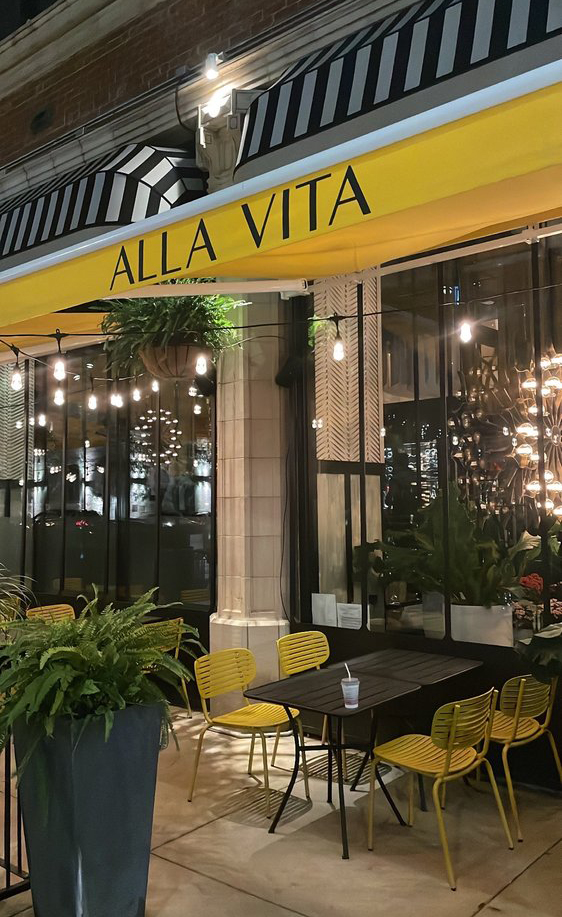
Bellemore would close, and BRG would give the property a cut-rate Kehoe Designs facelift and a murky “neighborhood Italian eatery” reimagining in 2021 courtesy of executive chef Lee Wolen. At a time when several new openings sought to engage with this cuisine, Alla Vita struck you as by far the weakest. Its pizzas, admittedly, impressed, but the food offered no clear perspective on the genre it had chosen. Service was perfunctory, wine (as always) offered nothing of note, dessert (particularly a version of tiramisu) was deeply flawed, and the restaurant just seemed concocted to rescue the profitability of a direly underperforming space. Relative to Bellemore, there was little risk—little need to sell the city on something (however vapid) that could at least be challenging. Now, with a burgeoning new office building across the street and lunch being served Monday-Friday, Alla Vita will have no trouble accomplishing its goal (though recent Yelp reviews suggest customers aren’t as undiscerning as they seem). You would just never confuse such a nakedly opportunistic, utterly shallow property as the product of hospitality luminaries.
Yes, that James Beard Award was meant to honor “creativity in entrepreneurship and integrity in restaurant operations,” but it presaged a descent into hackery. Los Angeles would be graced with a rehash of Cabra in 2022—part of a national partnership with The Hoxton. And, later that year, Boka Restaurant Group would sell a minority stake in its company to Levy: a group that once operated the legendary Spiaggia but, today, is defined by properties like the American Girl Café and a litany of lucrative concepts in Walt Disney World, convention centers, concert venues, and “arenas for all major sports leagues.”
BRG, in its own right, had already been expanding into stadium (and stadium-adjacent) dining via concepts like Dutch & Doc’s (later to become Swift & Sons Tavern). Izard, likewise, had already taken her This Little Goat brand to the United Center (partnering, as it happens, with Levy) via a taqueria. So, just as hotels had proven to be fitting venues for extensions of the BRG stable of chef-personalities (going back at least as far as Somerset), the Levy deal seemed like a sensible way to shoehorn the group’s intellectual property (diluted to whatever degree necessary) into other spaces with captive audiences. Considering the low standard of stadium food, this still probably makes for a net positive. However, it seems unlikely they’ll be opening their version of The Modern or In Situ any time soon.
To be fair, Boehm and Katz have seen notable success in New York City, a market in which The Alinea Group failed miserably and which, so far, only Brendan Sodikoff has seemed able to crack. (Though it should be remembered, at least as far as chefs go, that César Ramirez cut his teeth in Chicago at restaurants like Tru before meeting David Bouley and moving out East.) BRG’s Laser Wolf—a collaboration with Michael Solomonov and the Williamsburg branch of The Hoxton—earned a two-star review from Pete Wells and was alternatively titled “the restaurant of the summer.” Tables there book “months in advance,” and the concept has since been joined by K’Far (an all-day affair in the same hotel) and, even more recently, by Jaffa Cocktail + Raw Bar.
Back in Chicago, BRG’s biggest opening this year has been a trio of concepts within one historic building in Southport Corridor: GG’s Chicken Shop (from Boka’s Lee Wolen), Itoko (from Momotaro’s Gene Kato), and a relocated Little Goat Diner (from Izard). Such a roster seems rather formidable as far as Lakeview dining goes, but what appeal do such properties hold for the majority of Chicago diners? They each represent downscaled versions of their respective originals, brand extensions without much added depth, savvy means by which BRG continues to tap the local market without dreaming too big (or taking on too much risk). It’s the Alla Vita strategy writ large.
For a so-called “group of renowned culinary leaders who oversee a growing collection of acclaimed restaurants,” this seems like a natural next step. But it seems hard to ignore that New York City is home to BRG’s novel, more noteworthy restaurants as of late while Chicago and Los Angeles are stuck with the leftovers. And, with the group planning to start construction in Nashville next year and “keep expanding from there,” when will the Windy City ever see Boehm and Katz’s best work again?
Le Select, surely, was meant to throw a bone to Chicagoans—to affirm that BRG was not only partnering with glitzy chefs like Michael Solomonov in New York, but that the group’s founders could bring talent of a national caliber back home with them. That man was Daniel Rose, who had made his name crafting “market-driven” food at his 16-seat restaurant Spring in Paris’s Ninth Arrondissement (later reopened as a 28-seat restaurant in the First Arrondissement complete with a downstairs wine bar). Spring closed in 2017 after a little more than 10 years, but, by then, the American-born chef was also running La Bourse et La Vie (opened in 2015), a classic French bistro termed a “runaway success” by Michelin, in the Second Arrondissement.
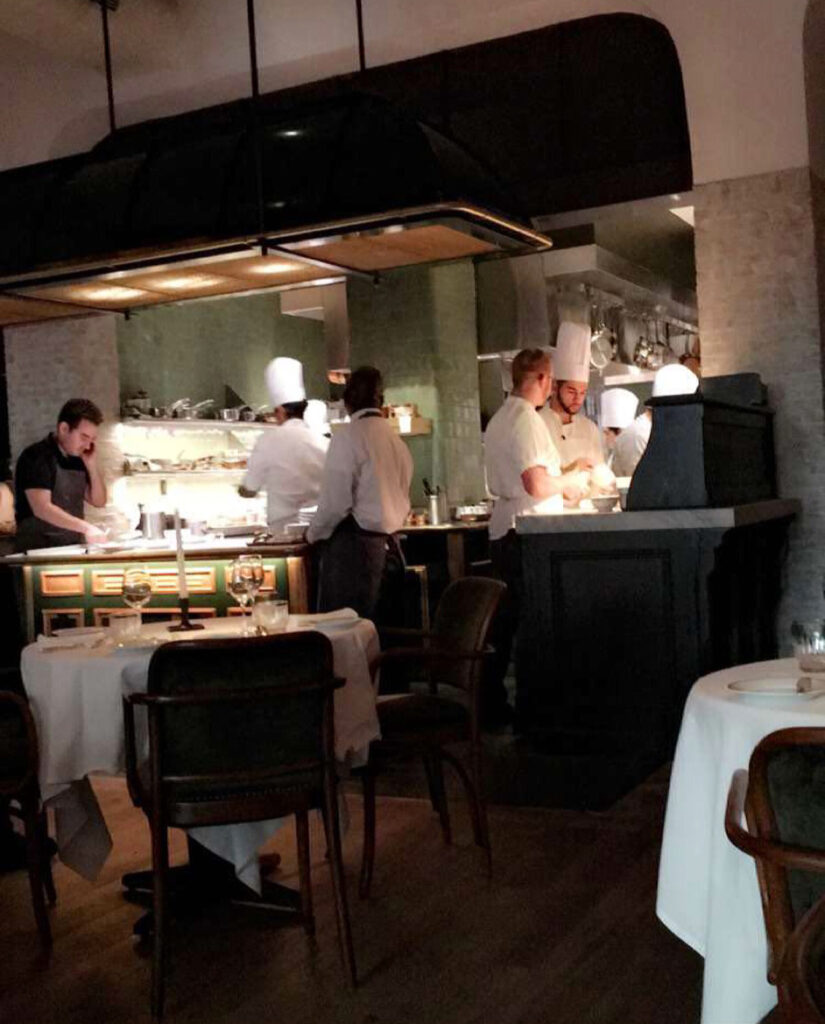
He had also, in 2016, partnered with Stephen Starr to open Le Coucou in New York’s SoHo neighborhood. The restaurant, which you visited several times during its first few months of operation, was an immediate success. It was billed as a homecoming for Rose and a “gracious modern nod to fine European gastronomy.” It delivered one of the most romantic, delectable celebrations of classic French cuisine that you have ever encountered stateside, almost singlehandedly reviving the genre as something (though it never needs to be) fashionable. Le Coucou would earn the James Beard Award for Best New Restaurant in 2017 and help propel Starr to the Outstanding Restaurateur honor that same year. The concept would also earn a Michelin star in Bibendum’s 2019 edition of the Guide, an honor which it holds to this day.
Le Coucou was Rose’s first time cooking professionally in the United States, and, with the help of a (soon-to-be) Outstanding Restaurateur recipient, the chef knocked it out of the park. Why couldn’t Boehm and Katz, fresh off of winning the very same award, replicate some degree of the same success? Rose was born and raised in Wilmette after all, leaving for France shortly after his high school graduation. Le Select would represent the perfect homecoming, the capture of a big-name chef for the Chicago market, and a key piece of empire-building for both parties involved.
Of course, Los Angeles came first. BRG, in partnership with Rose, opened Café Basque in December of 2022 on the ground floor of The Hoxton. It marked a complement to the rooftop Cabra Los Angeles concept (much in the same way Cira does in Chicago) and received a similar (if somewhat lukewarm) reception: a 7.3 (versus 7.6 for Cabra) rating and a four-star Yelp average. This seems serviceable enough for a “hotel restaurant” (though it should be mentioned that Le Coucou, in its own right, anchors the 11 Howard boutique hotel). Besides, Le Select would occupy its own building, stand as its own complete concept, and promise a scale and scope of French dining BRG and Rose had never pursued before.
Speaking of his partners, Rose would say that “Boka survived the pandemic in a way that was very admirable,” and “that sets them up for a very strong future.” Boehm and Katz would bring in frequent collaborator AvroKO to remodel the 12,000-square-foot, 200-plus seat space (formerly home to SushiSamba and Bottled Blonde). They would assemble a team that included chef Audrey Renninger (from La Bourse et La Vie), chef de cuisine Jason Heiman (a Chicago local), and service director Cara Sandoval (co-founder and former general manager of Oriole) to help execute Rose’s vision. And they would even—despite all the glitz and glamour surrounding such a sprawling new opening—look to manage expectations at what would ultimately be termed a humble brasserie: “Le Select isn’t going after awards, but aiming for a French definition of perfection…. Diners are going to find dishes they’ll crave, which will lead to repeat business.”
The restaurant’s opening in late January of this year elicited all the usual pomp. BRG’s diehard coterie of socialites, influencers, and captains of industry turned out to christen the newest jewel in Boehm and Katz’s crown. A pretty setting and free-flowing Champagne did enough, as far as people with more money than taste go, to make a positive impression. Everyone, at the very least, got their photo op at Chicago’s hottest new restaurant. Rose made an admirable effort to connect with each of his tables, and it was heartening to see Boehm leading proceedings on the hospitality side (while Katz, in classic fashion, reared his head to dim the lights just the right amount).
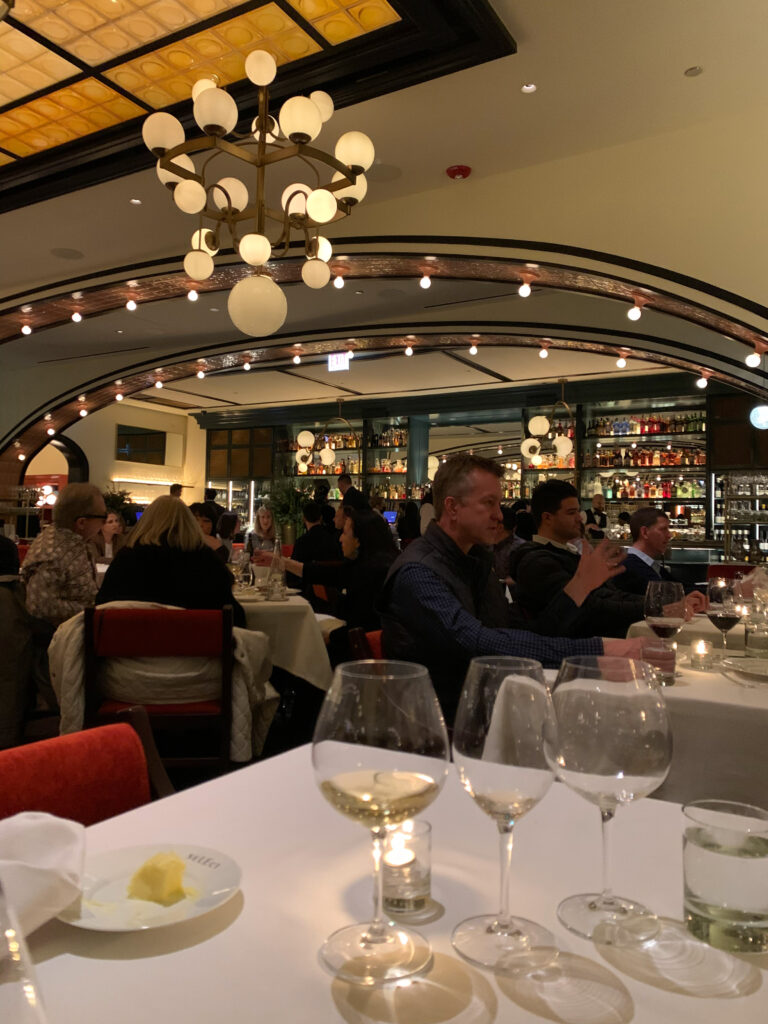
You visited Le Select during its opening weekend and, again, about a week after that. As always, you kept an open mind despite misgivings about BRG’s recent business decisions. Plus, having enjoyed Le Coucou so much, there was no reason not to welcome its chef back home to Chicago with open arms. Though some have likened the AvroKO design to a Paris Métro station, you much enjoyed the scale of the room. One can feel the pulsating energy of the crowd and people-watch without attracting too much attention. That kind of anonymity, married with the sense that you are hobnobbing with important people, strikes at the core of the brasserie’s (as exemplified by places like Balthazar) charm. Likewise, while Le Select’s wine list is grossly overpriced, it does represent one of BRG’s finest offerings in some time (with producers like Bruyère-Houillon, Chandon de Briailles, and Coche-Dury featuring among close to 400 different bottles).
Even service, while something of a sticking point for many diners, proved more than adequate. (Though, admittedly, you qualified for the Boka Black Card program many years ago and enjoy an extra degree of attention on account of your wine buying patterns—an essential means of differentiation, for better or worse, when trying to stand out in such a large dining room.)
Yes, Le Select clearly aspired to much more than Alla Vita ever did and, thus, possessed the right foundation on which to succeed. However, shockingly, Rose proved to be the weak link. His food was not only executed poorly (a forgivable-enough sin at the time of opening especially given the loss of his original chef de cuisine), but the menu itself seemed to lack joy—almost as if the chef actively felt disdain for French cuisine. Based on Rose’s other work, you know that not to be the case, yet it was sad to see him plying tables with bottles of rum at dessert while Chris Pandel and Lee Wolen tried to salvage the actual operation of the kitchen. (In one particularly grueling episode—perhaps the most uncomfortable one you have ever experienced during a meal—the chef sang all three minutes of Benny Bell’s 1946 novelty song “Shaving Cream” to your stunned table.) Shills like Steve Dolinsky did their best to gloss over these flaws, but mentioning Le Select in the same breath as Obélix strikes you as downright criminal.
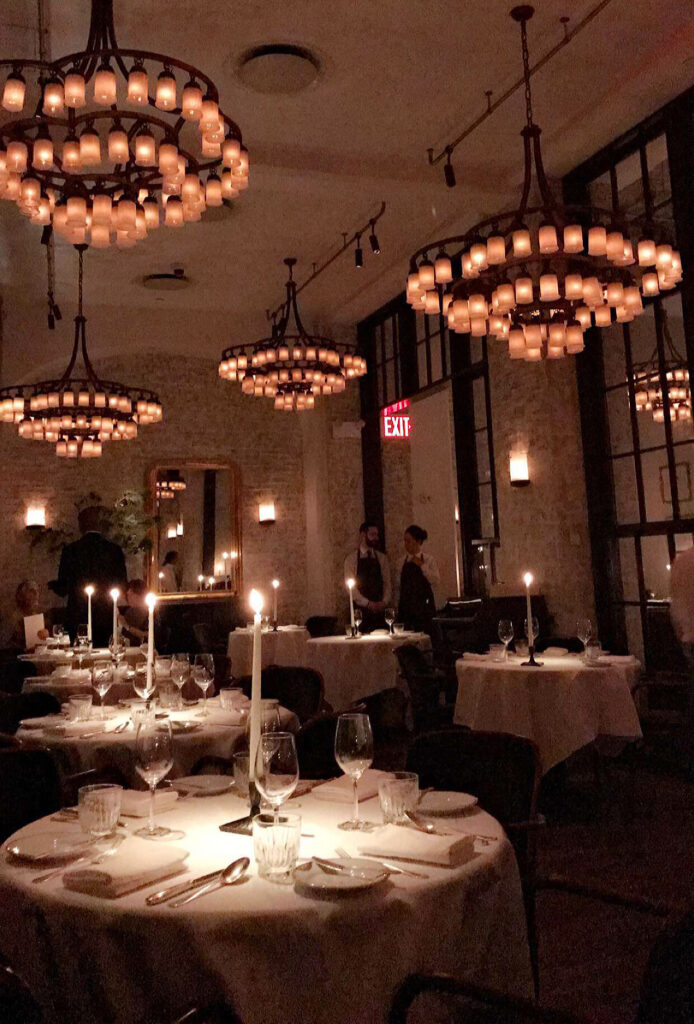
Why did Boehm and Katz fail in their partnership with Rose while Starr had wildly succeeded? Issues with adapting to such a larger scale of operation, adequately staffing/training/leading the kitchen, and perhaps a lack of recipe testing seem easy to pinpoint in hindsight. Or, quite simply, BRG had misjudged their partner’s potential to adapt his more refined style of cookery for the mainstream consumer altogether.
The collaboration certainly sounded good on paper, and Boehm and Katz deserve credit for bravely making a change when the situation—burdened by a slew of negative reviews—proved unsalvageable. In May, a little less than four months after Le Select’s opening, BRG parted ways with Rose in a decision that also affected Café Basque. A direct e-mail to Boka Black Card members titled “Culinary Updates Le Select” signed by the group’s founders revealed that, moving forward, the “culinary team will be led by Executive Chef Chris Pandel, Consulting Chef in Residence Lee Wolen, and Chef de Cuisine Pat Sheerin.” Rather politely, they added that, “as a result of this change, Daniel Rose is no longer part of the Le Select team.”
Turning the page, the e-mail announced that Pandel and his team “will be introducing a completely refreshed dinner menu” with the goal of offering “delicious and approachable French cuisine made for everyday dining”–a concept that “resonated” with the BRG honchos “from the start.” New items like a “Le Select Plateau” (seafood tower), “Spring Asparagus Toast,” “Escargot,” “Escargot Bolognese,” “Artichoke Ravioli ‘Nicoise,’” “Le Burger Americain,” “Trout Almandine,” and an expanded selection of steaks (along with a refurbished assortment of sides) affirmed that BRG was ready to coddle—rather than clunkily challenge—the palates of the mainstream consumer. You might term this a reversion to the “Alla Vita” strategy (even if Pandel’s menu, to its credit, remains a bit more ambitious than Wolen’s pizza, pasta, and chicken parm). However, when Boka invited its Black Card members back to Le Select in early June—offering a one-time 50% discount off the total bill through the end of the month as a kind of “extended Friends & Family”—it appeared that the group was willing to swallow its pride (and sacrifice some bit of lucre) to make things right.
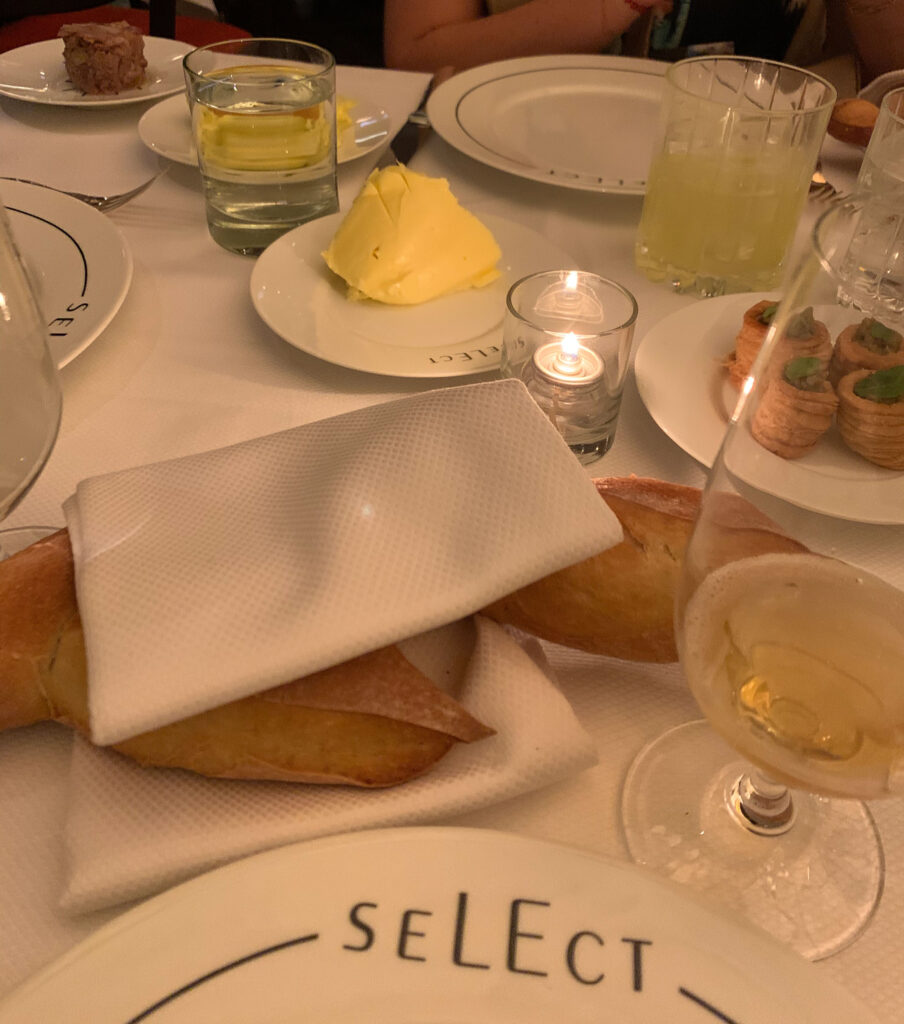
Le Select, no doubt, marks an embarrassing chapter in Boehm and Katz’s hospitality careers (but one, admittedly, that they reacted to with decisiveness and class). You do not think the restaurant’s “reimagined menu of French classics inspired by Midwest methods and ingredients” is truly “brimming with creativity and innovation.” In fact, you will state once more that Le Select cannot hold a candle to its compatriot Obélix located just a handful of blocks away. But the concept is now certainly poised to become a fixture in its neighborhood by marrying its attractive ambiance and beverage program with more competent, approachable fare. It will, in time, banish any lingering memory of its poor opening and fade into being a stylish, if unremarkable brasserie.
Yes, while rivals like Lettuce Entertain You and Hogsalt charge forward with novel concepts, BRG floundered when bringing its newest chef into the family. Discounting the successful collaboration with Michael Solomonov out East, Boehm and Katz seem comfortable with mediocrity back home. The two founders have pursued their own personal projects (BIÂN and The Pearl Club respectively) while partnering with Levy and setting their sights on further expansion afar without the sense that they any longer look to enrich Chicago’s dining scene. The balance sheet might look good, but the concepts themselves—reboots, spin-offs, and cash grabs—are totally uninspiring.
This all leads you to ask: what about the Boka mothership, the crown jewel, the Michelin-starred original upon which the group’s fine dining credentials are based? Rather than put Le Select “2.0” through its paces—a trite story of improvement and compromise, no doubt—why not take aim at the citadel? You smell blood in the water, and, after all, Boka is celebrating its 20th anniversary this year. Does the restaurant, today, represent an enduring legend or reflect, in line with other recent missteps, BRG’s downfall? Whatever the answer, asking the question presents an opportunity to immortalize an establishment that, despite any misgivings you may feel today, has cemented its place in Chicago’s gastronomic history. It offers a chance to engage with a living, breathing piece of the city’s hospitality heritage and see just what standard—two decades on—has been set.
Boka opened its doors in October of 2003, then representing the culmination of Boehm and Katz’s budding—but undeniably successful—careers in hospitality. The former man had opened two restaurants in Florida, one in Springfield (his hometown), and another in Nashville by the age of 30. The latter, originally from Vancouver, moved to Chicago to be an options trader but fell into helping out at his roommate’s bar and would go on to open four of his own by the time he also hit that three-decade mark. By 2001, both felt ready to take the next step into more serious restaurant ownership, and Boehm and Katz were introduced to each other by friends that same year. That “15-minute cup of coffee” turned into a “four-hour discussion” and kicked off a “year and a half of location scouting” that led to the development of Boka.
Being “afraid of the downtown rents,” Boehm and Katz settled on 1729 N Halsted—formerly home to Mexican restaurant Don Juan (and, before that, Blue Mesa)—near the Steppenwolf Theatre in Lincoln Park. Boka was characterized as “a departure from the neighborhood joints popping up” in the area back then. Boehm would even characterize it as a “hip counterpart” to the aforementioned theatre at the time. However, looking back on the occasion of the restaurant’s 15th birthday, the founders would reveal a greater degree of intention: “the plan was to open a non-stuffy, contemporary American concept that fit somewhere between the city’s white tablecloth spots, like Charlie Trotter’s” and “the countless lower-end, casual haunts.” Put another way, there was a “whole lot of ultra fine dining” and a “whole lot of ultra casual” with little in between.
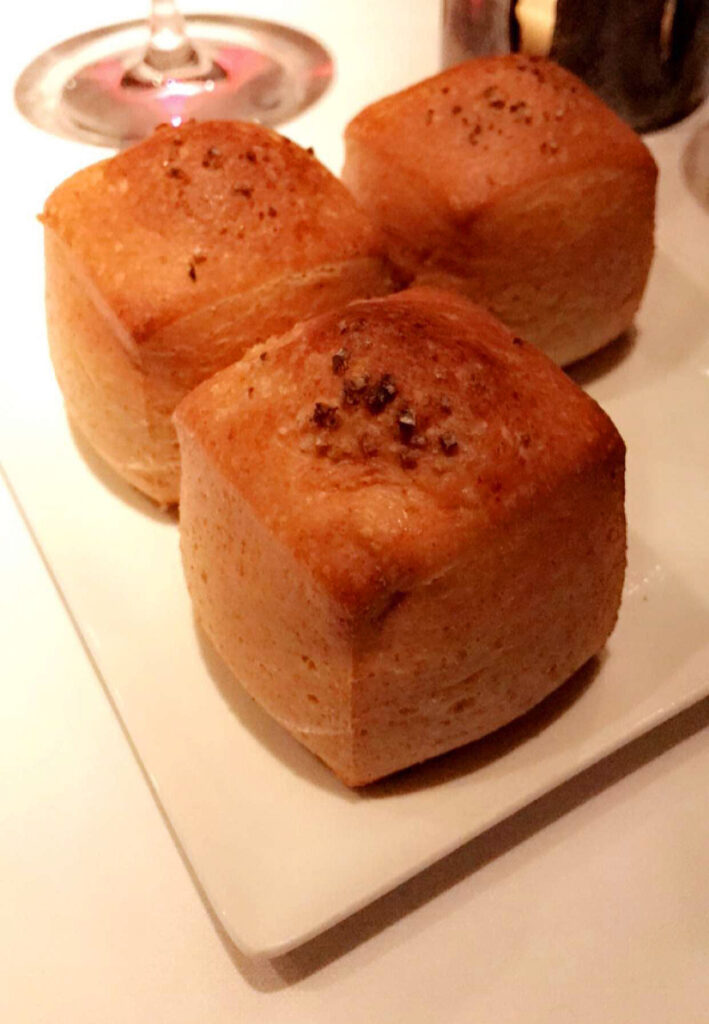
More specifically, Boka was consciously inspired by Danny Meyer’s Gramercy Tavern, a restaurant that had opened in 1994 and, in 2003, whose kitchen was still being run by co-founder and chef Tom Colicchio. The “contemporary American” concept was (and is) known for its dual dining spaces (a front tavern room and a more formal dining room) serving à la carte items and seasonal tasting menus featuring “the best products of the market, masterfully prepared in creative combinations” (as Michelin would write in 2005). Gramercy Tavern was ranked the “#1 Most Popular Restaurant” as part of Zagat’s NYC survey in 2003 (and would hold the first or second spot every single year through 2016). It had earned the Best Chef: New York City award (in 2000) and Outstanding Wine Service award (in 2002) from the James Beard Foundation. And the restaurant would go on to win the Outstanding Restaurant, Best Chef: New York City (for Colicchio’s replacement), and Outstanding Chef awards in the future along with holding a Michelin star in every edition of the NYC Guide since its launch in 2005. In short, Boehm and Katz could hardly have picked a better model from which to build their own legendary establishment.
But the owners had “zero chef relationships in Chicago” and, thus, “put an ad in the Chicago Reader.” Giuseppe Scurato, who had worked as a sous chef for Wolfgang Puck in San Francisco before opening Spago Chicago (as chef de cuisine) and joining Michael Kornick’s mk, made the cut along with pastry chef Leticia Zenteno. His food, at the time of Boka’s opening, was labelled “ambitious but tastefully restrained” with items like “grilled bobwhite quail with braised greens, applewood-smoked bacon and black mission figs,” “lobster risotto,” and “a double-cut pork chop with rosemary-cider reduction and blue cheese potato gratin” appearing on the menu. Also of note was a “Battle of the Sexes” wine list featuring “60-plus bottles” sorted by style “with two options per category-—one by a male and one by a female winemaker.” A “scorecard” kept “a running tally” of which producers were chosen, with the men leading with “54 percent of bottles and glasses sold” when the restaurant was featured by the Tribune in November of 2003.
Scurato’s tenure at Boka would last a little more than three-and-a-half years, a period that saw notable dishes like:
- “Japanese yellow tail crudo, radish salad, cucumbers, shiso, and soy-mustard”
- “Corn crusted maine scallops, chanterelle mushrooms, baby leeks, popcorn, lavender cream”
- “Pan seared hudson valley foie gras with duck confit, parsnip puree, pistachios, bing cherries, apricots, and a [sic] Armagnac-plum sauce”
- “Arborio rice risotto with roasted corn, oven dried tomatoes, shrimp, basil”
- “Potato gnocchi with duck confit, carmelized [sic] onions, sage, brown butter and pecorino cheese”
- “Homemade fettuccine, with morel mushrooms, english peas, sage butter, parmigiano-reggiano broth”
- “Pan roasted frog legs with herb butter, gribiche [sic] sauce and microgreen salad”
- “Rare-seared yellowfin tuna, daikon tamari ponzu, baby bok choy, soy beans, tempura vegetables”
- “Roasted monkfish ‘ossobuco,’ caramelized cohlrabi [sic], baby carrots, brussel sprouts, potatoes, bagna-cauda”
- “One half grilled maine lobster, warmed black trumpet mushroom, corn and frisee salad, neuski [sic] bacon vinaigrette”
- “Grilled calves liver, crispy neuski [sic] bacon, fried onions, 12 year aged balsamic, and parsley oil”
- “Maple syrup cabernet braised pork shank, swiss chard, glazed baby carrots and pattypan squash, garlic chips”
- “Pan roasted maple leaf duck breast, wild mushroom ragout with black truffles and espresso, brandy sauce”
- “Braised short ribs, red wine orange daube, celery root puree, salad of watercress, radish, and orange segments”
- “Hardwood grilled ribeye, potato-salsify gratin, slow roasted dutch shallots, black trumpet mushrooms, pink peppercorn sauce”
appear on the menu, along with wines from producers like Bryant Family, Chartogne-Taillet, Claude Dugat, Guigal, Hanzell, J.J. Prüm, Ken Wright, Kistler, Krug, Comte Lafon, Leflaive, Mongeard-Mugneret, Patricia Green, Pol Roger, Etienne Sauzet, Selbach-Oster, Laurent Tribut, and Quilceda Creek.
After “six month[s] of negotiations,” Boka’s “pivotal moment”—as described by Boehm and Katz—arrived in March of 2007. The restaurant succeeded in luring Giuseppe Tentori, who had spent a decade at Charlie Trotter’s and risen to the position of chef de cuisine, over to be its executive chef. He was joined by Elizabeth Dahl (formerly of Naha and Trotter’s) as pastry chef.
In August of 2007, Tentori’s “simple” and “dazzling” “Mediterranean-influenced, contemporary American cuisine” earned a three-star review (“excellent”) from Phil Vettel at the Chicago Tribune. Therein, the chef was noted for making “menu changes every two weeks or so” (though certain favorites remain “permanent fixture[s]”). In April of 2008, national media would come calling when Food & Wine—back in those glory days of print—named Tentori one of 10 “Best New Chefs in America.” The editors would praise his “innovative menu revolving around seasonal ingredients” and “eclectic, multi-layered dishes.”
For their part, Boehm and Katz would admit that Tentori’s “standard was…so much higher than anyone…[they] had ever worked with before, and he had an expectation level for everyone.” The new chef forced the owners to “continually elevated” their “game” just to keep up, which—along with the Food & Wine accolade—“legitimize[d]” the restaurant. Tentori notably introduced the “six or eight course” tasting menu to Boka in 2008 and marked a transition from “classic American food to progressive American food” in stylistic terms. That would see him named a semifinalist for the James Beard Foundation’s “Best Chef: Great Lakes” award in 2008, 2009, 2010, and 2013.
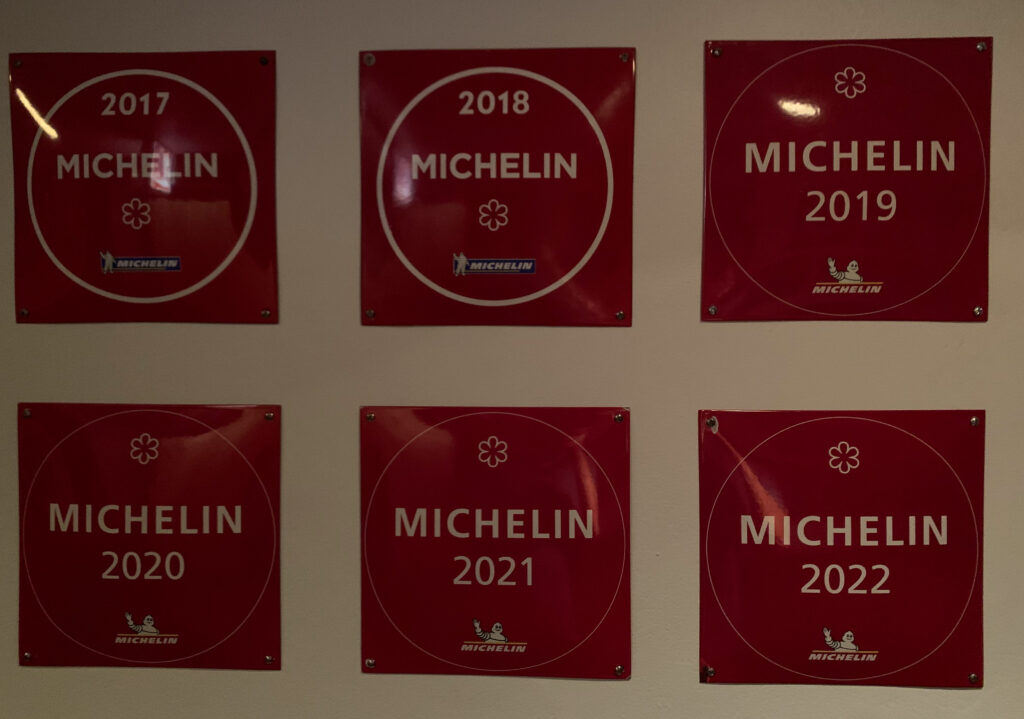
More importantly, when Michelin released its first Chicago guide in 2010, Boka would earn a star. Bibendum termed the restaurant a “pretention-free oasis” focused on “contemporary American cuisine showing Mediterranean influences, and dusted with an emphasis on ingredient sourcing.” It would also praise “avant-garde culinary choices,” “sensational twists,” and a degree of “composition and presentation” that equal the “exquisite dishes.” Boka has held this Michelin star every year since.
Tentori’s tenure would last through the end of 2013, upon which he would embark on his own projects with BRG: the aptly named GT Fish & Oyster and, later, GT Prime Steakhouse. Notable dishes during the chef’s time at Boka included:
- “Marinated big eye tuna, grapefruit, wilted mizuna, pickled onion and caper”
- “Stuffed squid, baby spinach, spicy pineapple, black tapioca”
- “Ash baked eggplant, white polenta, leek, laura chenel goat cheese”
- “Poached hen egg, salsa verde, fried masa cakes, black bean chip, housemade queso fresco, jicama-nopales salad”
- “Seared sonoma valley foie gras, grilled banana, brioche duet, toasted pine nuts, baking spice gastrique”
- “Grilled hamachi with broccoflower, kalamata olive, pickled garlic and shrimp dumpling”
- “Grilled baby octopus, eel terrine, potato & horseradish salad, candied bacon, arugula puree”
- “Maine diver scallop, korean short ribs, forbidden black rice, cumin dusted lotus root, roasted zucchini puree”
- “Barramundi, green tea soba noodles, tofu beignet, hijiki, pomelo, saffron & shellfish froth”
- “Short rib agnolotti, poached lobster, confit kohlrabi, black garlic, five spice oil, broccoli sauce, soy vinegar”
- “Chili dusted sweetbread, collard greens, okra, chicharrons, poached egg, ham broth”
- “Crispy chicken thigh, apple & chestnut risotto, pickled turnip, wild mushroom sauce”
- “Coriander crusted pheasant breast with parsley yukon gold whipped potatoes, cipollini onion and brussel sprout leaves”
- “Braised veal cheek, crispy sweetbreads, moroccan ratatouille, creamy grits, collard green puree”
- “Rabbit leg roulade, roasted rabbit loin, stinging nettle, pancetta, bee pollen gnocchi, onion chamomile sauce”
- “Sweet & spicy pork belly, steamed bao, white trumpet royale, asian slaw, fermented black beans, scallion puree”
- “Beef tenderloin, yorkshire pudding, boudin noir, salsify, savoy cabbage, cipollini onions”
- “Muscovy duck breast, foie gras raviolo, braised red cabbage, pickled duck tongue, caramelized cauliflower sauce”
- “Bison strip loin, stinging nettle soubise, bee pollen spaetzle, artichoke, pickled wild spring garlic”
Along with wines from producers like Aubert, Beaucastel, Bollinger, Georg Breuer, Robert Chevillon, Pierre-Yves Colin-Morey, Dagueneau, Dalla Valle, Vincent Dancer, Dönnhoff, David Duband, Dujac, Egly-Ouriet, Benoit Ente, Gaja, Henri Giraud, Anne Gros, Haut-Brion, Hundred Acre, Kongsgaard, Nicolas Joly, Keller, Benjamin Leroux, Latour, Leroy, Littorai, Lokoya, La Mission Haut-Brion, Markus Molitor, Peter Michael, Opus One, Palmer, Domaine du Pegau, Pierre Peters, Philipponnat, Puffeney, Quintarelli, Rayas, Mouton Rothschild, Ridge, Salon, Screaming Eagle, Shafer, Sine Qua Non, Tempier, Vacheron, G.D. Vajra, Vega Sicilia, Vietti, Williams Selyem, and Wyncroft.
In November of 2013, on the occasion of Boka’s 10th anniversary, Boehm and Katz announced a “pretty dramatic” change to the restaurant’s “look and food.” Tentori was set to leave and would be replaced by Lee Wolen, whose experience included one year as sous chef of Moto, an eight-month stage at elBulli, three years as sous chef of Eleven Madison Park, and two years as chef de cuisine of The Lobby at The Peninsula Chicago. In that latter role, he helped earn the restaurant a Michelin star in Bibendum’s 2014 Guide (the only in the concept’s history). Wolen would be joined by pastry chef Genie Kwon (herself an EMP alumna) and would be replacing the previous tasting menus with “approachable, clean flavors” solely “in an appetizer-salad-entree format.”
Seemingly, BRG did not like that its flagship had become a “special occasion restaurant,” and the new chef did not want to “tell people how to eat.” Rather, they wanted it to feel like more of a “anytime you have time spot” that would enable the team’s “sincere desire to see everyone more often.” Boka would be remodeled at the end of 2013 to ensure a “symmetry” between Wolen’s new take on the menu “and the feel of the restaurant.” The concept would reopen in February of 2014 with the perspective that it was a “brand-new restaurant” but would look to maintain the same “integrity.”
Speaking of the progression from Scurato to Tentori to Wolen, Boehm and Katz would explain that the “tie that binds [the chefs] is American cooking.” They would even, in 2018, go so far as to claim that “Wolen might be the most technically sound chef in all of Chicago.” Just as Tentori “legitimized” Boka via the recognition he earned upon taking over, his successor has amassed an even more impressive trophy cabinet through the present day.
Beyond maintaining that Michelin star each and every year, Wolen was immediately crowned “Chef of the Year” for 2014 by the Chicago Tribune, which noted that “his menus tend to be low on exotic ingredients,” but his “execution is unfailingly stunning.” Boka, likewise, would be named “Restaurant of the Year” at the Jean Banchet Awards on the back of its reopening. Nationally, Wolen would be nominated for the James Beard Foundation’s “Best Chef: Great Lakes” award in 2016, 2017, 2018, 2019, and 2020. Meg Galus, who would replace Genie Kwon in 2015, would be nominated for “Outstanding Pastry Chef” in 2016, 2017, 2018, and 2019. Boka itself would be named a semifinalist for “Outstanding Service” in 2017, would be nominated for the same award in 2018, and would be named a semifinalist for “Outstanding Restaurant” in 2020. Finally, who can forget Boehm and Katz’s nominations for “Outstanding Restaurateur[s]” from 2015-2019, which—while not exclusively attributable to mothership Boka—certainly drew on the concept’s success as their lynchpin.
Wolen’s tenure, which included stewarding the restaurant through the pandemic and persists to this day, has seen the following notable dishes appear on his menu:
- “Marinated Hamachi (yuzu kosho, plum, almonds, fennel)”
- “Bay Scallop Crudo (cauliflower, almond, citrus)”
- “Shima Aji (tomato, lemon verbena, buckwheat, radish)”
- “Cured Foie Gras Salad (peach, hazelnut, baby lettuce, buttermilk)”
- “Marinated Spring Artichokes (burnt sunflower, endive, quince vinegar)”
- “Heirloom Tomatoes (watermelon, sunflower seeds, lemon balm)”
- “Marinated Prawns (sheep’s milk yogurt, smoked dates, hazelnuts, horseradish)”
- “Broccoli Agnolotti (goat gouda, lemon, black truffle)”
- “Kabocha Agnolotti (chanterelle, toasted yeast, smoked scallop)”
- “Salt Cod Ravioli (fava beans, artichokes, arugula, lemon)”
- “Ricotta Gnudi (arugula, hazelnuts, morcilla)”
- “Ricotta Dumplings (broccoli, goat gouda, fried garlic)”
- “Tajarin (black truffle, parmesan)”
- “Roasted Veal Sweetbreads (grilled bitter greens, peach, turnip)”
- “Charcoal Grilled Beets (buckwheat, sheep’s milk yogurt, licorice)”
- “Pekin Duck Breast (fennel, peaches, sheep’s milk feta)”
- “Rabbit Loin & Sausage (confit leg, pickled ramps, apricot, pistachios)”
- “Wild Striped Bass (french white asparagus, razor clams, green garlic)”
- “Grilled Maine Lobster (matsutake, potato, seaweed)”
- “Roasted Pork Loin (crispy belly, spring onion, sorrel, sour cherry)”
- “Roasted St Canut Porcelet & Crispy Belly (nectarine, sunchoke, gem lettuce, chanterelles)”
- “Grilled Beef Short Rib (baby gem lettuce, hen of the woods, corned tongue)”
- “Juniper Rubbed Venison Loin (blood sausage, smoked chewy beets, grilled cabbage)”
- “Whole Roasted Dry Aged Duck for two (foie gras sausage, spring onion, rhubarb)”
Along with wines from producers like Allemand, Antica Terra, Araujo, Comte Armand, Ar.Pe.Pe., Bérêche, Simon Bize, Bonneau du Martray, Cédric Bouchard, Chave, Bruno Clair, Clape, Domaine du Collier, Ulysse Collin, Corison, Cotat, Domaine de la Côte, Diamond Creek, Evening Land, Fichet, Fourrier, Thierry Germain, Giacosa, Guiberteau, Jamet, Emmerich Knoll, Koehler-Ruprecht, Lafarge, Laroche, Peter Lauer, Georges Laval, Marguet, Méo-Camuzet, Le Moine, De Moor, Denis Mortet, Mugneret-Gibourg, Nanclares, Jérôme Prévost, Radikon, Rhys, Domaine de la Romanée-Conti , Rouget, Roulot, Roumier, Sandhi, Savart, Trump Winery, and de Vogüé (among many of the other producers already listed).
It is worth noting that Boka’s tasting menu returned around the midpoint of 2015 and has, as it was in Tentori’s time, remained a fixture ever since. Unfortunately, the details of these meals are not preserved in the same manner as the à la carte offerings (even if there is typically some degree of overlap between the two). Nonetheless, the mere fact that these tastings returned signals how the new “anytime you have time” identity—launched in 2014—has had to ultimately reconcile itself with the restaurant’s preexisting “special occasion” status. Boka has a Michelin star after all, and many Chicagoans have come to expect some form of set menu—a turnkey gastronomic experience that precludes making the “wrong choice”—when visiting establishments of that status. In truth, the overall approachability of the concept (with its traditional à la carte options) may better encourage skeptical diners to wholly trust the chef (relative to more imposing restaurants at the two- or three-star level whose menus are entirely shrouded in mystery).
To that point, looking back over 20 years and three different chefs (from an admittedly blurry, rather removed standpoint), Scurato and Wolen seem to have more in common with each other than either has with Tentori. The latter, flexing his Charlie Trotter’s credentials, crafted menus filled with eclectic flourishes: “brioche duet,” “baking spice gastrique,” “eel terrine,” “green tea soba noodles,” “tofu beignet,” “shellfish froth,” “steamed bao,” “yorkshire pudding,” “stinging nettle soubise.” Meanwhile, the former two—reflecting more of a straightlaced Spago- and EMP-derived contemporary American influence—created dishes that spoke of a simpler, ingredient-driven vision: “lavender cream,” “bacon vinaigrette,” “parsley oil,” “parsnip puree,” “quince vinegar,” “grilled bitter greens,” “pickled ramps,” “smoked chewy beets,” “corned tongue.”
It should be considered that changes in the naming conventions for Boka’s dishes between eras may account for Scurato and (especially) Wolen’s food seeming less complex. However, it also seems clear that Tentori was brought in to elevate the cuisine in line with what was the most influential restaurant of its era. Doing so, he won a Michelin star and laid the groundwork for Wolen to maintain that standard while taking inspiration from his own experience at what was subsequently one of the most influential restaurants of its own era (EMP). Sacrificing some of Charlie Trotter’s penchant for French and Japanese technique meant gravitating back toward a style that matched Boka’s original inspiration: Gramercy Tavern. The same goes for omitting (temporarily) any tasting menu: something that is, indeed, offered at Gramercy Tavern but not compulsory as it would be at Charlie Trotter’s or EMP.

That being said, across some 20 visits to Eleven Madison Park in the period directly following Wolen’s departure from the restaurant (a period that saw the restaurant christened “The World’s Best Restaurant” by William Reed’s self-important jury), you never felt particularly impressed by the food. Yes, it was made with finesse and beautifully presented but never struck you with the same hedonistic power as Brooklyn Fare or the same paradigm-shifting approach to ingredient sourcing as Blue Hill at Stone Barns. Rather, EMP’s food was broadly pleasing and memorably presented without ever pursuing extremes of flavor or texture. In short, it was aesthetically refined but fairly safe cooking that was buoyed by an absolutely top-class hospitality and beverage program (port tongs and all) that made for a singular experience. These latter factors, you think, really worked to secure the restaurant its accolades, for boundary-breaking cuisine is often too polarizing to please the lowest common denominator. Instead, Daniel Humm developed a style of cookery that everyone could enjoy at a basic gustatory level while empowering the front-of-house team to weave their magic tableside. However, stripped of its service-based bells and whistles, EMP’s food was not all that different from the NoMad or Davies and Brook: Michelin-starred concepts with fussy, restrained seasonal fare that did little to stir the soul. Given the touting of Wolen’s time working under Humm, it may be worth probing just how valuable that influence—beyond all the glitz—really is.
Today, Wolen remains at the helm of Boka and has just, in fact, celebrated his tenth anniversary there (with the late June date revealing just how far in advance Boehm and Katz brought him on ahead of the 2014 renovation). The executive chef, though he has partnered with BRG on other projects over the years, is almost synonymous with the group’s crown jewel restaurant at this point. Such longevity can cut both ways in terms of motivation, but post-pandemic staff shuffles have kept things interesting: namely, Meg Galus’s departure and replacement by Kim Mok as pastry chef.
Boka at 20, Wolen at 10, and BRG (with Levy) going national—could the stakes be higher? Or is it lower? For no small snapshot can adequately reflect a dining institution’s ultimate legacy, but it may help to reveal how Chicago’s dining scene (and, perhaps, you yourself) has changed over two decades.
You have visited Boka as long as you have been dining in Chicago but, for the purposes of this review, will focus on a series of three visits (on different days of the week and comprising different party sizes) conducted throughout June of 2023. This timeframe, while abbreviated, will help to track the menu’s current degree of dynamism (remember Tentori saying he makes changes “every two weeks or so”) and the staff’s response to serial patronage. It also allows, as far as dishes that you have tasted multiple times, for a more precise evaluation of consistency: a particularly salient metric for a restaurant of this age and stature.
With that said, let us begin.
From the outside, 1729 N Halsted, that old Don Juan and Blue Mesa space, has not changed all that much over the past couple decades. Yes, the front patio’s blue brick accents are long gone, along with the matching blue “Boka Restaurant + Bar” text on the streetside awning. In their place, you find black brick, columns, window frames, railings, and light fixtures that match the building’s worn cornice while working to contrast the faded reddish-brownish brick wrapping around the rest of the structure. Taken in from afar, the restaurant’s exterior fits perfectly with the designs of its closest neighbors. The entrance, as always, is marked by overflowing greenery, but the Michelin-starred concept remains inconspicuous. Its name appears over the front door, which is set—across that aforementioned patio—a good ways back from the sidewalk. Otherwise, guests may only spy a shining metal planter with the Boka logo (a later addition) closer to the curb. Even later, a crossed fork and key symbol (one of the restaurant’s newer motifs) was added atop the text—perhaps to help assure passersby that there is, indeed, an eatery back there.
Yes, as BRG pursues ever-larger and more glamorous openings in boutique hotels and bowling alleys, its mothership remains beautifully understated: all the better to fit in on a block that lacks the same concentration of competition as the group’s River North and West Loop properties. Alinea remains two doors down as a particularly illustrious neighbor (its own edifice being as inscrutable as ever). Likewise, a longstanding trio of casual Italian concepts—Trattoria Gianni, Vinci, and Pizza Capri—help to absorb the Steppenwolf crowds.
Otherwise, with Charlie Trotter’s (once located about a block to the north) and L2O long gone, the neighborhood is a rather dire place to eat. To the west, you find a sprawling retail park that—however convenient its various wares—houses chains like Burrito Beach, Buffalo Wild Wings, Chipotle, Epic Burger, Roti, Subway, sweetgreen, Taco Bell Cantina, and Uncle Julio’s (along with, if you dare, a second location of Fatso’s Last Stand). To the north, the options are a bit better, with LEYE concepts like Summer House, Ramen-san, and Café Ba-Ba-Reeba! leading the charge alongside Blue Door Farm Stand and Mediterranean spots like Cedar Palace, MEDI, and Athenian Room. Further afield, you may find notable spots like Armitage Alehouse, Bocadillo Market, Esmé, Evette’s, and even Galit interspersed with classics like Geja’s, Pat’s, Pequod’s, Wiener’s Circle, and the like. But Boka, undoubtedly, is one of few gastronomic options in a neighborhood where the other Michelin-starred options tend to misfire.
With Alinea being the sort of place to laugh would-be walk-ins out the door, Boka positively bosses its respective block and monopolizes its premium theatre dining. Plus, being at the very south end of Lincoln Park, the restaurant also does not feel quite so far from all the dining options immediately surrounding Downtown Chicago and flowing up into the Gold Coast. Its venue, 20 years on, is highly accessible without having fallen victim to any surrounding overdevelopment. Thus, the concept need not shout its presence on the block but remains pleasantly subdued, serene, and a bit cloistered. You cannot even really look through the building’s blackened windows, and the restaurant’s front door, even if it is left open to welcome guests in from time to time, is far enough way to preclude any view into the dining room. This ensures that entering Boka, even if it lacks the shock and awe of Alinea, Ever, or Oriole, retains some sense of that romantic, transporting effect. It suggests, as you make your way across that singular patio, that this grande dame of Chicago dining still holds some secrets and may very well deliver something special.
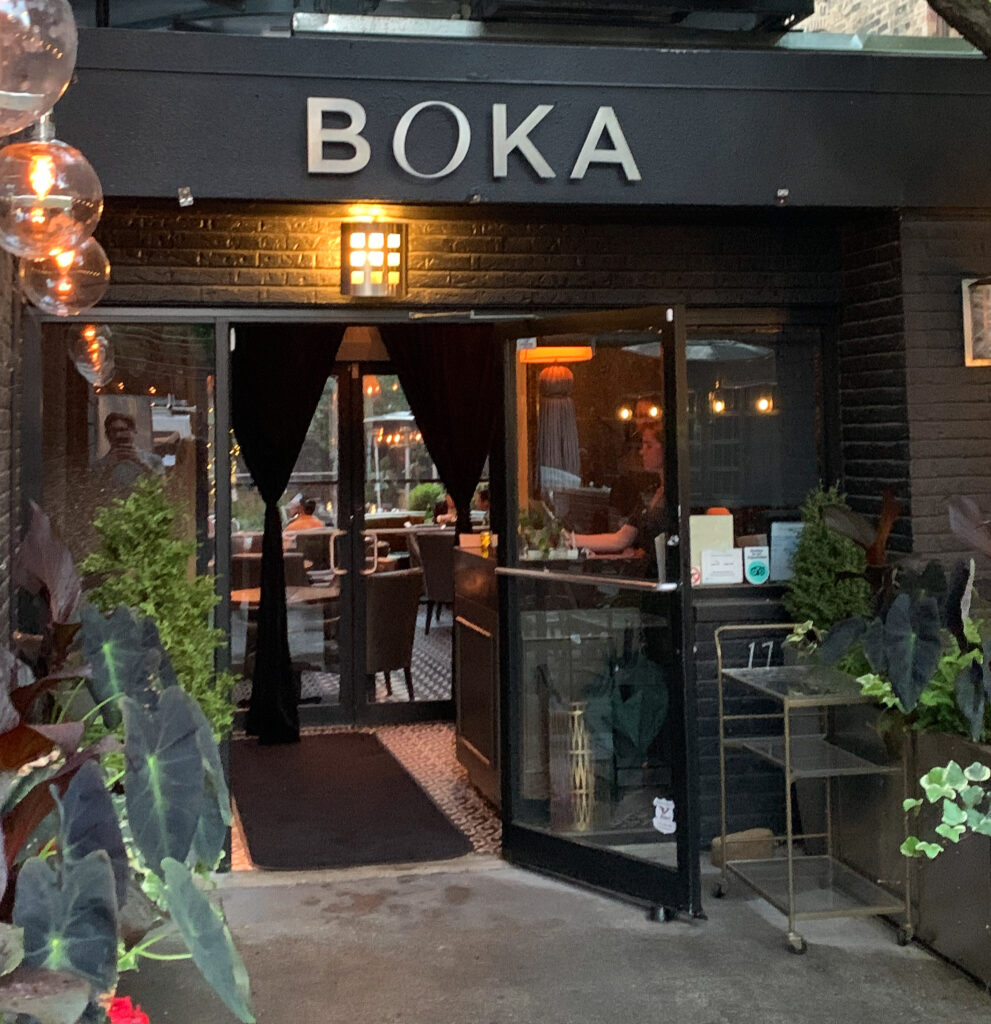
Passing through the restaurant’s front door, you immediately encounter the host stand. Chances are, one of the two or three women that are always posted there has been waiting, watching, and perfectly anticipating your arrival. Their greeting is immediate and cheery as you finally enter range and lock eyes. The youngest of the hostesses still looks to be in high school. Opposite her more experienced counterparts, she lends the welcome a trace of earnestness that catches you somewhat off guard. This is not a sleek, suited, serious Michelin-starred concept that contrives to make you doubt that you really belong. Rather, Boka’s staff is disarming from the very first moment of interaction. They instill the sense that this is a warm, family-friendly environment that just happens to craft superlative food. Effortlessly, they put you at ease and prepare the ground for your server to maintain the same mood upon reaching the table.
20 years on, when a restaurant may easily operate as if it’s seen and done it all, the charm of such an exemplary welcome cannot be understated. So many of Chicago’s finest restaurants (especially those that merely purport themselves to be) exhibit a palpable degree of tension when first encountering guests. Perhaps the staff has studied their notes a bit too much or, otherwise, is simply driven too hard by their managers. But this overwhelming degree of anticipation leads to interactions that seem stiff, overly rehearsed, and—yes—uncanny. For some, all this fuss feels like luxury. However, in an experience economy that increasingly prizes authenticity, it increasingly comes across as hollow.
Boka sets the tone of being a “neighborhood restaurant” brilliantly, and the restaurant is clearly rewarded for doing so. You do see some of the usual tourists and transient star-chasers throughout the dining room. But what strikes you more is the older couple, complete with a foldable walker, that you see helped into their seats. Or, perhaps, it is the family whose young daughters feel comfortable enough (and are allowed, for better or worse) to dine here in jean shorts and flip-fops. You must also mention the young father trying to foist an oversized stroller—strewn with every manner of bag and bauble—through the door.
Such moments may raise eyebrows at other establishments, but Boka responds with perfect deference. The restaurant accepts these parties as they are rather than asking them to fit the mold of what “fine dining” demands. In doing so, it has truly endeared itself to the community and come to transcend what that Michelin star signals from the outside. Better yet, once a first-timer has been brought into the fold (and assuming they do not get perturbed by things like a lack of dress code), the restaurant opens its arms as if you are a regular. Boka is the delightfully refined but never stuffy space that all ages—necessitating any kind of accommodation—can enjoy. This mood might not be the right fit for every expression of gastronomy, yet, here, it harkens back to a kind of Disneyfied hospitality that you find rather nice. Much of that is reflected, too, in the restaurant’s interior design.
Boka’s original aesthetic was crafted by New York-based Bogdanow Partners, whose founder Larry Bogdanow had notably designed Danny Meyer’s Union Square Café to be “easy, comfortable and timeless” as if “no architect had ever been there.” His work for Boehm and Katz included “interesting elements” (in the restaurant’s own words) like “a cell phone booth, a stainless steel water trough that illuminates the entrance wall, fabric sculptures in the main dining room, and striking colors that range from marigold to cranberry.” That sounds—and, based on a surviving image, looks—like a lot, but these warm, vivid tones must have seemed quite fashionable in the early aughts. Plus, they (and the rest of the listed novelties) clearly did not stop Bibendum from awarding the concept a star in 2010.
Nonetheless, Tentori’s reign would see Boka receive its first facelift around the start of 2012. These changes were described as “fairly minor,” having taken place “while the restaurant was still open,” but led to a result that was “much more modern and sexy.” Specifically, the color scheme lost much of its vividness and transitioned to “various shades of silver and gray, with accents of white and cream.” Likewise, “leopard print patterned” chairs were reupholstered with “white snake skin” and “regal purple” banquettes were redone with a “cream, gray and green pattern.” An “intimate lounge area,” too, was added across from the bar. Few photos of this particular period, which ended up being rather short, survive. However, this was the version of Boka that you first visited, and, while the “fabric sculptures” still strike you as a bit strange, the dining room felt understated, contemporary, and refined without being stifling.
Concurrent with Wolen’s acceptance of the executive chef job, Boka would close at the end of 2013 and unveil a more elaborate redesign in February of 2014. These changes, which persist to this day, were billed as part of the restaurant’s 10th anniversary “refresh” and included a conceptual pivot away from Tentori’s tasting menus (at least temporarily) toward the “anytime you have time spot” that could “see everyone more often.” On paper, features like “dark woods, black leather, a living wall, and antique artwork” formed “a stark contrast to the light color scheme and airy linens” that characterized the 2012 aesthetic. However, words alone fail to capture the sense of whimsy that permeates the space. It is one that really does connect to—and maybe even enhances—the tenor and tone of hospitality that is set from the first moment of interaction.
The interior, composed by Chicago-based Simeone Deary Design Group, catches your eye from the moment you enter. Just behind the host stand, the entire wall (including a hidden door) is rendered in bronze- and silver-toned strips of antique door hardware. This element seems to reference the crossed fork and key symbol Boka uses on its menus and the signage outside, but it also evokes a burnished, timeworn quality that signals the restaurant has been here a while and is comfortable embracing some sense of “history.”
That being said, the rest of the space is in no way musty. The patinaed hardware is immediately contrasted by bright, ikat-patterned concrete tile that lends the entrance more of an eclectic, bohemian feel. Making your way toward the table, you enter hallway with black, finely speckled wallpaper and an antique-looking portrait of Bill Murray in old-timely military regalia. A kindred piece, located across from the bar, depicts Dave Grohl in a similar manner (and Wolen himself, on the occasion of the chef’s 10-year anniversary with the restaurant, was gifted his own resemblance in the same style). With these details, the feeling that you might be in a preserved, plastic-on-the-furniture “timeless” setting fades and something more nuanced takes hold. The paintings of Murray and Grohl (no doubt unexpected and hilarious in early 2014) are the sort you now see hawked via Instagram ads, but they still signal how Boka embraces a particular kind of vintage identity. It is one that is a good bit playful, one that connects to contemporary (if a bit older) pop culture icons, and one that—in doing so—forms a timeless expression of a very particular moment in time.
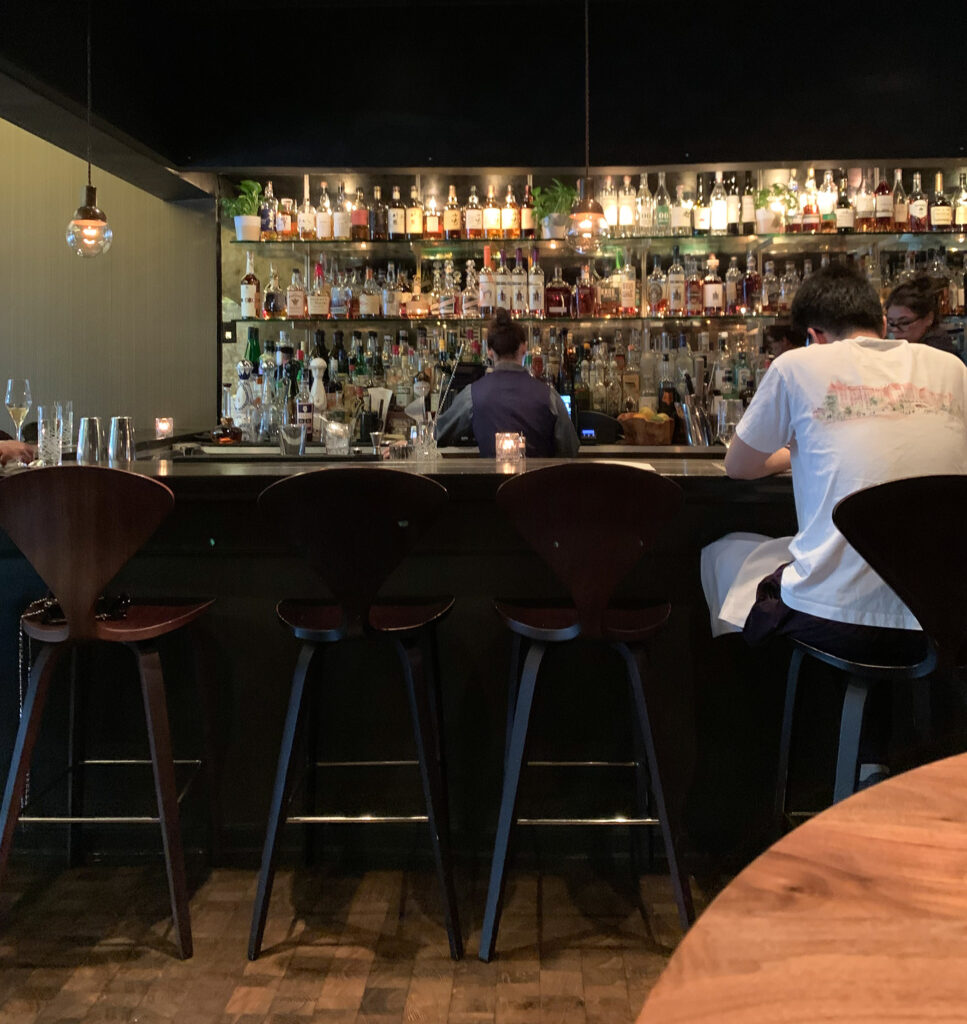
Making your way out of the hallway, you find yourself between the bar and the main dining room. The former, to your left, is defined by a dark brown counter with sleek, matching stools that seat up to 12. Behind the bar, two hanging rows of shelving glisten with coveted bottles while another three rows, arranged stepwise, line the base. On the opposite wall, you find two so-called “high-top” tables that actually each comprise a raised banquette that seats up to three. Combining the energy of the bar with an unmatched level of seclusion, this particular area stands as one of the great hidden gems of Chicago fine dining.
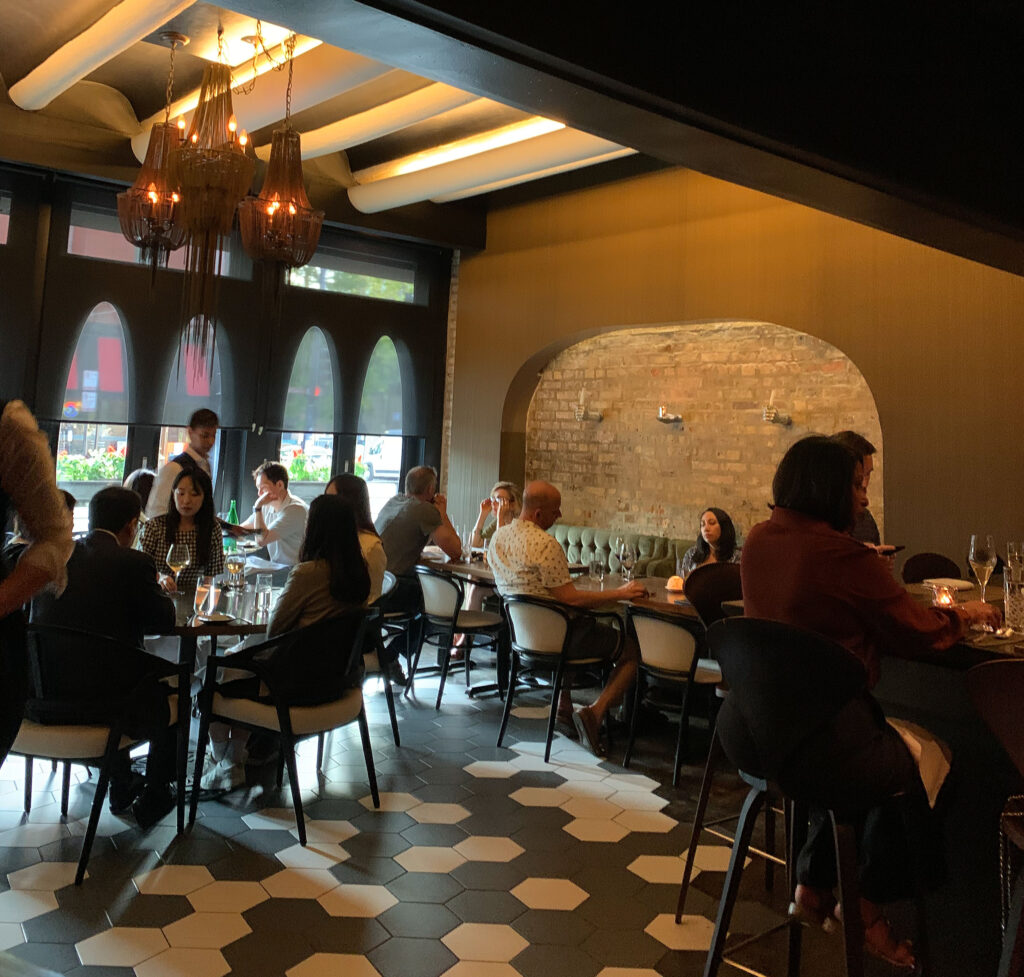
Moving past the bar to the end of the room, the grided wooden flooring (itself pleasantly worn) transitions to black and white hexagonal tiles that are scattered seemingly at random. This space, which abuts the windows looking out onto Halsted, is its own little haven. It contains two sets of two four-top banquettes that are set snugly beneath wooden arches that frame the building’s original brick walls. Sconces replicating human hands—two closed fists clutching candles and one open palm holding a jar—are affixed to each surface. A circular five-top, illuminated by a trio of beaded chandeliers, sits in the very middle of the floor. Finally, a pair of two-tops sit directly against the windows. This area makes up Boka’s lounge, which—while reserved for walk-ins—is so nicely appointed and intimate that you would hardly feel you are missing out by not being in the dining room proper.
Turning back toward the bar, you pass an alcove that leads to a staircase that leads down to the bathrooms. This area, no doubt, is where the building shows some of its age. However, some striking black-and-white wallpaper—rendered in a pattern of squares and concentric perpendicular lines—and matching black tile lend the space a refreshing Art Deco feel. These particular elements seem to be new additions that appeared some time after the major 2014 renovation, for the stairwell back then matched the rest of the restaurant’s design but still seemed rather plain. The visual effect goes a long way, especially paired with a couple plush armchairs, to make the subterranean space feel more like an extension of the luxury seen upstairs. Reaching the bottom, you may take a moment to appreciate the ungodly number of James Beard Award certificates and Michelin star plaques that line the walls. Otherwise, the lavatories themselves feel a bit humid and cramped. You even had trouble getting one toilet seat to stay in place. But these are small nitpicks that just about escape attention when the rest of the experience is going swimmingly.
Returning upstairs, you pass the bar and continue on through the dividers that frame the dining room. A service station, equipped with drawers, ice buckets, trays, all manner of wine bottles, and one or two flourishes of greenery, forms the focal point of the space. Above it, a grid of antique molding (quite possibly original to the building) attracts your eye. Its texture accentuates the subtle grided pattern of the wooden flooring and the ribbed wooden beams that stretch down from the ceiling and form arches along one of the walls. As in the lounge, these arches house a series of banquettes that each seat up to six guests spread across detachable two- and four-tops. Opposite them, you find rounded booths (corresponding somewhat to those “high-top” tables) that can also seat a half dozen guests in more snug, intimate confines. A couple more of them line the back wall while the remainder of the floor space is made up of a few standing four-tops.
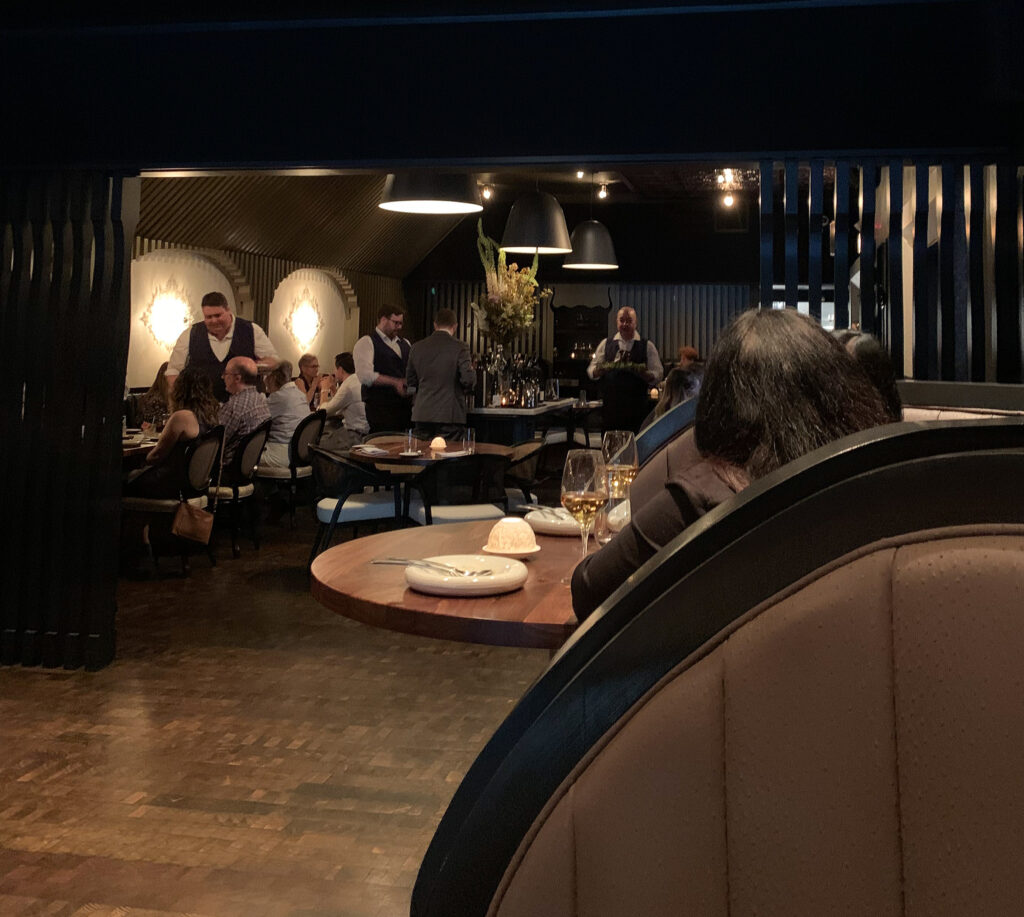
The wallpaper, leather seating, and tabletops throughout this dining room are all done in dark brown. Most of the chairs, too, feature dark wooden accents that surround off-white cushions. However, those located in the middle of the floor possess white wooden frames with darker colored cushions. This accentuates the white marble of the service station, the white wallpaper (and crystalline light fixtures) set in the arches between the banquettes, and the white frames surrounding the doors that lead into the adjacent dining space.
It is easy to say that, without those “fabric sculptures” and “marigold” tones of yesteryear, Boka’s dining room seems more serious and conventional than ever. The restaurant has certainly abandoned the more contemporary design that characterized the space for close to a decade. However, invoking something of a plain or subdued feeling in this principal room feels smart, for it asserts that—despite the zany tilling and artwork that distinguishes other rooms—there lies at the core of the concept a trusty, understated eating house. Ultimately, this dining room does not try to be much more than a warm, convivial space with plenty of room between parties and careful attunement to the practice of good service. In that respect, it does feel timeless, and it works—importantly—to ground some of the bolder aesthetic choices (seen elsewhere) that do run the risk of feeling dated.
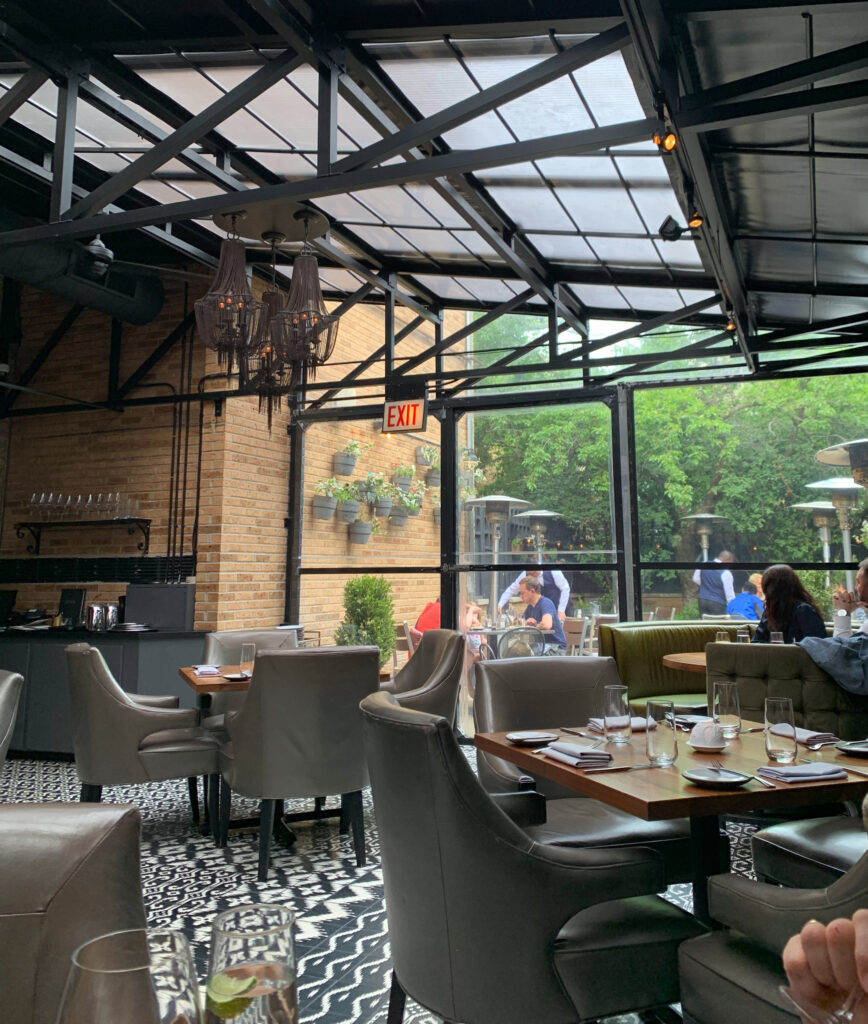
Nowhere does that question come more to the fore than in the secondary dining room that is located just beyond Boka’s host stand (visible through a set of double doors) but primarily accessed by walking through the main dining room and accessing a separate entrance. While comprising a fully closed structure, you think of this space as something of a greenhouse design given the largely windowed ceiling and sizable rear doors that lead out onto the restaurant’s back patio. The design scheme here more closely matches Boka’s entrance than the other dining room, featuring the same ikat-patterned concrete tile and a fanciful “living wall.” The portraits interspersed across the surface of that latter element are not of celebrities but of various animals—different species of birds and big cats—anthropomorphized in their own military regalia. Other details of note include the same beaded chandeliers seen in the lounge, the same booths seen in the main dining room, and a range of plush leather armchairs (also used in the lounge). The building’s original brick wall is also incorporated into the design—onto which is scrawled the (misattributed) Oscar Wilde quote (actually found to originate with advertising for the Menards chain of hardware stores), “Be Yourself. Everyone Else Is Already Taken.”
Finally, should you make your way out onto that back patio, you will find a small, fenced-in area that is about the size of the lounge. Still, it looks better than it sounds. A quartet of four-top tables with sturdy (yet comfortable) all-weather chairs make up the space. They are surrounded by trees, bushes, planters, and an array of hanging flowerpots with just enough outdoor lighting interspersed between them to make the entire scene grow beautifully in the twilight. This patio is so isolated and so intimately arranged that you could easily mistake it for a residential backyard, which makes for a rather intoxicating effect at this level of dining.
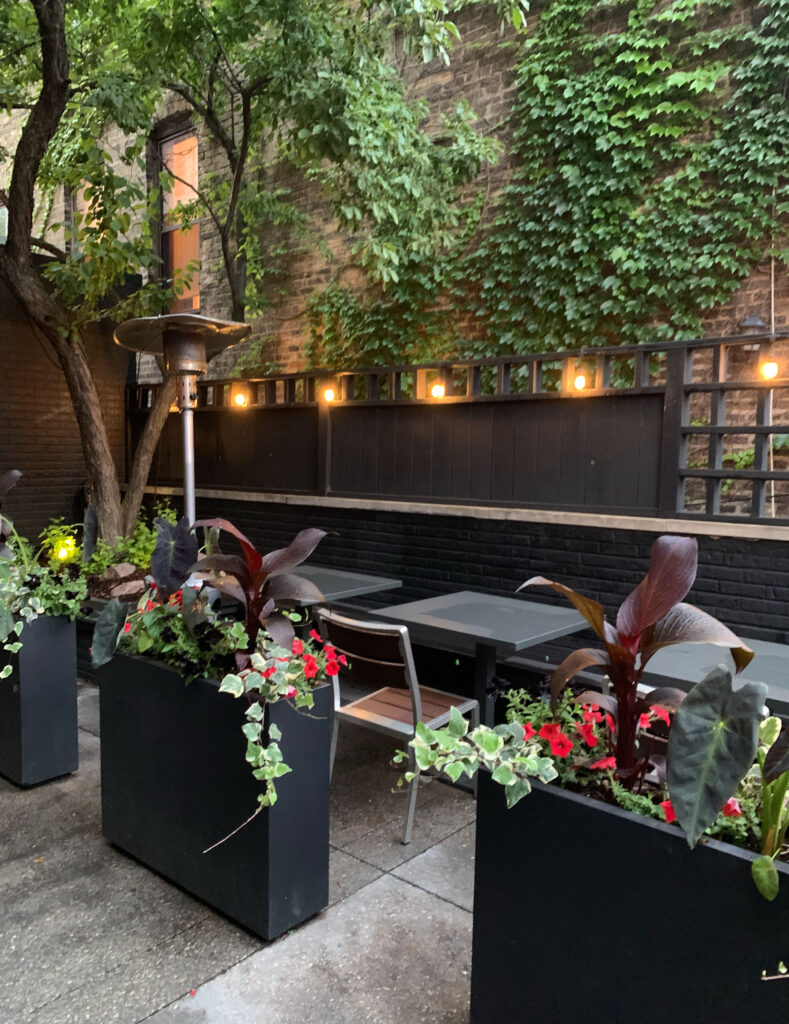
Overall, Boka’s ambiance is impressive at a structural level. While seeming a bit subdued from the outside, the restaurant immediately greets you with a dose of its personality upon walking through the door. The door hardware, concrete tiling, and pop culture references join with the attitude of the staff to ensure you are not at that cold, stiff kind of Michelin-starred establishment. As you make your way further inside, you find several delineated zones in which to dine: the bustling bar (with its two lovely high-tops), the front lounge (with its windows), the main dining room (with its classic, subdued mood), the “greenhouse” dining room (echoing the zaniness of the entrance), and the back patio (a garden oasis). You may even include the front patio that, while not always utilized, offers the chance to absorb some of the neighborhood’s energy from a streetside perch.
Each of these areas work well enough with each other, though there is a clear thread that connects the restaurant’s entrance, its lounge, the staircase heading to the bathrooms, and the “greenhouse” dining room. These are the accent spaces (whereas the bar, the main dining room, and both patios are more conventional). This contrast helps prevent Boka from seeming like a theme restaurant or, worse, a Bonhomme property. It empowers certain playful touches to catch your eye and feel special without adding to any larger sensory overload.
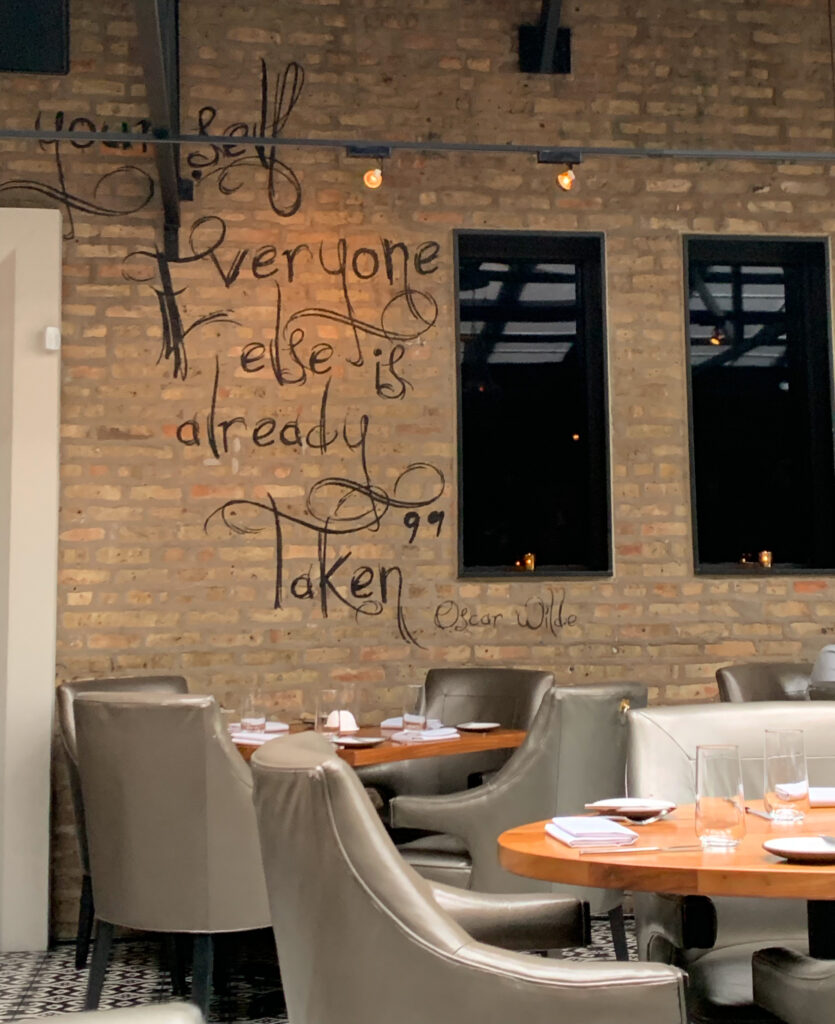
Sure, you think that the Murray and Grohl portraits, the hand-shaped sconces, the “Oscar Wilde” quote, the living wall, and its anthropomorphized animals come across as a bit tacky nearly a decade later. You think that all of these elements—save for the living wall—could be removed and that the restaurant would benefit from a greater degree of restraint. Such a change would allow simple differences in the color and texture of the various materials, as well as structural differences in the rooms themselves, to better distinguish the various spaces without such a heavy-handed resort to eye-catching baubles. However, once the sun goes down and Boka is bathed in warm lighting and the din of diners’ revelry, these colorful details become something more like Easter eggs. They are there to be discovered—not to take center stage—and cannot be faulted too harshly for seeming frozen in time. If misfiring, pretentious concepts like Alinea and Ever have taught you anything, it is that more personality is always better than less (and you don’t mean Thomas Masters or Matthew McConaughey).
Arriving at the table, you take your seat and are greeted, in short order, by the server. They welcome (and welcome back) your party before taking its water preferences and leaving you to decide on any further beverages.
That begins with cocktails—courtesy of bar manager Anna Thorn, who started as a bartender at Boka in 2018. Her selection, at present, includes eight standard creations (priced from $18-$20) and six under the “Reserve” heading (priced from $29-$36). (There was also, in honor of the restaurant’s 20th anniversary, a “Blue Boka” offered throughout June that reimagined one of the “beloved” original drinks from the concept’s opening menu.)
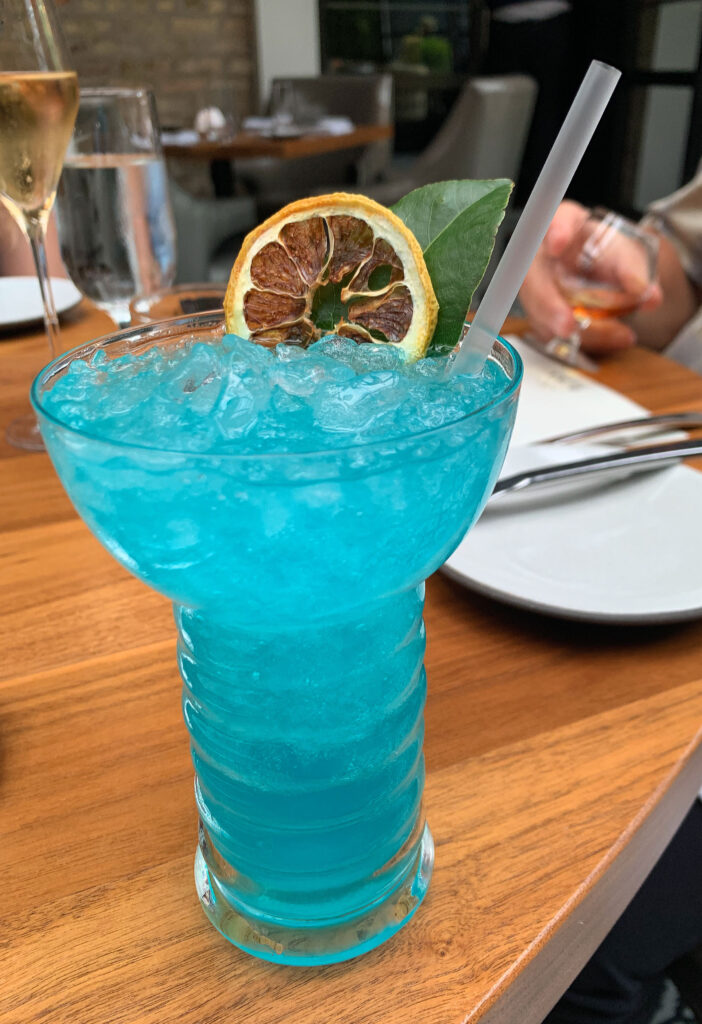
Having sampled a couple of the cocktails (and several of those ordered by others in your party), you find Thorn’s work to be impressive across the board. The drinks that make up her standard selection are filled with notes of passion fruit, orange, pineapple, grapefruit, and lime that are perfect for warmer weather. Of these, the “Goodbye Butterfly” (Espolón Reposado tequila, El Güel mezcal, red miso, black cardamom) and aforementioned “Blue Boka” special have been particular impressive, offering fine degrees of depth without ever seeming boozy or detracting from an overall sense of refreshment. You would also like to add that, despite not trying them, the “A Moveable Feast” (El Dorado 3-Year rum, William Hinton rum, Thai lime, pineapple) and “Tropical Itch” (Evan Williams bourbon, Smith & Cross rum, passion fruit) strike you as highly appealing.
Moreover, at a time when “reserve” cocktails have proliferated across every kind of restaurant to encourage greater spending, Thorn’s approach to the category is laudable. The drinks only cost about 50% more than those in the standard selection (making use of premium—but not altogether rare—ingredients), and both the “Margarita” (Comisario tequila, Grand Marnier, lime) and “Negroni” (Monkey 47 gin, Cappellano Barolo Chinato, Contratto Bitter) are simply excellent. These creations are a bit more spirit-forward than those you have previously mentioned, but they still avoid any perceivable alcohol and, rather, have impressed you with their superb balance and length (though the “Margarita” could use just a bit more citrus). Of course, classic cocktails can always be mixed, on request, using more quotidian spirits. Yet these reserve options, in your experience, are well worth splurging on to get an even fuller sense of the bar manager’s talent.
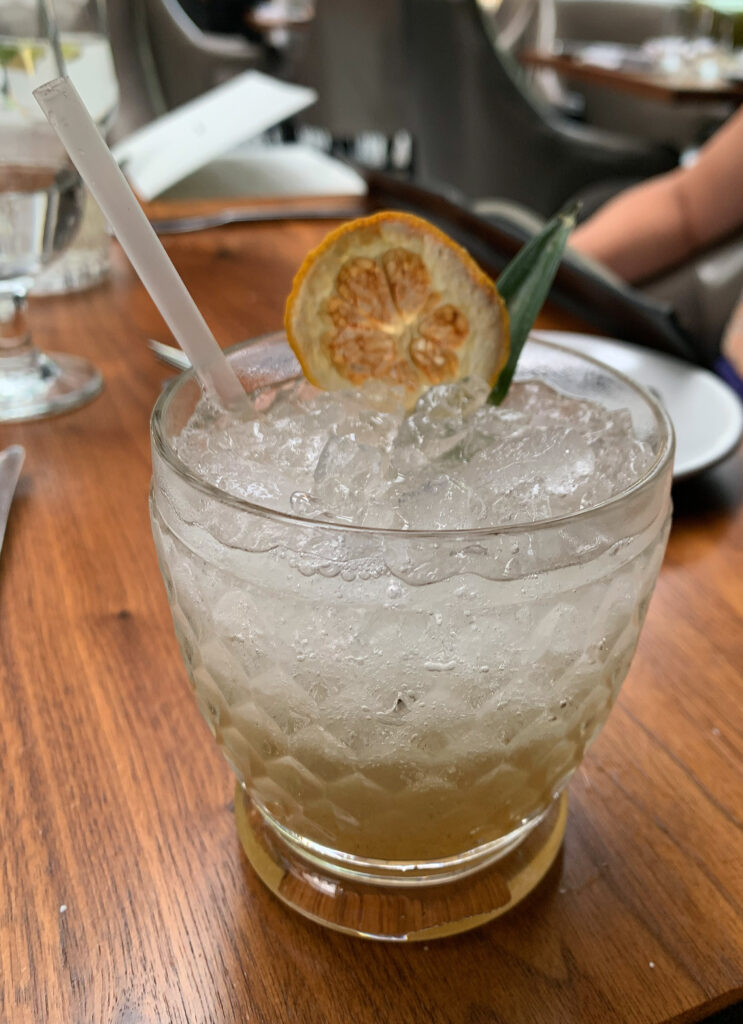
Even spirit-free options like a “Smoothie King” (Lyre’s Italian Orange, passion fruit, lemon) or a range of housemade sodas (ginger, Thai lime, pineapple, grapefruit, passion fruit) strike you as going above and beyond the norm (even at a Michelin-starred caliber). You sampled the pineapple soda and found its combination of sweetness, tartness, acidity, and fizz to be far superior than the Crush or Fanta versions of the flavor (no mean feat when it comes to pure hedonism).
The remainder of the beverage program comprises beers from local breweries like Middle Brow, Pollyanna, and Big Drop joined by a couple from South Carolina (Westbrook Brewing) and Indiana (Upland Brewing Co.) and a cider from Vermont’s Shacksbury. There is also an extensive spirits list featuring estimable producers like Caol Ila, Chichibu, Elijah Craig, Michter’s, Old Fitzgerald, Springbank, Willett, and Yamazaki. Finally, you find a selection of four “After Dinner Cocktails” (the La Colombe-based “Iced Irish Coffee” and “Espresso Martini” being the most familiar) alongside a wide range of amari and a particularly special feature: Domaine Roulot’s excellent “le Citron” lemon liqueur—quite a rarity!
Overall, Thorn’s work with Boka’s beverage program is highly commendable. There is plenty to discover—technically perfect but always approachable—to such an extent that even you cannot help imbibing. That is particularly impressive given just how much there is to digest with regard to your principal love: fermented grape juice.
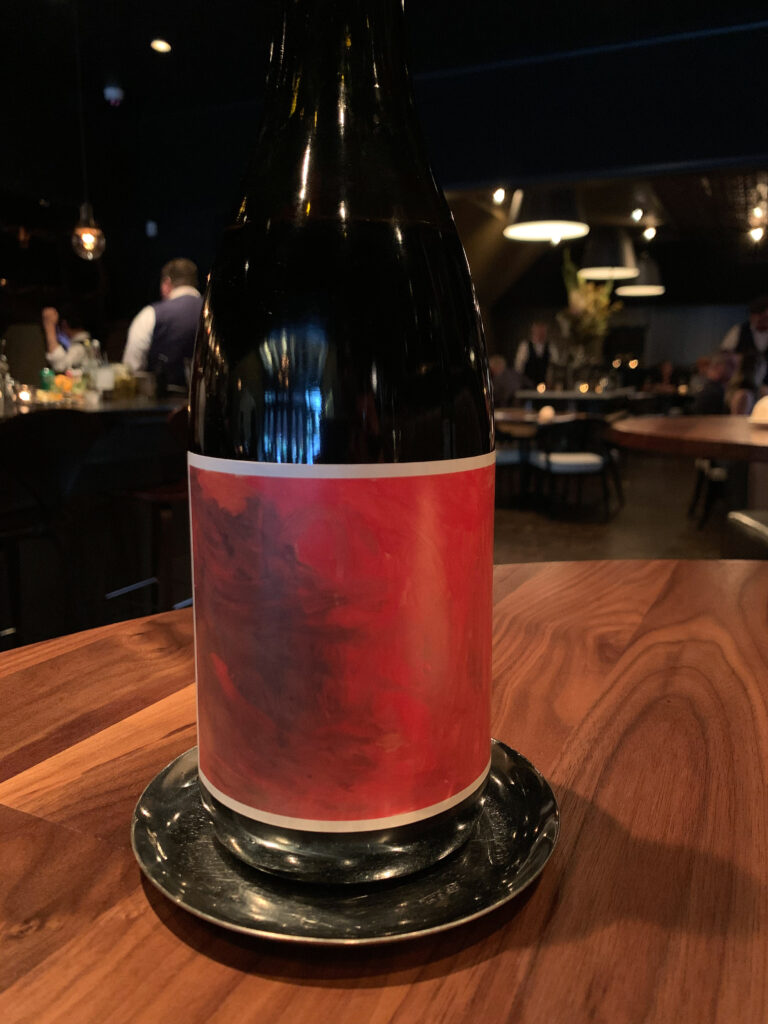
Wine director Thibaut Idenn is currently in charge of Boka’s program, having now been in the role for a little more than a year and, before that, working as the restaurant’s general manager for a year too. Prior to joining BRG (where he also oversees Alla Vita), he spent close to three years as beverage manager (later director) of The Langham and a year at the Sofitel Chicago. Originally from Champagne, Idenn holds an MSc in International Hospitality Management from Lyon’s EMLYON Business School (in partnership with Institut Paul Bocuse) with a specialization in International Wine and Beverage Management. He also worked, among a range of experiences in France, at the three-Michelin-star Alain Ducasse au Plaza Athénée. On paper, Idenn seems like one of the most pedigreed hospitality professionals, and, in practice, that definitely holds true.
Boka’s by-the-glass selection, during his tenure, has included wines like:
Sparkling
- La Gioiosa Prosecco di Valdobbiadene Superiore Brut ($15)
- Laurent Perrier “Cuvée Rosé” Champagne ($39)
- Etienne Calsac “L’échappée Belle” Blanc de Blancs Champagne ($30)
- 2014 Michel Gonet Blanc de Blancs Champagne Grand Cru ($35)
White
- 2022 Coralie & Damien Delecheneau “Trinqu’âmes” Sauvignon Blanc ($18)
- 2020 Malat “Ried Höhlgraben” Grüner Veltliner ($18)
- 2016 Gallica “Rorick Heritage Vineyard” Albariño ($21)
- 2021 Ferrando “La Torrazza” Erbaluce ($19)
- 2021 Ovum “Old Love” Riesling Blend ($16)
- 2021 Keller “Limestone” Riesling ($21)
- 2017 Charles Hours “Cuvée Marie” Gros Manseng ($19)
- 2020 Marielle Michot “M” Pouilly-Fumé ($18)
- 2020 Les Héritiers du Comte Lafon Mâcon-Milly-Lamartine ($22)
- 2017 Minimus “Dijon Free” Chardonnay ($25)
Rosé
- 2021 Finca Enguera “Rosado” Tempranillo ($14)
Red
- 2020 Enderle & Moll “Liaison” Pinot Noir ($22)
- 2021 Chacra “Barda” Pinot Noir ($22)
- 2021 Roagna Dolcetto d’Alba ($22)
- 2021 Jordi Raventós Clos dels Guarans “Les Someres” Grenache ($16)
- 2020 Sara Pérez i René Barbier, Dido “La Universal” Grenache ($18)
- 2019/2021 Julien Cécillon “Les Graviers” Syrah ($16)
- 2016 La Chapelle de Meyney St-Estèphe ($30)
While these bottles have not appeared on the list all at once, looking at them in sum reveals a clear pattern. First, Idenn is adept at giving his customers what they want (Champagne, Sauvignon Blanc, Chardonnay, Pinot Noir, Cabernet) while simultaneously showcasing the sort of oddballs (Grüner, Erbaluce, Gros Manseng, Dolcetto) that invite a conversation and, thus, customer education. Second, the wine director knows how to provide pure value—a $15 Prosecco, a $16 Riesling, a $14 rosé, a $16 Grenache, a $16 Syrah—while, for those willing to spend a little more, delivering producers that punch way above their weight: the Etienne Calsac, Michel Gonet, Keller, Les Héritiers du Comte Lafon, Minimus, Enderle & Moll, Chacra, and Roagna all being extraordinary choices that you would be thrilled to drink anywhere. (Even the La Chapelle de Meyney, though you are not familiar with it, looks to be about as good a young Bordeaux as you could hope to find on such a list.) Lastly, Idenn seems just as comfortable sourcing great wines from classic regions (Pouilly-Fumé, Alba, the Northern Rhône, Médoc) as he does finding counterparts from unexpected places: California Albariño, Oregon Riesling, German Pinot Noir, Catalonian Grenache.
In short, Idenn has put together what you consider to be one of the best—if not the best—by-the-glass selection in Chicago. It contains the kind of bottles that make you, as an experienced oenophile, do a double take, which means the uninitiated are in for quite a treat. By marshalling Boka’s resources in order to offer great wines at an accessible price, the wine director does a commendable job of enriching vinous appreciation in Chicago.
As a supplement to the restaurant’s “Seven Course Tasting Menu” ($165), Idenn offers two turnkey options: the “Standard Wine Pairing” ($80) and the “Reserve Wine Pairing” ($160). Of these, you have only tried the latter, which has comprised the following bottles:
- Lilbert & Fils Blanc de Blancs Champagne Grand Cru
- 2020 Weingut Beurer “Alte Reben” Silvaner
- 2018 Henry Marionnet “Provignage” Romorantin
- 2016 Tenuta di Fiorano “Alberico Bianco” Sémillon
- 2020 Parés Baltà “Electio” Xarel-lo
- 2018 Maison Stéphan “Côteaux de Bassenon” Côte-Rôtie
- 2008 Closerie du Pelan Francs-Côtes-de-Bordeaux
- Jorge Ordoñez & Co. “Victoria N°2”
- Domaine du Mas Blanc Banyuls “Collection 1978”
First, you must praise the simplicity and affordability of these pairings. They comprise only two options that avoid using any weasel words (to entice customers into choosing a more premium option for a “once-in-a-lifetime” meal) and that roughly correspond to half or the full price of the tasting menu. These sums allow guests to draw on Idenn’s experience in an approachable manner ($80) or splurge on something a bit more special ($160) without compromising the sense that Boka is a neighborhood where wine appreciation is a bonus but by no means an expectation.
That being said, it is the substance of the “Reserve Wine Pairing” that really impresses you. $160 is around where the standard pairings at pricier fine dining restaurants land, so utilizing that sum to offer a selection that guests perceive as “premium” demands a bit of strategizing. Idenn displays a masterful understanding of the peak-end rule, as well as the tastes of mainstream consumers, when he weighs the pairing toward Champagne and red wines. The Libert & Fils Blanc de Blancs, made using grand cru fruit sourced from old vines Cramant, is served in half bottle (which helps to accelerate aging) and offers a quintessential expression of a pristine, razor-sharp Chardonnay-based sparkler. The Maison Stéphan Côte-Rôtie is made from organically grown Syrah that is fermented whole cluster and bottled without sulfur, making for an example of the burly grape that is uncommonly open and absolutely bursting with flavor at such a young age. Finally, the 2008 Closerie du Pelan is made from traditional Bordeaux varieties that are organically grown and offers an uncommon degree of age, accessibility, and value for the region (courtesy of a late-release program after the property’s purchase by Le Puy).
These are three showstopping bottles that ensure the sort of diner that is inclined to pay for the reserve pairing feels they have gotten their money’s worth. And you say that as a lover of Burgundy (and of its white wines in particular). Offering bottles of value from that coveted region has never been more difficult, and there is a good chance that Chicago diners (a population that still seems to prefer bolder reds) would not appreciate the outsize spending required to do so. Instead, Idenn smartly marshals his resources toward headlining pours that will please amateurs and snobs alike.
As for the rest of the selection, the wine director finds value—effectively padding the more expensive bottles—with obscure varieties like Silvaner, Romorantin (a completely new one for you), Sémillon, and Xarel-lo. This is sensible, for you think most white wine drinkers would be open to trying new grapes that share some of the same characteristics (acidity, oak influence) as their usual favorites while lovers of Champagne or Cabernet really want the “real thing.” Plus, these varieties once more provide Idenn and his staff with an opportunity to educate even moderately experienced drinkers with a whole host of information relating to terroir and winemaking that they may carry into future experiences. All the while, they remain broadly refreshing and, thus, easy to enjoy.
When it comes to dessert, the wine director brings forth crowd-pleasing pours of the Ordoñez & Co. “Victoria N°2” (a late harvest Muscat of Alexandria) and Banyuls “Collection 1978” (a Port-like fortified wine made with old-vine grenache). These bottles offer all the sappy sweetness one might desire at the end of the meal at a fraction of the cost one would pay for famous names like Sauternes, Trockenbeerenauslese, or Eiswein. Once more, their relative obscurity—and hedonistic appeal—invites a rewarding conversation about how these sweet wines are made.
Overall, as with Boka’s by-the-glass selection, Idenn has done an exceptional job with the “Reserve Wine Pairing.” His selection is intelligent but still totally approachable and satisfying (even for a snob) at that $160 price. It ranks as one of the best you have seen in the city and reminds you that pairings—so frequently tacked on for the hell of it—can still offer pleasant surprises even when you are so used to picking out your own wine.
That leads you, at long last, to the main event: the bottle list. You have already surveyed the countless illustrious producers that have graced Boka’s cellars over the decades and still find a lot to like. Here are some notable selections that have appeared over the past year:
Sparkling
- NV Etienne Calsac “Les Revenants” Brut Nature ($265)
- NV Roger Coulon “Heri-Hodie Brut” Premier Cru ($142)
- NV Dhondt-Grellet “Les Terre Fines” Blanc de Blancs Premier Cru Extra Brut ($252)
- NV Egly-Ouriet “Les Vignes de Bisseuil” Premier Cru ($266)
- 2011 Egly-Ouriet “Cuvée de Prestige Millésimé” Grand Cru Brut ($580)
- NV Egly-Ouriet “VP” Grand Cru Extra Brut ($376)
- NV Egly-Ouriet “Les Crayères” Blanc de Noirs Grand Cru Brut Vieilles Vignes ($625)
- NV Pierre Gerbais “Champ Viole” Blancs de Blanc Extra Brut ($205)
- NV Jacquesson “Cuvée 744” Extra-Brut ($235)
- NV Krug “Grande Cuvée 170ème Edition” ($499)
- NV George Laval “Cumière” ($240)
- NV George Laval “Cumière Rosé” ($592)
- NV Les Frères Mignon “L’Aventure” Blanc de Blancs Premier Cru Extra Brut ($198)
- 2018 Roses de Jeanne “Haute Lemblée” Blancs de Blanc Brut ($325)
- NV Frédéric Savart “L’Ouverture” ($185)
- NV Vouette & Sorbée “Fidèle” Brut Nature ($249)
- 2012 Veuve Clicquot “La Grande Dame” ($370)
White
- 2019 Arnot-Roberts “Trout Gulch Vineyard” Chardonnay ($116)
- 2020 Domaine Bernard-Bonin “La Rencontre” Meursault ($463)
- 2021 Thibaud Boudignon Anjou Blanc ($104)
- 2016 Clos Rougeard “Brézé” ($460)
- 2018 Domaine du Collier Saumur Blanc ($138)
- 2021 Pascal Cotat “La Grande Côte” ($236)
- 2021 François Cotat “La Grande Côte” ($193)
- 2021 François Cotat “Les Monts Damnés” ($193)
- 2021 François Cotat “Culs de Beaujeu” ($209)
- 2019 Benoit Ente “Antichtone” Bourgogne Aligoté ($85)
- 2019 Pierre Vincent Girardin “Eclat de Calcaire” Bourgogne Blanc ($105)
- 2020 Domaine Guiberteau “Les Moulins” ($117)
- 2018 Domaine Guiberteau “Brézé” ($200)
- 2015 Domaine Guiberteau “Brézé” ($250)
- 2021 Emrich-Schönleber “Mineral” Trocken ($100)
- 2019 Domaine Huet “Le Mont Demi Sec” ($130)
- 2019 Keller “Abts E® Westhofener Brunnenhäuschen GG” ($664)
- 2019 Keller “Dalsheimer Hubacker GG” ($774)
- 2019 Keller “G-Max” ($2000)
- 2019 Keller “Nieder-Flörsheimer Frauenberg GG” ($987)
- 2019 Keller “Niersteiner Hipping Kabinett Goldkapsel” ($987)
- 2019 Keller “Niersteiner Pettenthal Kabinett Goldkapsel” ($987)
- 2020 Keller “Von der Fels Trocken” ($136)
- 2021 Keller “Von der Fels Trocken” ($130)
- 2020 Keller “Westhofener Kirchspiel GG” ($794)
- 2019 Keller “Westhofener Morstein GG” ($774)
- 2021 Kelley Fox “Durant Vineyard Lark Block” Chardonnay ($110)
- 2018 Domaine Hubert Lamy “La Princée” Saint-Aubin ($159)
- 2017 Domaine des Comtes Lafon “Clos de la Baronne” Meursault ($479)
- 2019 Domaine Leflaive Bourgogne Blanc ($277)
- 2019 Domaine Leflaive “Clavoillon” Puligny-Montrachet Premier Cru ($655)
- 2020 Domaine Leflaive “Les Chênes” Mâcon-Verzé ($198)
- 2017 Lingua Franca “Bunker Hill” Chardonnay ($135)
- 2017 Dr. Loosen “Alte Reben Urziger Wurtzgarten Trocken GG” ($118)
- 2022 Massican Sauvignon Blanc ($102)
- 2018 Matthiasson Ribolla Gialla ($120)
- 2017 Domaine Bernard Moreau “Sur Gamay” Saint-Aubin Premier Cru ($195)
- 2021 Domaine Moreau-Naudet Chablis ($125)
- 2020 Domaine François Raveneau “Butteaux” Chablis Premier Cru ($995)
- 2021 Ronco del Gnemiz “San Zuan” Friulano ($150)
- 2018 Domaine Roulot Meursault ($555)
- 2017 François Rousset-Martin “Terres blanches” ($146)
- 2021 Sandhi Chardonnay ($68)
- 2020 Domaine de Trévallon Blanc ($310)
- 2019 Domaine Vacheron “Le Paradis” ($198)
- 2021 Vietti “Roero” Arneis ($68)
- 2020 Williams Selyem “Unoaked Chardonnay” ($186)
Red
- 2019 Thierry Allemand “Chaillot” ($685)
- 2020 Château de Beaucastel ($325)
- 2012 Giacomo Borgogno & Figli Barolo Riserva ($685)
- 1996 Giacomo Borgogno & Figli Barolo Riserva ($895)
- 1982 Giacomo Borgogno & Figli Barolo Riserva ($1268)
- 2016 Clos Rougeard Saumur-Champigny ($340)
- 2016 Clos Rougeard “Les Poyeux” Saumur-Champigny ($480)
- 2019 Colgin Cellars “Jubilation by Colgin” ($620)
- 2018 Domaine du Collier “La Ripaille” Saumur ($146)
- 2019 Aldo Conterno “Il Favot” Langhe Nebbiolo ($119)
- 2018 Domaine Marquis d’Angerville “Champans” Volnay Premier Cru ($580)
- 2020 Domaine Dujac Chambolle-Musigny ($400)
- 2016 Eisele Vineyard Syrah ($425)
- 2020 Envinate “Lousas, Viñas de Aldea” ($116)
- 2020 Domaine Fourrier “Combe aux Moines” Gevrey-Chambertin Premier Cru ($796)
- 2020 Domaine Pierre Vincent Girardin “Les Hauts Beaumonts” Vosne-Romanée ($347)
- 2018 Alain Graillot Crozes-Hermitage ($115)
- 2019 Domaine Anne Gros “La Combe d’Orveau” Chambolle-Musigny Premier Cru ($625)
- 2020 Domaine Anne Gros “Les Loachausses” Echezeaux Grand Cru ($615)
- 2017 Heitz Cellar Cabernet Sauvignon ($155)
- 2016 Domaine Jamet “Fructus Voluptas” ($355)
- 2018 Kelley Fox Wines “Weber Vineyard” Pinot Noir ($195)
- 2018 Matthiasson “Dead Fred” Cabernet Sauvignon ($250)
- 2005 Mayacamas Vineyards Cabernet Sauvignon ($565)
- 2018 Montevertine “Le Pergole Torte” ($476)
- 2016 Domaine Arnaud Mortet Gevrey-Chambertin ($217)
- 2020 Domaine Georges Mugneret-Gibourg Vosne-Romanée ($350)
- 2019 Domaine Nicolas-Jay “Own Rooted” Pinot Noir ($244)
- 2019 Philippe Pacalet “Aux Chaignots” Nuits-Saint-Georges Premier Cru ($354)
- 2018 Peay Vineyards “Ama” Pinot Noir ($145)
- 2014 Emidio Pepe Montepulciano d’Abruzzo ($375)
- 2009 Château Pichon Longueville Comtesse de Lalande ($745)
- 2019 Château Le Puy “Emilien” ($145)
- 2016 Roagna “Faset” Barbaresco ($334)
- 2021 Rivers-Marie Pinot Noir ($110)
- 2017 Domaine Armand Rousseau “Clos du Chateau Monopole” Gevrey-Chambertin ($650)
- 2018 Domaine Armand Rousseau “Lavaux St Jacques” Gevrey-Chambertin Premier Cru ($925)
- 2017 Sine Qua Non “The Gorgeous Victim” Grenache ($590)
- 2018 Shafer “Hillside Select” ($782)
- 2020 Maison Stephan “Les Binardes” ($280)
- 2011 Château des Tours ($255)
- 2019 Domaine de Trévallon ($235)
- 2020 Whitcraft “La Lie Fine” Gamay ($67)
- 2020 Williams Selyem “Ferrington Vineyard” ($359)
As has been the case throughout Boka’s history, the restaurant’s cellar combines legendary producers like Allemand, d’Angerville, Clos Rougeard, Dujac, Egly-Ouriet, Jamet, Keller, Krug, Lafon, Leflaive, Mugneret-Gibourg, Raveneau, Roulot, Rousseau, and Shafer with more up-and-coming talents like Bernard-Bonin, Domaine du Collier, Roger Coulon, Benoit Ente, Envinate, Pierre Vincent Girardin, Rivers-Marie, Roagna, and Maison Stephan. However, while there are some attractive values that land in the $100-$150 range, most of these bottles—however glamorous the labels or how rarely they are seen in Chicago—are priced in a totally prohibitive manner.
Of course, you cannot expect BRG to give these wines, most of which will improve (and appreciate in value) over time, away. But a fine dining restaurant that is consciously cultivating the feeling of being a neighborhood joint must be sensitive to how its customers may perceive pricing on bottles that can be found elsewhere in the city.
To name a few examples:
- The Etienne Calsac “Les Revenants” Brut Nature ($265) can be found for $235 at Smyth.
- The Egly-Ouriet “Les Vignes de Bisseuil” Premier Cru ($266) can be found for $191 at Oriole.
- The Egly-Ouriet “VP” Grand Cru Extra Brut ($376) can be found for $325 at Smyth.
- The Krug “Grande Cuvée 170ème Edition” ($499) can be found for $384 at Oriole.
- The Frédéric Savart “L’Ouverture” ($185) can be found for $165 at Smyth.
- The 2020 Domaine Bernard-Bonin “La Rencontre” Meursault ($463) can be found for $375 at Obélix.
- The 2021 Pascal Cotat “La Grande Côte” ($236) can be found for $195 at Obélix.
- The 2020 Keller “Von der Fels Trocken” ($136) can be found for $105 at Oriole.
- The 2017 Domaine des Comtes Lafon “Clos de la Baronne” Meursault ($479) can be found for $260 at The Purple Pig.
- The 2022 Massican Sauvignon Blanc ($102) can be found for $85 at Obélix.
- The 2020 Domaine François Raveneau “Butteaux” Chablis Premier Cru ($995) can be found for $500 at The Purple Pig.
- The 2019 Thierry Allemand “Chaillot” ($685) can be found for $500 at Obélix.
- The 1982 Giacomo Borgogno & Figli Barolo Riserva ($1268) can be found for $682 at RPM Steak.
- The 2018 Domaine Marquis d’Angerville “Champans” Volnay Premier Cru ($580) can be found for $325 at Obélix.
- The 2020 Domaine Dujac Chambolle-Musigny ($400) can be found for $380 at Gibsons Italia.
- 2016 Domaine Jamet “Fructus Voluptas” ($355) can be found for $275 at Oriole.
- The 2005 Mayacamas Vineyards Cabernet Sauvignon ($565) can be found for $445 at Smyth.
- The 2018 Montevertine “Le Pergole Torte” ($476) can be found for $260 at The Purple Pig.
- The 2009 Château Pichon Longueville Comtesse de Lalande ($745) can be found for $625 (2010 vintage) at Bazaar Meat.
- The 2018 Shafer “Hillside Select” ($782) can be found for $634 at Joe’s.
Now, most diners will not possess an encyclopedic knowledge of which restaurants are charging less for the same wine. However, they will widely be used to spending a certain sum ($100, $200, $300) in a particular category (Pinot Noir, Cabernet) and likely find themselves feeling squeezed. For it is easy to get all starry-eyed seeing legendary producers on offer but much harder to stomach paying somewhere between two and three times the retail price for the pleasure of enjoying a bottle at your “anytime you have time” neighborhood spot.
Yes, a markup of twice the retail price is nothing new when it comes to wine. But Boka seems totally comfortable pushing toward that tripled sum as if they were a craven Chicago steakhouse and not a gastronomic destination. The restaurant is also comfortable continually revising its prices upward in line with what the market will bear (namely with regard to the Keller) rather than abiding by its original (rather generous) markup and possibly letting some customer snag a deal. In truth, Boka is making as much as three, four, or even five times what it paid wholesale for many of these wines while, simultaneously, failing to stock an adequate number of $100-$150 bottles that continue to provide top value even under such an exorbitant system: your entry-level Pierre Péters, Ganevat, Labet, Tissot, Valette, Tempier rosé, Phelan Farm, Sylvain Pataille, Walter Scott, and the like.
You cannot blame Idenn entirely for this situation given that such a pricing scheme is set at the top, across a range of properties, in such a manner that leaves you wondering if Levy has been rubbing off on BRG in the wrong way. (Spiaggia’s markups, back in the day, were positively eye-watering but, over time, could grow to be tolerable as bottles aged and fell behind their secondary market average.) In fact, Burgundy pricing is so crazy that a few wines—even with Boka’s premium added in—do still provide an attractive value relative to what you would have to pay at retail. For example, the 2020 Domaine Bernard-Bonin “La Rencontre” Meursault ($463) is being sold for $499 online and the 2020 Mugneret-Gibourg Vosne-Romanée ($350) is being sold for $389. Nonetheless, these are more like happy accidents rather being indicative of a real desire to put great juice in people’s glasses.
Ultimately, on the back of such strong by-the-glass and pairing options, you expected Boka’s bottle list to thrive under Idenn. Yet, while the wine director is buying the right producers (ones that, barring any later revision of pricing, can age into becoming good values), his selection fails to offer much immediate pleasure. Browsing the restaurant’s list is not like uncovering a treasure trove—as a few wondrous places make you feel—but more like being forced to strike a dire compromise. You quickly realize you are going to be paying a little more for the level of quality you have come to expect elsewhere or paying a lot more for a unique bottle you can actually get excited about. When you factor in that most of the options are too young to really be enjoyed, it often seems wisest to spend less than what you might usually allocate toward wine and settle on a simple Bourgogne blanc or rouge rather than allowing yourself to be milked.
In short, Boka’s wine list punishes—rather than celebrating—connoisseurs by charging such a high premium without providing nearly enough hidden gems to reward knowledgeable drinkers with some degree of value. These markups, when judged relative to the restaurant’s fine dining peers, reveal a group that views oenophiles as rich snobs to be taken advantage of rather than loyal, high-spend customers to be cultivated. Forget about dining frequently to enjoy desirable bottles at a fair price alongside Wolen’s stalwart American fare. The pricing scheme actually works to put more pressure on the kitchen by raising expectations (in line with a higher total cost) and removing any advantage that a good wine—one you are really excited to drink—provides food that is totally unassuming. EMP, after all, was as much about wine and hospitality as it ever was about cuisine. At Boka, Idenn’s talent almost seems wasted by a group that only sees its bottle list as a profit center without any larger influence on the restaurant’s (nay, the city’s) dining culture.
Still, you are happy to report that the restaurant does, at least, allow corkage for a fee of $50 per bottle (maximum of two). This falls in line with Chicago’s other one- and two-Michelin-star establishments (as well as many of the more premium steakhouses) and strikes you as fair when considering that Boka’s by-the-glass and pairing options represent attractive value propositions for those looking to spend less. Connoisseurs, thus, can assuage any pain they feel when browsing the wine list by simply bringing their own aged bottle to dinner. This provides an avenue to enjoy Wolen’s food in a more familiar, routine manner without paying through the nose for your favorite appellation on each occasion. The restaurant also kindly waives corkage with the purchase of a bottle from its list—a gesture that you consider a best practice but that, lamentably, is not always followed (even at the highest level).
Overall, you feel that Boka’s approach to pricing undermines its (self-proclaimed) status as “one of Chicago’s most iconic restaurants” by marking the establishment as somewhat embalmed—resting on a decaying reputation—rather than looking to offer a competitive, captivating drinking experience. Still, Idenn’s good work undoubtedly shines through. You would place the wine director on a short list—Nick Berggren (The Purple Pig), Kevin Bratt (Joe’s), Richard Hanauer (RPM), Nicolas Poilevey (Obélix), Alex Ring (Sepia), Michael Seward (Pops for Champagne), Christian Shaum (Bazaar Meat), Emily Sher (Elske), and Emily Rosenfeld (Oriole)—of professionals working in restaurants who are sustaining Chicago’s wine culture during one of its darkest periods. This does not only have to do with selecting the right bottles or pricing them accordingly (the latter often being controlled, again, at a corporate level) but fostering the right attitude in the dining room.
Idenn’s love of wine is palpable. Yes, he possesses a great breadth of knowledge and marries that with an ebullient charm, a level of linguistic flourish, that can only belong to a dyed-in-the-wool Frenchman. It is a pleasure to listen to the wine director talk about his own selections, share in the excitement (as well as a taste) of a bottle you have brought in, and offer you a suggestion of some up-and-coming producer to seek out. Yet oenophiles like yourself form a willing audience—always desperate to indulge in the depths of their geekery with someone who shares in the hobby.
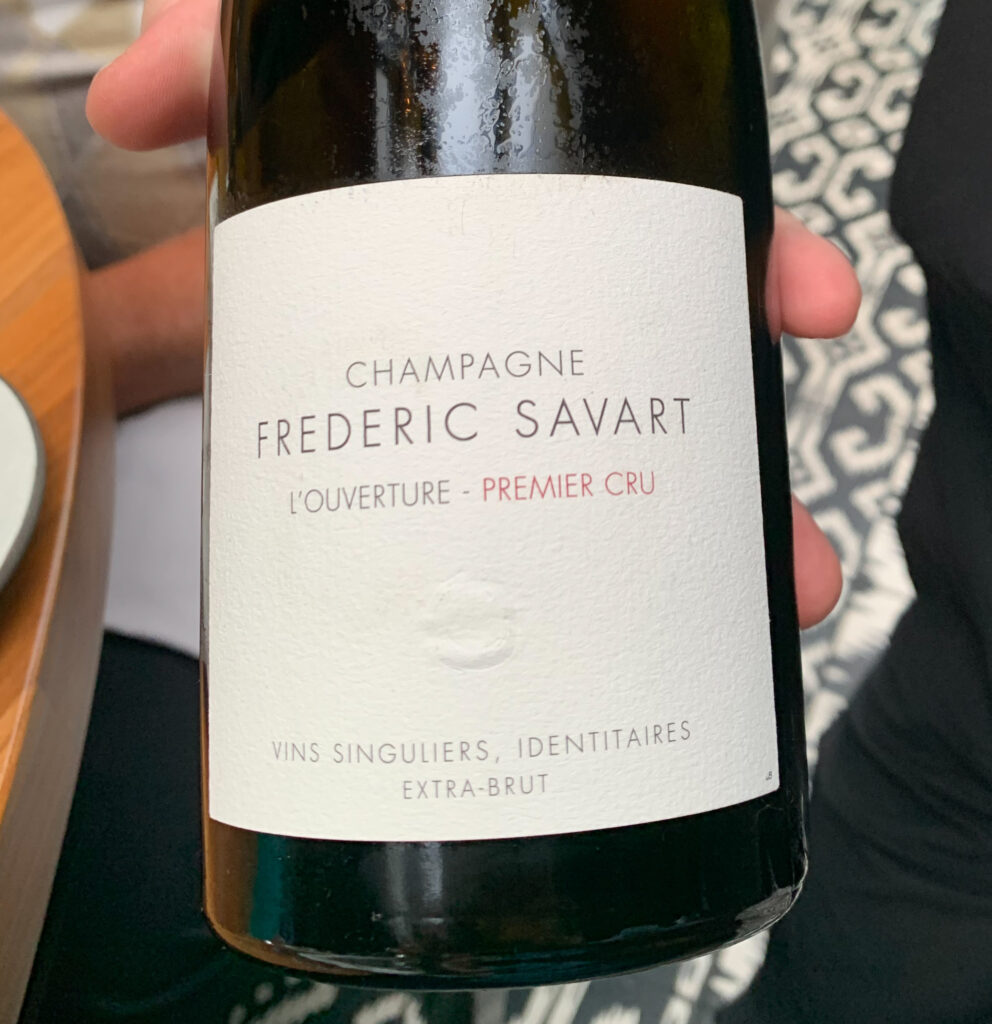
So, it is seeing how Idenn presents wine to less knowledgeable customers—always deferentially, never snobbishly, with every effort to transmit his passion in morsels the uninitiated will understand—that really impresses. The same goes for how he trains his staff. When a mere server happens to arrive with your next pairing, they do not trip over themselves reciting a few shallow buzzwords. Rather, they reflect all the same fluency and storytelling verve as their wine director. They forge, as he does, a moment of intimate hospitality and burgeoning excitement that truly does enrich your enjoyment of the pour. Another server, for example, may even comment on the Frédéric Savart “L’Ouverture” you ordered and reveal that Idenn led the staff in a tasting of the Champagne not long ago. This training, once more, allows them to share in your experience not as a mere employee but a proper host that can speak, firsthand, to the quality of their wares. These interactions are where, even if the pricing of Boka’s bottle list leaves something to be desired, Idenn shows his class and really works to cultivate wine appreciation in Chicago.
Arguably, training the staff to confidently conduct wine service and communicate the nuances of by-the-glass and pairing selections (if not actual bottles from the list), represents one of the highest pinnacles of hospitality. At Boka, it forms the cherry on top of an overarching warmth that begins—as you recall—with the tone set by the hostesses and is maintained by leaders like Thorn, Idenn, and general manager Devin Drerup. However, it is really the servers and, especially, the bussers that drive it all home.
These frontline staff are simply unflappable and, moreover, totally empowered to pause, sense your style of personality, and really forge some emotional connection during the course of your meal. Some of the little details are nice: bussers who greet you by name, who amply offer additional bread, who provide you with club soda when spying you trying to treat a stain. Other details, no doubt, can escape attention: the left-handedness of one member of your party or the “plumber’s crack” that one of the servers proudly displays in going about their duties. But these minor missteps, in truth, fall by the wayside when the overall energy is so intoxicating. The staff simply brims with positivity and achieves a standard—if not always technically then emotionally—that matches any top restaurant in Chicago.
For Boehm, Katz, and the wider Boka Restaurant Group, this stands as a great honor: one that affirms their crown jewel property still excels in the craft of hospitality after all this time (and throughout certain missteps and changes at a corporate level). But there is a snag, and it is one you have noted before when discussing Alla Vita.
Lee Wolen, as executive chef and partner of Boka, possesses very little tableside presence. You mean that both in the sense that he rarely appears in the dining room and, also, that there is no sense of gravitas when he does show his face. To be fair, across the three recent visits that inform this analysis, the chef did try. On one of those occasions, he greeted your party at the host stand before, later, presenting a new set for the “Whole Roasted Dry Aged Duck” tableside. These interactions were sheepish, a bit clunky, but—somewhat refreshingly—not rehearsed or artificial. Rather, whether the frequency of your visits to Boka tripped some alarm or your identity has otherwise been compromised across BRG (a possibility that first entered your mind at Le Select), someone contrived that Wolen simply must seek you out. Doing so, the chef did not seem all that natural but also didn’t bluster, schmooze, condescend, or—like his former colleague Rose—sing. He put himself out there, for a crowd he knew might not be receptive, without any attempt at artifice. That is admirable. At the very least, it’s a first step.
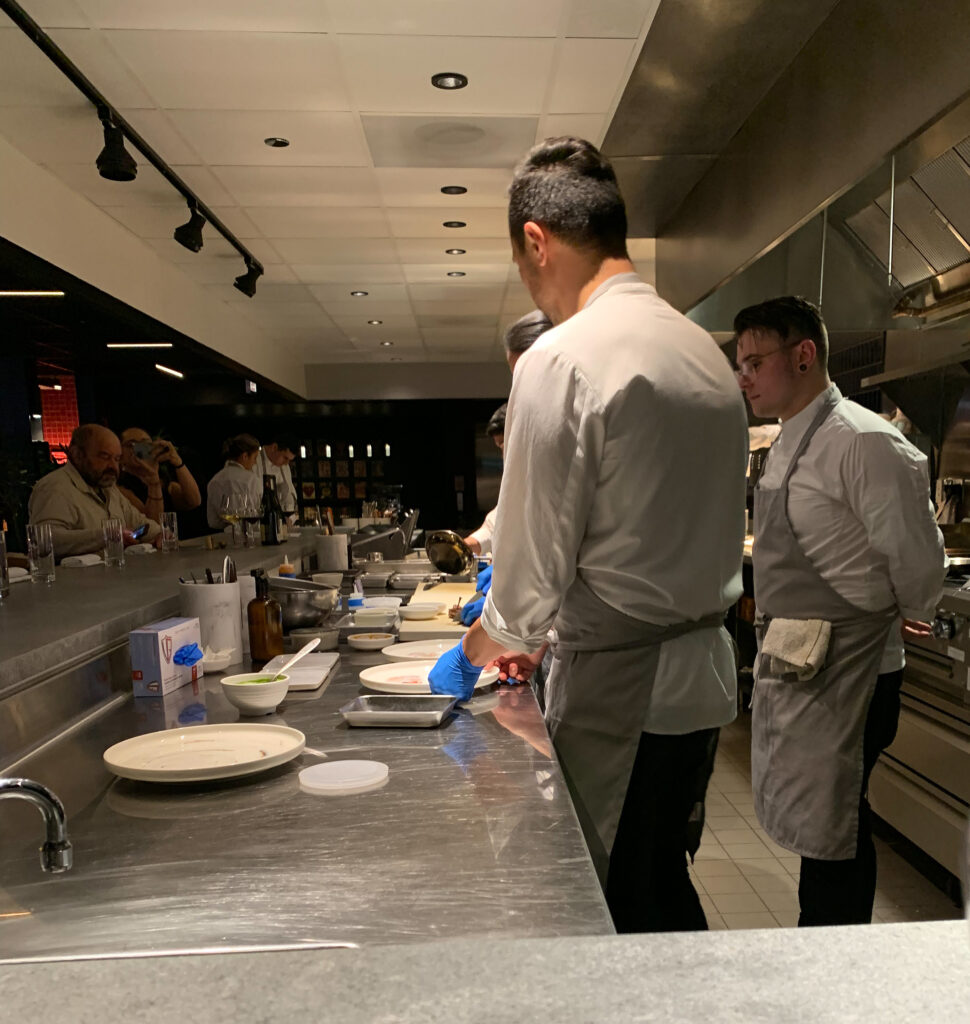
For, at the Michelin-starred level, Chicago chefs cannot always be expected to forge some connection with their guests. You cannot even guarantee that they will drop off a dish. That gravitas of which you speak is something you associate more with bygone names like Jean Joho and Tony Mantuano, figures who warmly presided over their dining rooms and always found time to shave truffles or share in a glass of wine as an exclamation point to an incredible meal. The pressures of contemporary fine dining may not allow chefs to mingle as much as they once did, but at places like EL Ideas, Elske, Esmé, Goosefoot, Temporis, and Valhalla it is almost certain you will get to interact with the “master craftsperson” whose cuisine you sought out in some capacity. At Moody Tongue, you may spy the chef working on the other side of a glass divider, and, at Ever, you may be lucky enough to meet the chef and share a few words (or take a picture) when touring the kitchen.
The same goes at Alinea, where kitchen tours have been deftly woven into each of the three tiers of experience. Just do not expect to see Grant Achatz himself there but, rather, executive chef Douglas Alley. The same holds somewhat true at Smyth, where you may often catch sight of John Shields but interact more principally—and, when it really comes to probing the food, rewardingly—with executive chef Luke Feltz. At Oriole, there is a greater chance of conversing with Noah Sandoval when seated at one of two kitchen tables; however, everyone traverses the pass at the beginning and end of the meal—lending opportunities to engage the chef if you so desire.
Kasama really shines because those who have battled to secure a reservation for the tasting menu are sure to be visited by both Tim Flores and Genie Kwon. Given that the chefs are at an absolute peak of fame right now, the effect is intoxicating. They linger and allow guests making the pilgrimage to express some of what the meals to them despite the demands of running both the daytime and nighttime business. This, to you, makes for a transcendent moment of hospitality that is only equaled, on account of the reliability with which they both occur for most diners, by meeting Curtis Duffy in Ever’s kitchen. Nonetheless, you think the chefs of EL Ideas and Goosefoot—on account of the intimate formats—make themselves rather available to guests too.
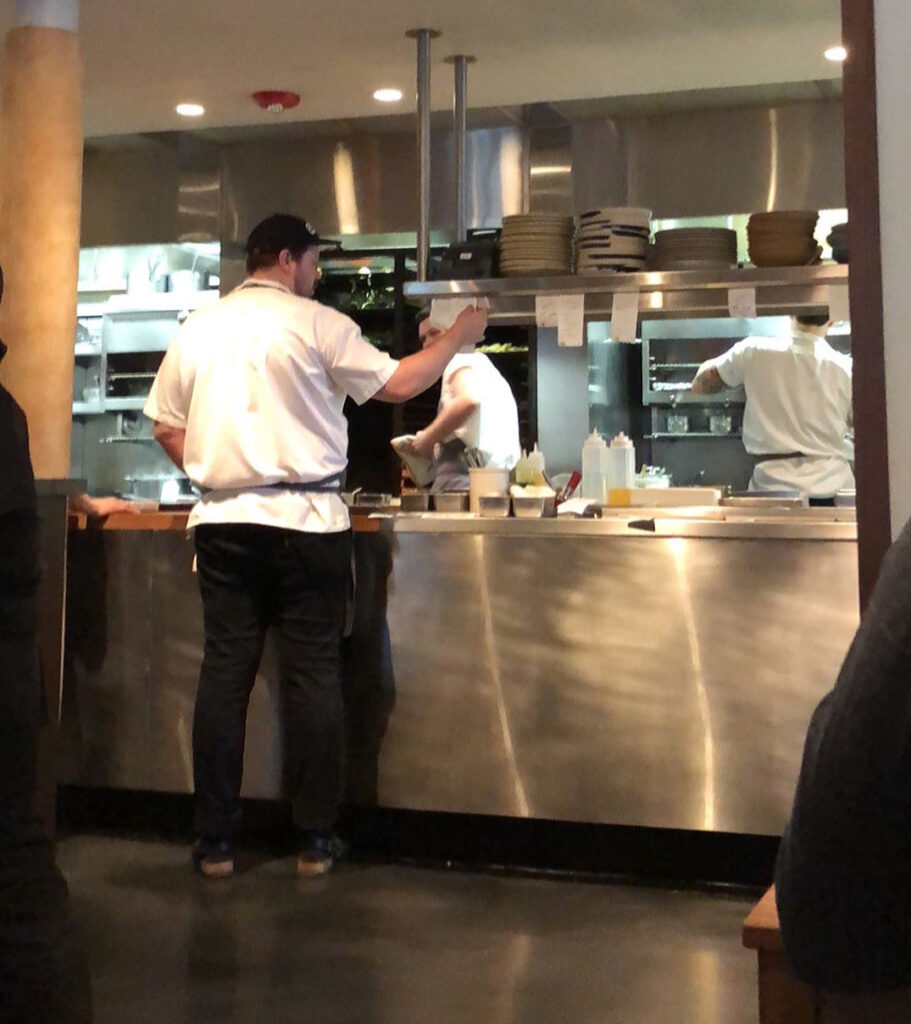
This is all to say that the bar for chef presence and interaction at the Michelin-starred level is not set terribly high. Merely showing one’s face in any capacity is enough to tickle guests who want to indulge in the romance of eating the “master craftsperson’s” food. Given how many aspirational fine diners are first drawn to these restaurants on account of celebrity chef culture, these cameos are essential. They have real power to shape how someone perceives textures that are more strange or flavors that are more subtle than expected. They smooth over all manner of missteps and sins by assuring you that the “artist” is actually there and that whatever you might not understand could very well be intentional. And this is not even delving into the effect that a proper conversation, a picture, a stirring of the soul through a shared love of gastronomy can have when a chef cares to stop and give even more of themself than a simple glimpse.
Boka, as a member of Chicago’s fine dining old guard, should not be struggling to execute dinner service. Its chef should be free to deliver dishes and, yes, to stop and chat and play the part of craftsperson that everyone—doling out this kind of money—loves to see. When some aspects of the experience (like the pricing of the wine list) leave you feeling cold, the energy the “master craftsperson” or “artist” brings to the room is the surest antidote to feeling like you’ve stumbled into a faceless cash grab living on its past reputation. Perhaps you are being dramatic, for Wolen, now with other restaurants to attend to, may have been in this job for too long to meaningfully change course. Maybe, upon first taking the job, he did make a concerted effort to meet his new clientele and has now grown too comfortable.
The chef, it must be said, deserves credit for fostering the beautiful culture of hospitality transmitted by the rest of his staff from his position of authority. Still, leading by example—humbly working the room with that same spirit shown by his front-of-house counterparts—would undoubtedly enrich an otherwise tranquil dining room. You cannot ask Wolen to go against his fundamental nature. Hell, most of the best chefs (both in Chicago and worldwide) are fairly soft-spoken. But the alternative is to let the food alone do the talking: a risky proposition but one that is not without precedent. Why put so much pressure on achieving faultless consistency (pretty much an impossibility even at this level) when a nod and a smile form such an effective secret ingredient?
Turning, now, toward the bill of fare, you find that Boka offers about 15 à la carte items at any given time (split between the categories “To Begin,” “Cold,” “Hot,” and “Entrées”) alongside the aforementioned “Seven Course Tasting Menu” priced at $165. During the course of the three visits that are the subject of this analysis, you sampled the tasting menu alone, the à la carte fare alone, and a blend of the two together. In the second case, à la carte dishes were split in the kitchen to better facilitate sharing (a nice touch). In the third case, the à la carte items were interspersed between and alongside the components of the tasting menu (also a nice touch). For the sake of simplicity, you will analyze all of the dishes you have sampled in order from lightest to heaviest while respecting the combinations that the kitchen itself made use of when serving a variety of plates at the same time. This will allow you to avoid backtracking while also probing certain synergies and juxtapositions created by the chef.
The tasting menu kicks off with a presentation of “Golden Osetra Caviar” (also available à la carte for $27). In this case, the roe is ensconced within an eggshell whose top has carefully been removed. This technique reminds you of Valhalla’s “Black Truffle Egg Tofu” but is executed more cleanly (as you only notice the slightest, most miniscule chip in one of the renditions). It has been utilized by Wolen since at least as far back as 2017 and typically makes use of a sabayon, which serves to obscure the caviar and better enable the scooping of the egg’s contents. The roe, in this particular case, is flavored with buckwheat, cucumber, and maple.
While the hollowed-out egg technique is not exactly new, the dish is still rather pretty. The vessel sits within a bowl filled with buckwheat kernels and strewn with greenery. Grasping the egg feels like you are plucking it out of a perfectly manicured nest. Using the accompanying mother-of-pearl spoon, you extricate a clump of the caviar that is surrounded by the foamy sabayon and a couple fine chunks of cucumber. On the palate, the orbs pop as that latter element subtly crunches as they escape the creamy, mouthcoating sauce. While the buckwheat component helps to underscore the golden osetra’s subtly nutty character, the dish’s flavor is defined mostly by the maple. It lends the combination of roe and sabayon a delectably sweet, caramelly finish that is only alleviated slightly by the cleansing cucumber. For you, the caviar’s own flavor gets lost among all this decadence. However, the preparation forms an impressive enough start to the meal whose decadence is sure to please most guests (even if it’s missing just a bit of depth).
An alternative version of the hollowed-out egg technique has taken the form of “Trout Roe Eggs” ($27), another longstanding preparation offered—in this case—à la carte but not as part of the evening’s tasting menu. Whereas the golden osetra peeked out from within the sabayon, these larger, orange orbs are totally hidden within the sabayon. Otherwise, the accompanying ingredients (buckwheat, cucumber, and maple) remain the same.
Diving in, you have found that the more pronounced, briny flavor of the trout roe ensures that the ingredient is not as overshadowed by the sweet, caramelly maple notes as the golden osetra was. However, this still does not make for a dish of any improved complexity. Rather, the sabayon on this occasion is noticeably less foamy and more watery. It contrasts the orange orbs and crunching bits of cucumber with a lesser degree of textural intrigue, feeling like something more of a lukewarm soup. Nonetheless, the novelty of the egg container and the overall sweetness of the composition ensures the “Trout Roe Eggs” is still a pleasing dish. You only question whether it is worth paying the same $27 for a version of the dish that lacks any sturgeon caviar (with no perceivable increase in the lesser roe’s serving size) and features an inferior execution of the sabayon.
Another opening item, served both on the tasting menu and à la carte, is the “Beausoleil Oyster” ($6). This particular variety of the bivalve has been served since 2020; however, the restaurant has also made use of other types like the Capital and the Kumamoto over the years. Serving a pristine oyster on the half shell, surely, will never go completely out of style (even if it has become somewhat of a tired fine dining trope at this point). Plus, in the right chef’s hands, the shellfish forms a fitting canvas for some thoughtful seasonal expression that draws upon its beautiful sweetness and brine. In fact, you have seen the “Beausoleil Oyster” dressed two different ways across your three meals: first with a combination of green almond, cucumber, and horseradish then, subsequently, with rhubarb, mint, and perilla.
Both these variants of the bivalve, it must be said, are quite visually appealing. Featuring, in the first case, slivers of the green almond set across the shell with an accompanying flower bulb and, in the second, smaller flower petals that are offset by the rhubarb’s red hue, the oyster—like the egg before it—communicates a dainty, carefully engineered quality that still feels naturalistic. When multiple pieces of the shellfish are served on an ornate metal platter, the effect is even further multiplied. On the palate, the Beausoleil displays a fleeting firmness that yields to a buttery finish. The variety’s clean, slightly sweet and salty flavor marries well with the surprisingly tart (but still nutty) green almond and cleansing cucumber in the first case, but you have trouble sensing the horseradish. In the second iteration, the sour flavor of the rhubarb, along with the mint and anisey notes of the perilla, makes for a slightly more forceful combination. Still, these are ultimately good—not great—dressed oysters that are charming at a visual, experiential level but not quite memorable among a pantheon of other preparations.
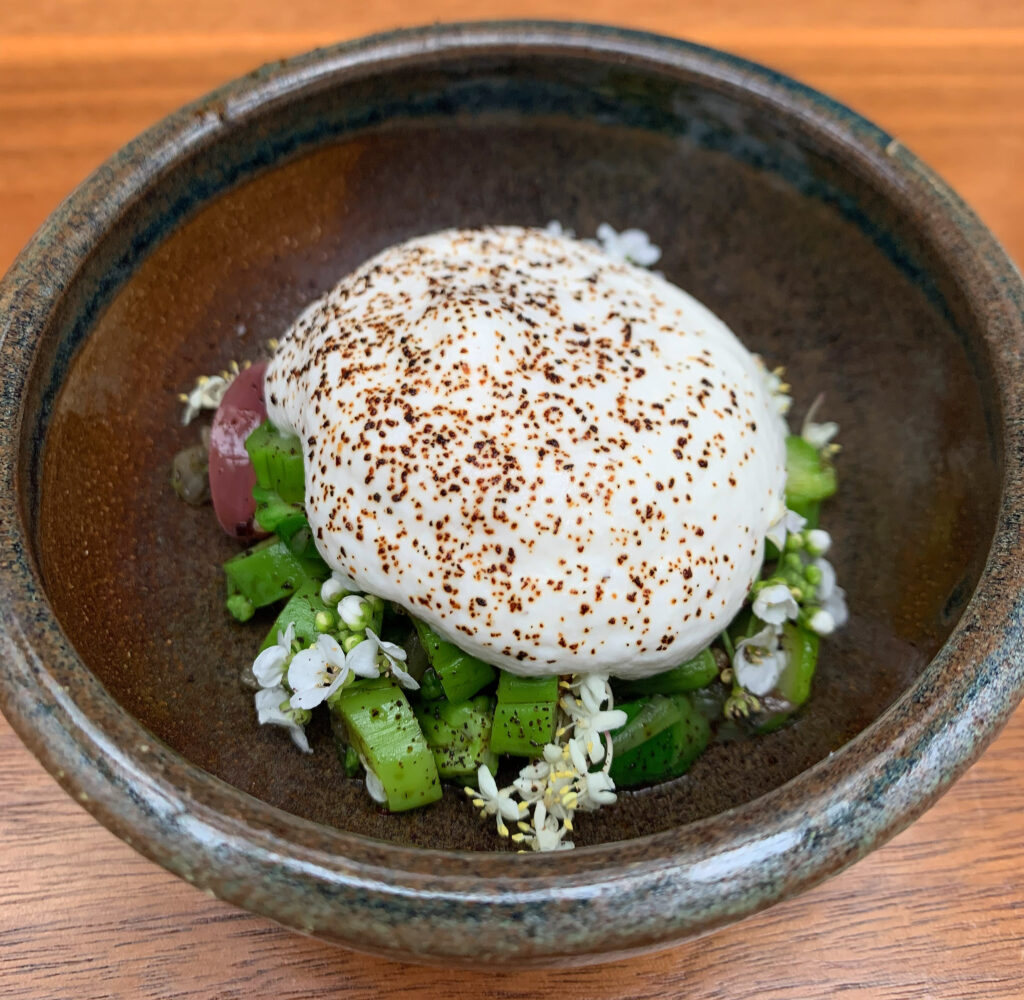
Moving on, you arrive at the first dish that is totally exclusive to the tasting menu (and, thus, somewhat of a testimonial as to why you might sign on for all seven courses). The “Klug Asparagus” is actually served alongside the “Beausoleil Oyster” and sources its titular ingredient from one of Chicago chefs’ favorite purveyors: Mick Klüg Farm. Small bits of the vegetable arrive buried under a creamy, but still rather airy cloud of whipped farmhouse cheese. The asparagus is joined by segments of grilled ramp (later substituted for pearl onion), a dusting of ground quinoa, and a garnish of flower petals that help provide some aesthetic connection to the adjoining dish.
Diving in with fork and knife, you are impressed by just how well the farmhouse cheese holds its puffed shape as you scoop a bite out from the bowl. Upon hitting your tongue, the diced pieces of asparagus and slim strands of ramp (or pearl onion) crunch pleasingly (with just hint of waxiness) before being absorbed by their creamy topping. The quinoa, while it can be rather crisp, is ground finely enough that its texture is almost imperceptible. Rather, it offers nutty, earthy notes that accent the asparagus’s faintly grassy, bitter, but freshly sweet flavor and help define the cheese, which is undoubtedly rich but not all that intense. Ultimately, this dish strikes you as a bit subdued despite the seasonality of its star ingredient. There’s a decent savory sensation that lasts through the finish, but you would like there to be some more dramatic contrast between the elements or, simply, a greater overall intensity.
At this point in the meal, whether enjoying the tasting menu or dining à la carte, your busser will offer bread service. While Boka has offered two varieties at a time in the past, the restaurant has served a sole “Seeded Buttermilk Roll” for the past couple years. (That being said, they will offer you a second helping, but two seems to be the limit.) The bread is joined by a perfect dollop of yellow-tinted butter that comes dusted with fennel pollen.
Clutching the bread in your hands and tearing off a piece, the ”Seeded Buttermilk Roll” emits a slight amount of warmth. This works in its favor and allows the butter, which is already served at a perfectly spreadable temperature, to melt a little upon coming into contact with the crumb. The bread’s outer crust is in no way crispy but, as its name suggests, is sprinkled with a blend of white and black sesame seeds, sunflower seeds, and flakes of puffed sorghum. This mixture offers the slightest bit of crunch and a nutty complexity that plays well off of the roll’s wheaty, faintly sour, and nicely fluffy crumb. Personally, you think the dough could use a bit more salt to really make these elements pop. However, the rich, mouthcoating butter—tinged with that anisey-sweet fennel pollen—is excellent. In sum, the ”Seeded Buttermilk Roll” makes for a serviceable bread course that, despite being served for some time now, does not quite reach the heights of something like Gramercy Tavern’s “Angel Biscuit.”
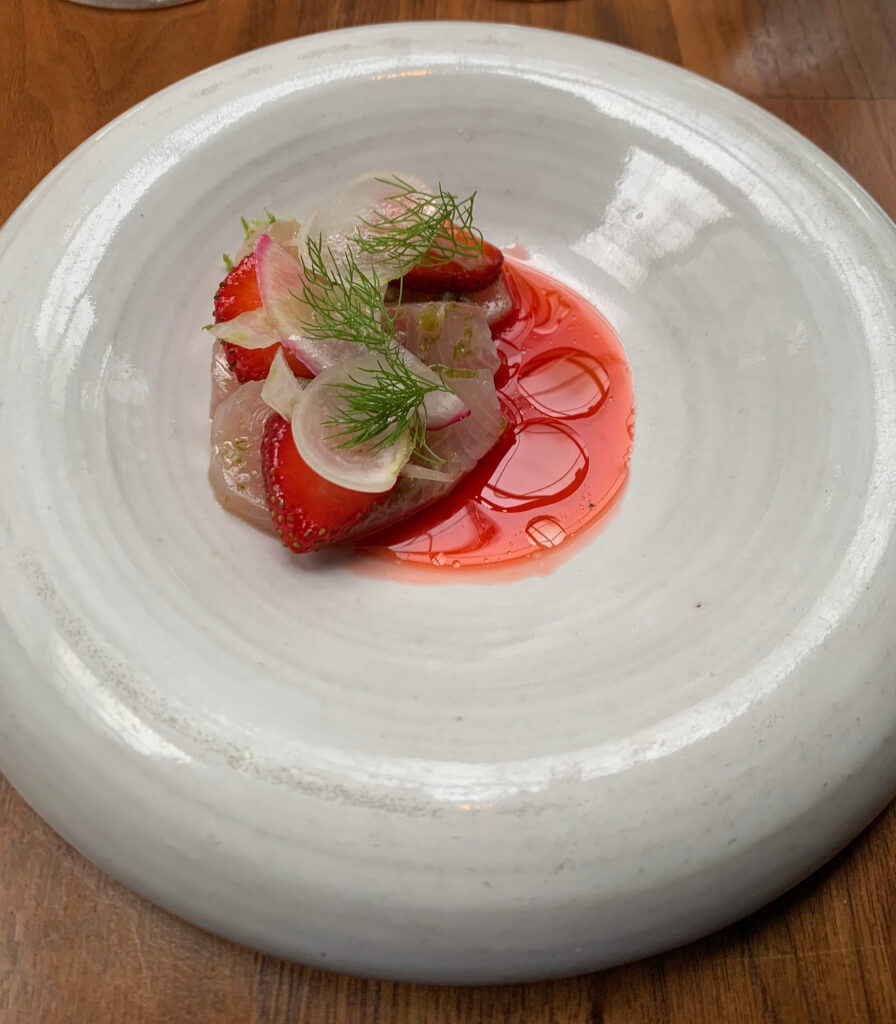
The next dish, available both on the tasting menu and à la carte, is something of a fixture. Boka has served a preparation of “Marinated Hamachi” as far back as 2016, and both the “Lightly Cured Hiramasa” (as it’s known on the tasting) and “Lightly Cured Kampachi” ($24) (as it is known on the à la carte) can be seen as an extension of the same idea. You might even include dishes like the “Marinated Fluke,” “Cured Fluke,” and “Shima Aji Crudo” that have appeared over the years. However, the terms hamachi, hiramasa, and kampachi each refer to different species of amberjack and, thus, represent kindred fish. More specifically, “hamachi” refers to the sub-adult Japanese amberjack, “hiramasa” refers to the yellowtail amberjack, and “kampachi” refers to the longfin yellowtail.
These terms are, understandably, a bit confusing—as well as the fact that two of them coexist on the same menu at the same time. Nonetheless, the “Lightly Cured Hiramasa” utilizes what is considered a slightly more premium fish (often sourced from the coasts of Australia or New Zealand) while the “Lightly Cured Kampachi” often sees its principal ingredient farmed in the waters of Hawaii or Baja. With this in mind, it makes sense that the tasting menu would draw upon the more prized, precious species. Doing so ensures guests who sign up for all seven courses get to appreciate the rarer product, leaving the more accessible kampachi at the ready for somewhat more irregular à la carte orders.
Despite this slight difference, the “Lightly Cured Hiramasa” and “Lightly Cured Kampachi” have undergone the same preparations: first being paired with rhubarb, fennel, and buckwheat then, later, being joined by strawberry kosho, spruce, and turnip. Both dishes, in both versions, have also been presented in the same manner: three thick slices of the respective fish being layered atop a sauce with the garnishes strewn across their surface.
Texturally, across three instances and two different manners of preparation, you have found little difference between the hiramasa and the kampachi. Each fish offers a smooth, firm mouthfeel that easily breaks apart with further mastication without quite melting on the tongue. Neither strikes you as being particularly umami, but there is an appreciably rich and buttery sensation that carries through the finish. This is impressive given the size and thickness of the slices, reflecting a skillful execution of the curing process. It also works well as a canvas for the crunching bits of rhubarb, buckwheat, strawberry, and turnip that appear as toppings respectively. That being said, the two dishes are undoubtedly defined by their flavorings. While the sour, anisey (and a bit nutty) sweetness of the first iteration was enjoyable, the strawberry kosho utilized in the second is the real star. This sauce, made from fruit that has been fermented, lends the dish a deeply tangy quality. When combined with the freshly sweet slices of strawberry and uplifting notes of spruce, the kosho helps the rich (but fairly mild) hiramasa/kampachi sing. They imbue the fish with the sort of intense, lip-smacking character you so desire, drawing you in for bite after bite. This is undoubtedly one of Wolen’s best dishes and a real benchmark for the lightly cured/marinated/crudo form throughout Chicago.
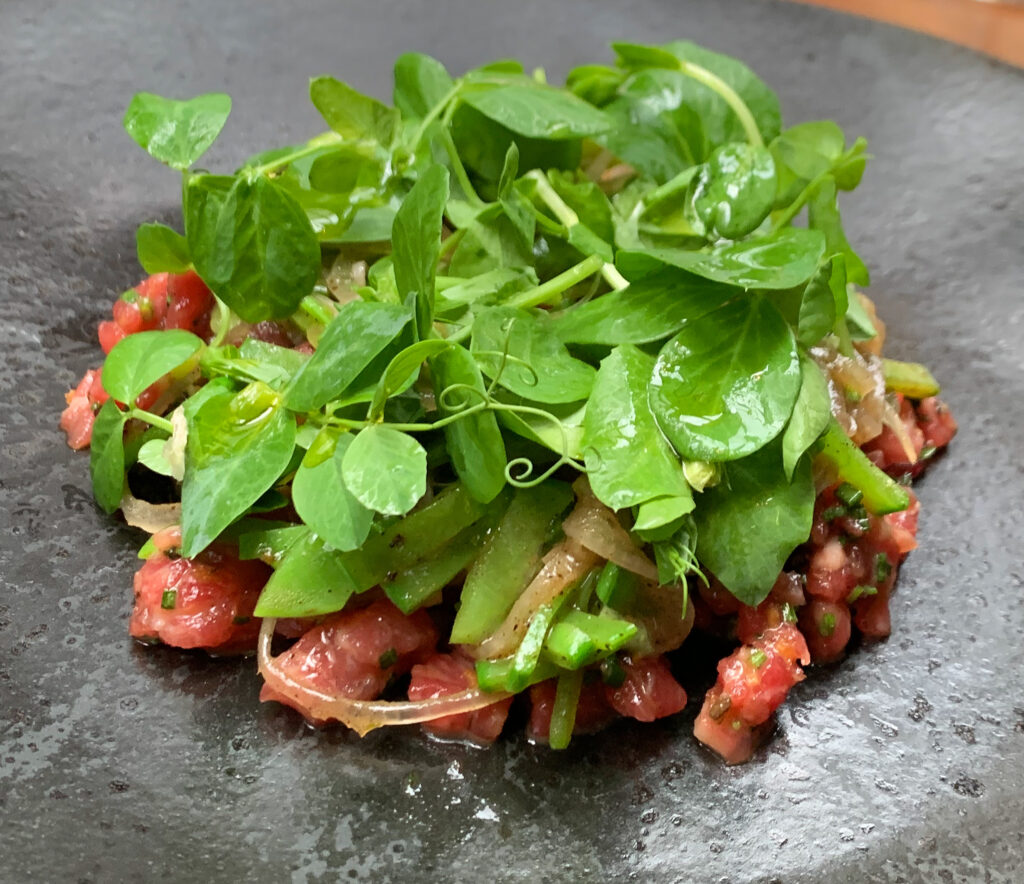
Another longstanding dish (being served as far back as 2016), in this case exclusive to the à la carte menu, is the “Dry Aged Beef Tartare” ($24). The meat itself is finely chopped and lightly dressed in the familiar fashion, forming glistening chunks of moist ruby-red meat. The beef, crucially, is interlaced with comparably sized brioche croutons, which preclude the need for any accompanying bread. This combination has formed the base for countless seasonal tableaux, the present of which involves thin strips of snow pea and spring onion set within a thicket of micro sorrel leaves.
The presentation here, once more, feels effortless and pretty. The preponderance of green on the plate makes you doubt its carnal credentials, but, taking a bite, the dish achieves an attractive savory character. The crunching pods, stems, onion strands, and leaves all amount to a peppery, tangy, subtly sweet, and proudly vegetal topping. But the dry-aged beef, upon melting on the palate, displays such a striking degree of umami. The meat is perfectly seasoned and laced with deeper mushroomy, earthy notes. It combats the effect of the snow peas, sorrel, and the rest to make a mouthful that is bright, refreshing, and unapologetically beefy in turn. When those buttery sweet brioche croutons enter the equation, all these intense flavors hit their peak as the crumb coating readies your tongue for another bite. This, too, is a great dish.
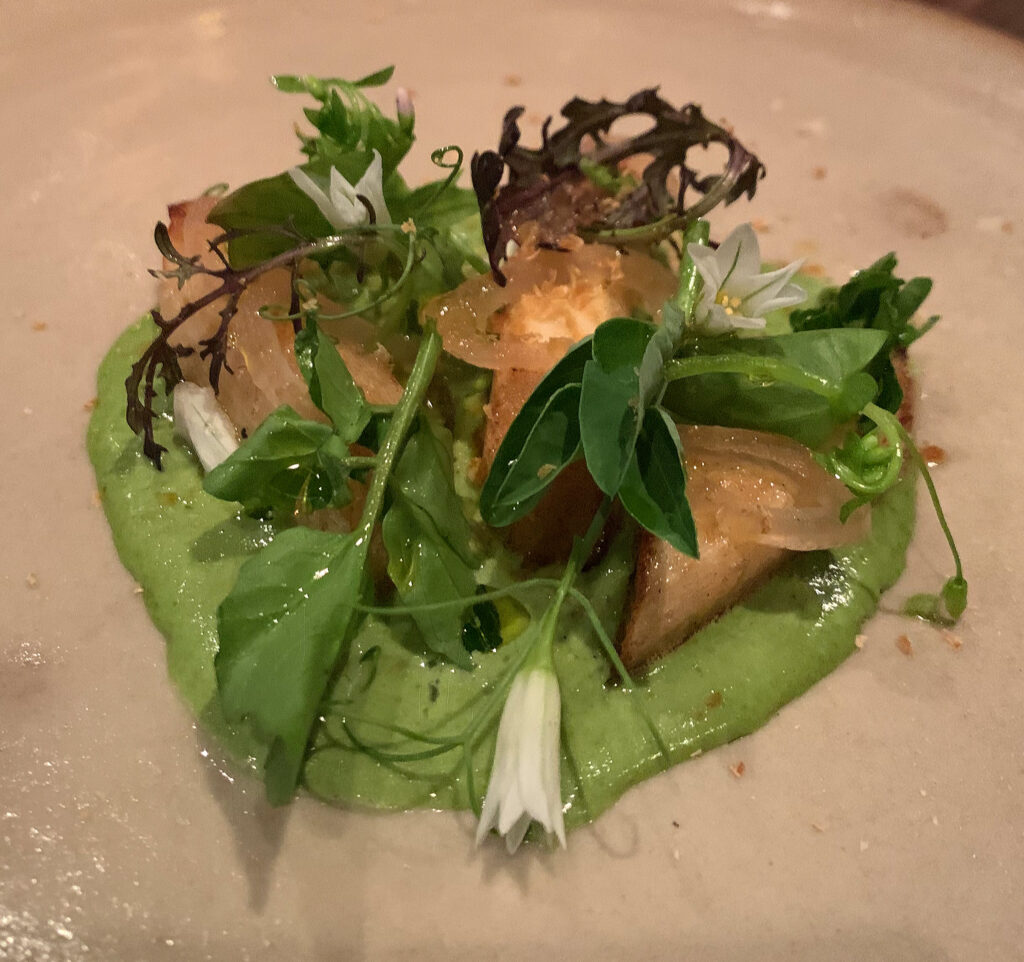
Moving back to the tasting menu, you find another dish that is exclusive to the format. Appropriately so, given the star ingredient’s short season. The “French White Asparagus,” which Wolen has been toying with since 2020, is certainly one of the meal’s most worshipful preparations. Nevertheless, it holds a surprise. The vegetable’s thick stalks and tips sit in a creamy sorrel sauce. They are topped with a tangle of spring greens that is adorned with a couple flower bulbs. But—tucked between the segments of asparagus, their milky white flesh acting as camouflage—are hidden pieces of smoked scallop.
Thus, when you assemble the perfect bite, something strikes you. There’s the firm, then tender subtle crunch of the white asparagus, coated with luscious sauce, and crowned with the delicate snap of the spring greens. There’s the vegetable’s pure, sweet flavor, the rich and tangy notes of sorrel, and a leafy green depth. Yet then you perceive the delectable chew of the scallop, how it elongates the tender mouthfeel of the asparagus. You sense how the bivalve’s sweet and transfixingly smoky flavor enriches the vegetable, leading to a finish that tastes supremely nutty. The essence of the white asparagus, no doubt, still takes center stage. And Wolen has found a good way to showcase it while delivering the kind of intensity you always seek.
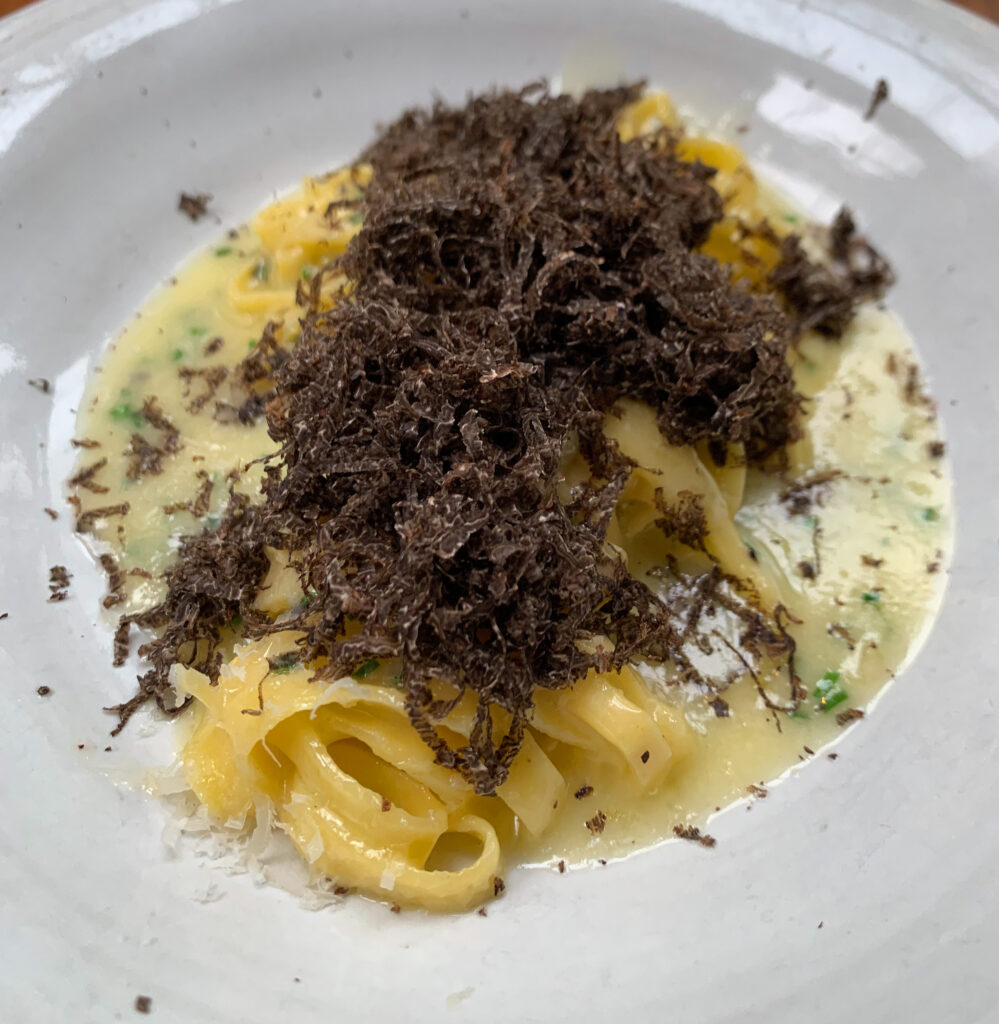
With the arrival of the next dish, first offered à la carte and later incorporated into the tasting menu, you come to the meal’s first preparation of pasta. Such dishes have been a staple at Boka since the days of Scurato and Tentori, yet Wolen has developed his own classics. The first of these centers on offering that most coveted totemic luxury ingredient—the truffle—”at cost” to go along with some housemade noodle. This idea seems inspired by what Will Guidara and Daniel Humm first did at the NoMad in 2013, later being adopted by Wolen in 2015. Though customers have sometimes been presented with the option of shaving the truffles on any dish of their choosing, the ingredient has been reliably paired with cappelletti, cavatelli, fettuccini, risotto, and tagliolini over the years. The current rendition, “Black Truffle Tajarin” ($42), has appeared as far back as 2020 and maintains some relatively friendly pricing (even if the words “at cost” are not explicitly being used).
Tajarin, the noodle in question, is just the Piedmontese name for tagliolini: the pasta that Boka has paired its truffles with since the very beginning. Its name, a derivative of the verb “to cut,” denotes a heavily egg yolk-enriched dough that is thinly sliced (traditionally by hand but sometimes using a machine) into strands with a width of only one or two millimeters. Wolen dresses the noodles simply in butter, parmesan, and chives but adds a distinguishing touch of toasted yeast. The pasta is then topped with the truffles, which have alternatingly been microplaned or shaved depending on the occasion, and served.
Visually, it is easy to note the differences between the two preparations of “Black Truffle Tajarin” you have been served. The first, microplaned version features a looser tangle of noodles that is absolutely swimming in sauce. The second, shaved version comprises a tighter spool of the pasta at the bottom of a much drier bowl. Approaching the former dish, you find the microplaned truffles (sourced from Australia) exhibit a decent degree of those haunting, musky aromatics. On the palate, the tajarin is soft and rich with a faint bit of chew and a slick, buttery finish. As they disappear, the noodles impart an intensely savory flavor that is enhanced by the earthy truffle and surprisingly nutty, bready toasted yeast. This latter element, which calls Oriole’s “Caraway Capellini” to mind, does a brilliant job of extending your perception of the luxury ingredient on account of its underlying complementary notes.
Nonetheless, the latter dish, with the shaved truffles, is similar at a textural level but lacks the same aromatic appeal and intensity of flavor. This makes sense given the smaller serving of sauce and the necessity that black truffles be adequately warmed to release their properties. These slices, while visually appealing, are simply too large and thick to be adequately tempered by the tajarin’s ambient heat. Thus, they amount to little more than window dressing for a pasta dish that, in this case, tastes underseasoned. Why wouldn’t the kitchen resolve to always microplane the ingredient? For, at its best, the “Black Truffle Tajarin” can compete with the “Caraway Capellini” in terms of sheer decadence. However, in its second iteration, the pasta stands as a posterchild for the thoughtless use of totemic luxury ingredients you routinely decry. There is certainly potential here, but you are confused by the lack of consistency for a preparation that should be simple.
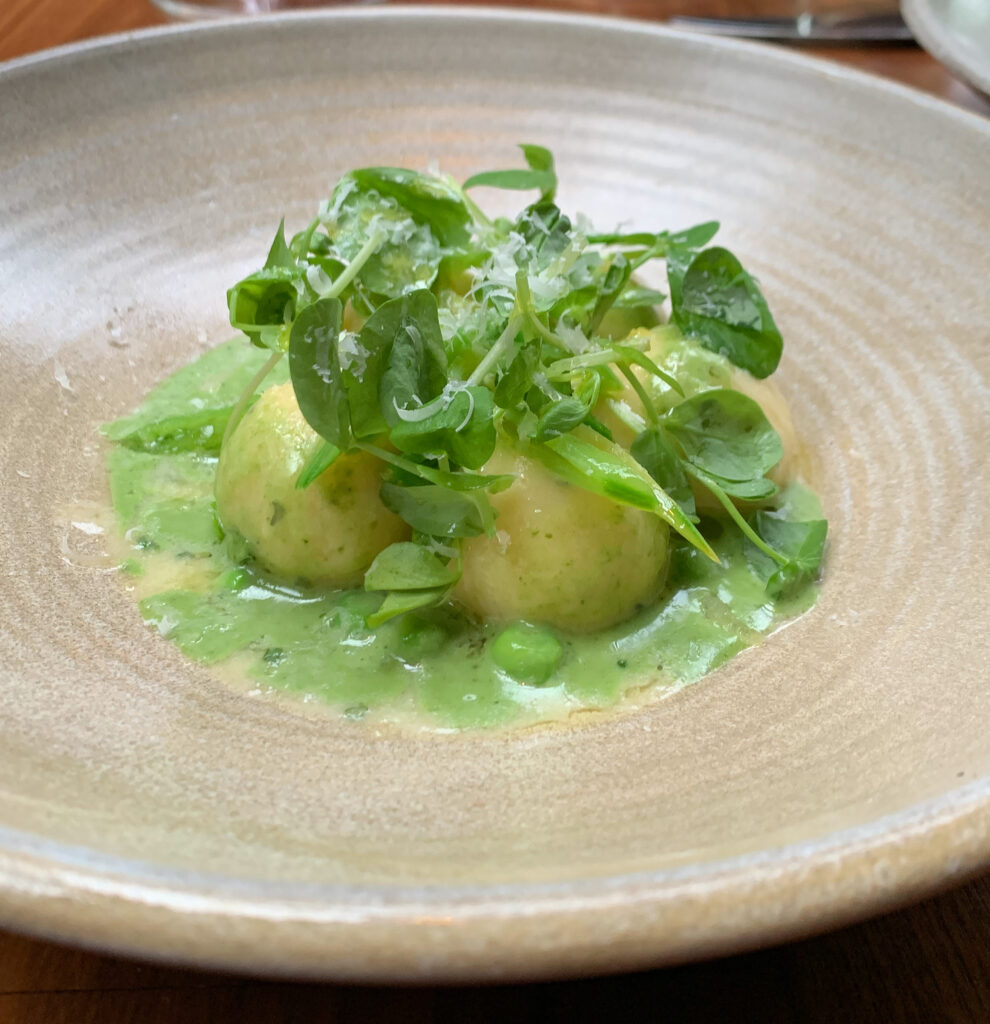
The other pasta you have sampled across your visits has an even richer legacy than the “Black Truffle Tajarin.” Wolen’s “Ricotta Gnudi” ($24), offered à la carte, dates back to 2014 and can also be considered a relative of the “Ricotta Dumplings” that have appeared over the years (even earning themselves a permanent place on Alla Vita’s menu). The recipe is essentially like gnocchi without the potato or, even more appropriately, like the “nude” filling of a raviolo without its wrapper. These gnudi have formed the basis for a variety of seasonal compositions (like butternut squash, cabbage, and bone marrow or ramps, green garbanzo, and charred onion broth). The present version draws upon peas, sorrel, and whey.
As with the “Black Truffle Tajarin,” there is a striking difference between the two preparations of “Ricotta Gnudi” you have been served. The first version features globules of the pasta that have been lightly moistened in a loosely incorporated light green (with streaks of off white) sauce made from the whey and peas. They are then topped with a tangle of sorrel microgreens and some shreds of cheese. The second version comprises gnudi that have not been tossed in their sauce and, in fact, features a sauce in which the deep green of the pea has not been blended with the whey at all. The sorrel, too, is rendered as two sets of larger leaves rather than the assortment of bits and stems used previously. The parallel with the microplaned/shaved truffles—as well as the disparate degree of the tajarin’s saucing—is uncanny. The superior versions of the two pastas were, indeed, served on the same evening while a latter visit saw the same lapse in standards across both dishes.
Thankfully, the difference in execution here is not as decisive as it was when it came to tempering the truffles. Both iterations of the “Ricotta Gnudi” have put forth soft, creamy mounds of cheese and flour that glide across the tongue and unfurl themselves. This serves as a canvas for the faint pop of the accompanying peas or, depending on the nature of the sorrel, the subtle crunch of the herb’s stems. The accompanying sauce reflects the rich, creamy character of the whey with just a little bit of a tangy, green quality on the finish. There is an adequate—maybe even a pronounced—degree of salt here, but you do not find much pleasure from the preparation. The gnudi themselves are texturally one-note, not really contrasted by any other mouthfeel, and paired with a sauce lacking the kind of decadence that would make you want such a homogenous pasta to linger in your mouth. The flavors, in general, do not even speak of peas or sorrel or ricotta all that clearly. Unfortunately, this has stood as one of the meal’s weakest dishes both times you encountered it. On one occasion, it was even served after—rather than before or alongside—the “Black Truffle Tajarin,” a decision that confused you given the greater richness of the latter dish.
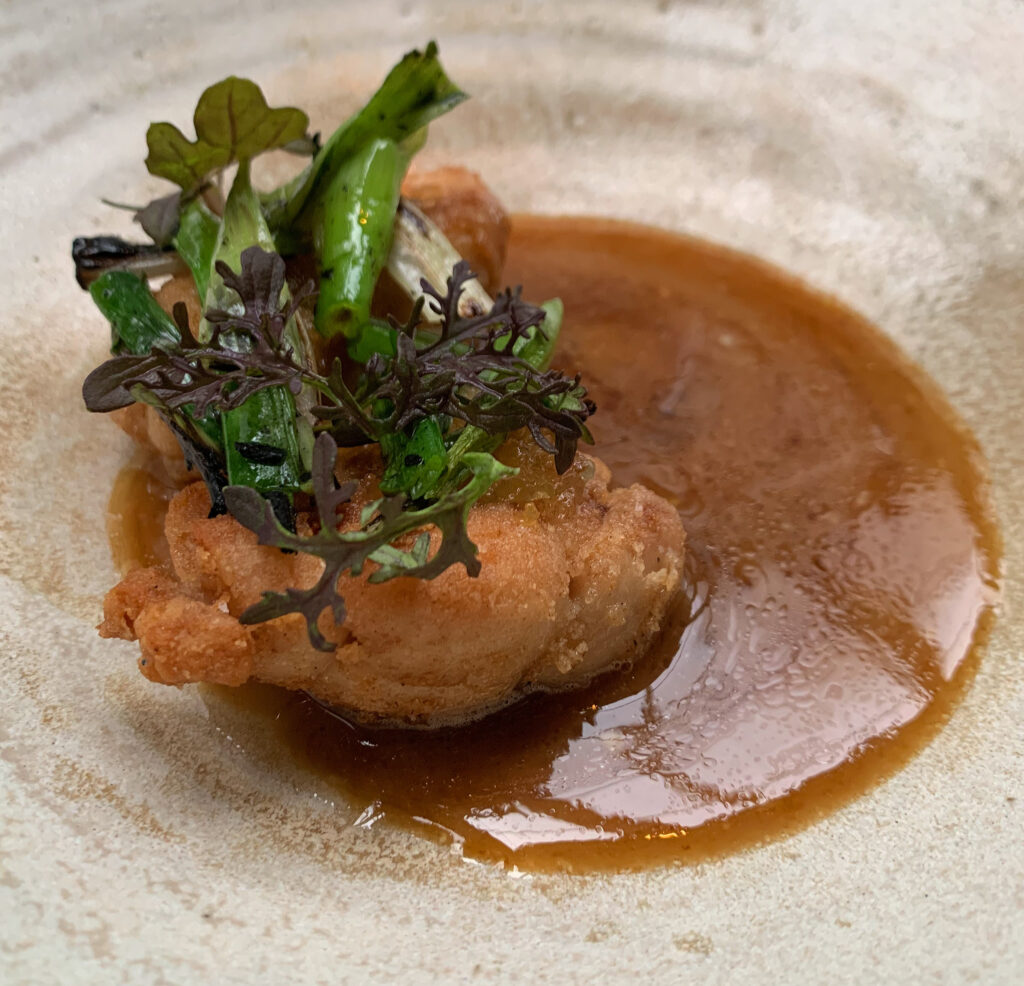
With the à la carte “Roasted Veal Sweetbreads” ($27), Wolen takes aim at one of your all-time favorite ingredients. This prime piece of pancreas, when treated right, offers one of the most tender, succulent expressions of offal (often benefitting from a beautiful crisp coating to boot). Here, where the chef has been serving some version of the dish since as far back as 2016, he keeps things simple. The sweetbreads are lightly breaded and cooked until just a bit shy of golden brown. The meat is topped with strands of burnt spring onion and then finished tableside with a broth made of kombu (dried seaweed) and pork.
Diving in, the sweetbreads—not being billed as “fried” or “crispy”—do not exactly display a crackling crust. Rather, their breading is just a bit flaky and transitions cleanly into the pancreas’s smooth, rich interior. You note some minor traces of sinew within the meat, which bothered one of your dining companions, but are generally impressed by the offal’s texture. The nuggets feel full and satisfying as they bounce against your teeth, gushing with the accompanying broth, while the segments of burnt onion deliver some of that crispness you were seeking. In terms of flavor, the charred vegetable component offers a fleeting bitter note that helps distinguish the richness of the sweetbreads and prevent the deep umami of the kombu and pork from seeming too overwhelming. You appreciate the savory power this preparation achieves while utilizing a tricky ingredient. It is not quite a best-ever sweetbread dish (lacking, you think, just a bit more textural intrigue) but represents a good effort.
With the arrival of the “Slow Cooked Ocean Trout,” you come to yet another composition that is exclusive to the tasting menu. This dish follows in a long line of “poached,” “olive oil poached,” and “slow cooked” fish (like arctic char, halibut, cod, and loup de mer) over the years, with trout featuring in this form since 2021. Of course, the exact accompaniments are always changing. The preparation has been paired with thinly-sliced kohlrabi, koji butter, and smoked trout roe on the first occasion and with seaweed, morels, and watercress thereafter.
The presentation of the “Slow Cooked Ocean Trout,” on both occasions, is fairly similar. The fish swims in a shallow pool of buttery sauce (later rendered as something more of a foam) with its garnishes—be they coins of kohlrabi or caps of mushroom (along with a couple wedges of radish)—serving as faux scales. Attacking the trout with your fork, its flesh breaks apart effortlessly into a large, glistening flake. You make sure to retrieve some of the accompanying ingredients and drag the bite across the bottom of the bowl before depositing it on your palate. There, the fish displays the fruits of its gentle preparation, with the crispness of the kohlrabi or chew of morel yielding to the trout’s exquisite, melting mouthfeel. As to flavor, you find the combination of seaweed and prized mushroom, brightened by the peppery watercress, to offer less umami than expected. Nonetheless, in the first version of the dish, the notes of koji (a mold that inoculates and saccharifies rice for fermentation) and smoked trout roe supercharge the trout to a delightfully hedonistic degree. This—combined with the fish’s faultlessly tender texture—makes for one of Boka’s very best dishes that, even in its subsequent form, remained fairly strong. Well done!
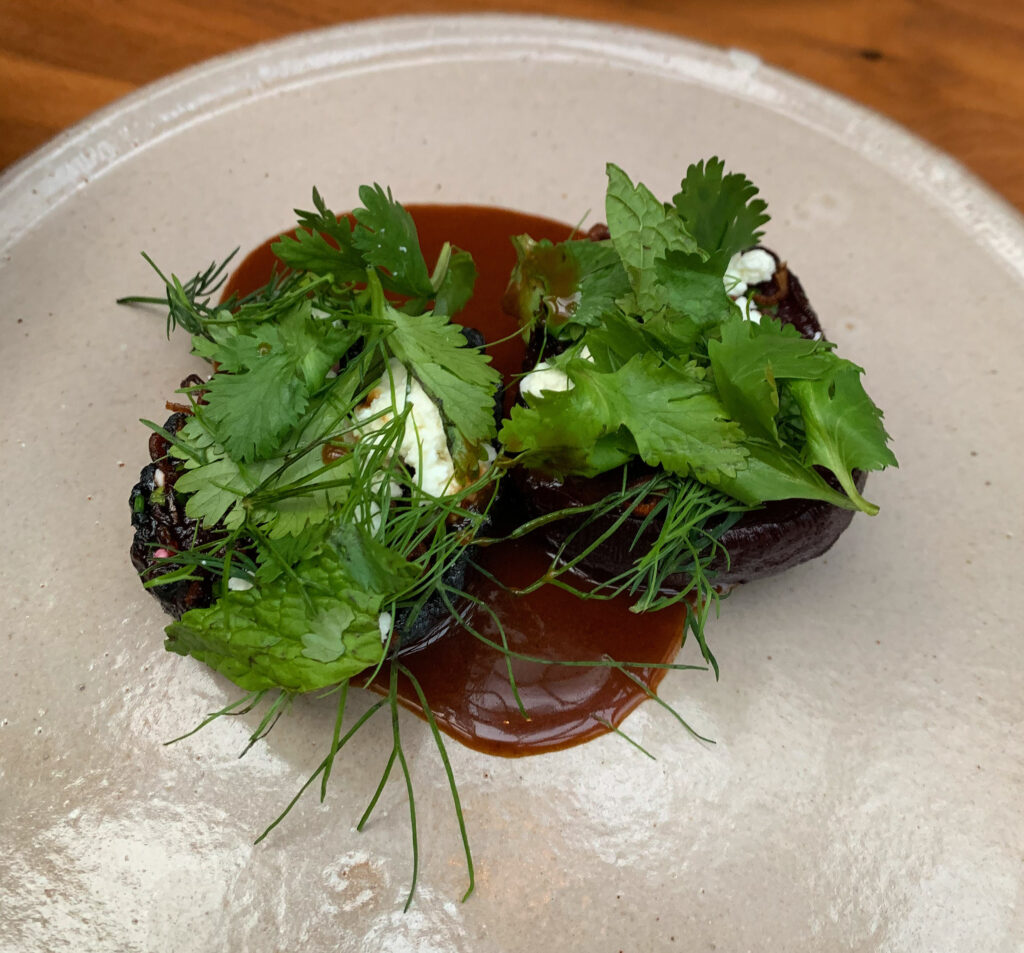
Heading into the entrées, you begin with a preparation of “Grilled & Glazed Beets” ($29) that is offered à la carte. The dish, which the restaurant has served in some form for at least five years, represents an obvious vegetarian option. However, this root vegetable—in the right hands—can attain a level of umami that pleases even the most devoted carnivores. Yes, beets are a polarizing ingredient with almost unlimited potential, one that is most often fulfilled at New Nordic restaurants and, more locally, somewhere like Smyth. So how does Boka harness them?
The two sizable halves of beet, after being grilled and glazed as the title suggests, are laid at the center of a plate with their interiors facing up. Both pieces of the vegetable are dressed with feta cheese, crispy shallots, and bits of rye berry before being buried under a forest of flat-leaf parsley and dill fronds. Meanwhile, an extra bit of the glazing liquid serves as an accompanying sauce. Cutting into one of the beets, you find that its flesh is soft, a bit sappy, but overwhelming tender. Texturally, the vegetable really does replicate meat fairly well. However, the flavor of the dish is dominated by notes of earth and dill. It lacks any perceivable tanginess (from the feta cheese), nuttiness (from the rye), or sweet, allium character (from the shallots)—elements that seem intended to balance the beet’s natural taste and help it achieve a higher degree of savory intensity. As it stands, the preparation is serviceable (perhaps forming a pleasant pairing with a more rustic wine) but holds little appeal for someone who is not otherwise forced to order it.
Next you come to an item that has formed a specialty—the specialty—during Wolen’s time at Boka. Yes, preparations of duck featured intermittently during Scurato and Tentori’s respective tenures. But the bird debuted on Wolen’s menu in 2014 and, by 2016, had secured its own special box on the menu. The “Whole Roasted Dry Aged Duck” ($60 for one, $120 for two) represents the restaurant’s shareable, à la carte showpiece but has also been adapted, under the title “Dry Aged Rohan Duck,” for the tasting menu.
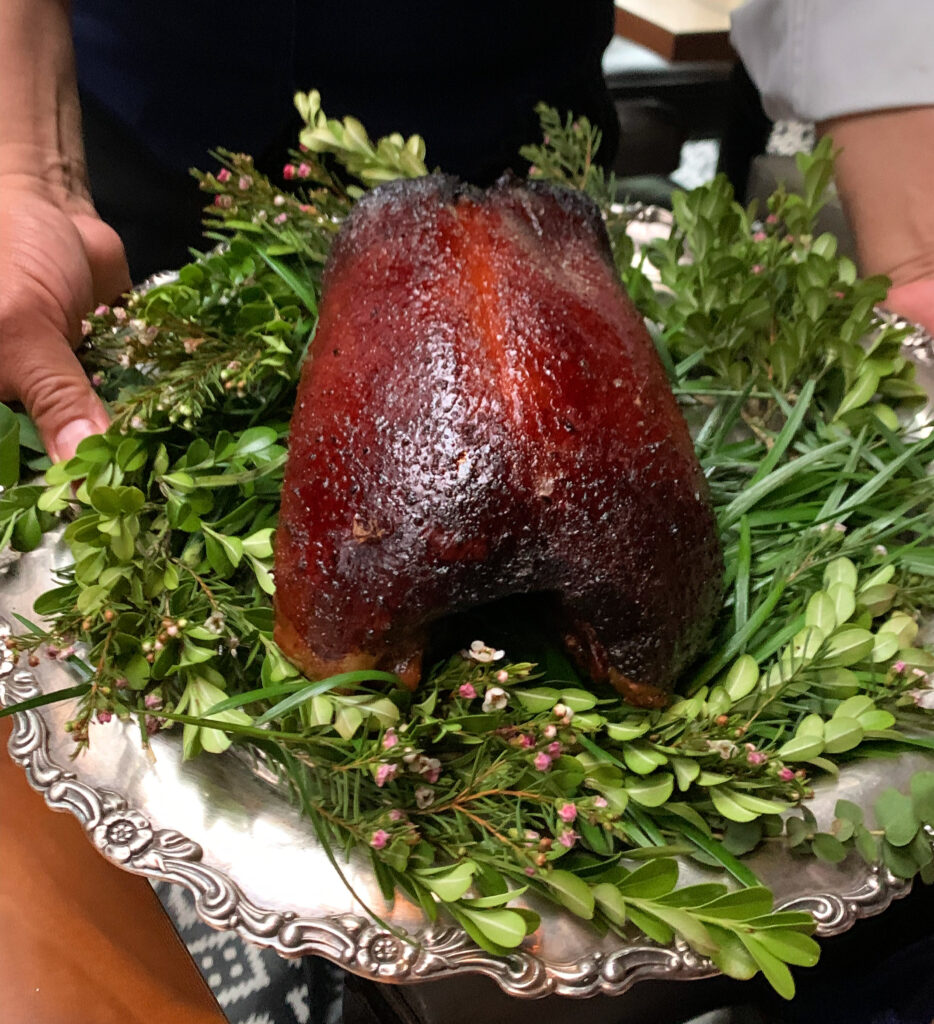
In its most superlative form, the bird’s roasted carcass—displaying the most delectable tones of mahogany (and just a wee bit of black)—is first presented tableside on a silver platter before returning to the kitchen to be butchered. When the duck reappears, its breasts have been sliced and attractively arranged, with plenty of jus, in a pan. The meat drawn from its legs, which has been confited then shredded, is presented in a smaller pan with dollops of mustard seed and strands of crispy skin. Finally, a series of accompaniments are introduced. Presently, that includes an apricot purée, a beet mostarda, roasted endives, and roasted turnips (served with their tops).
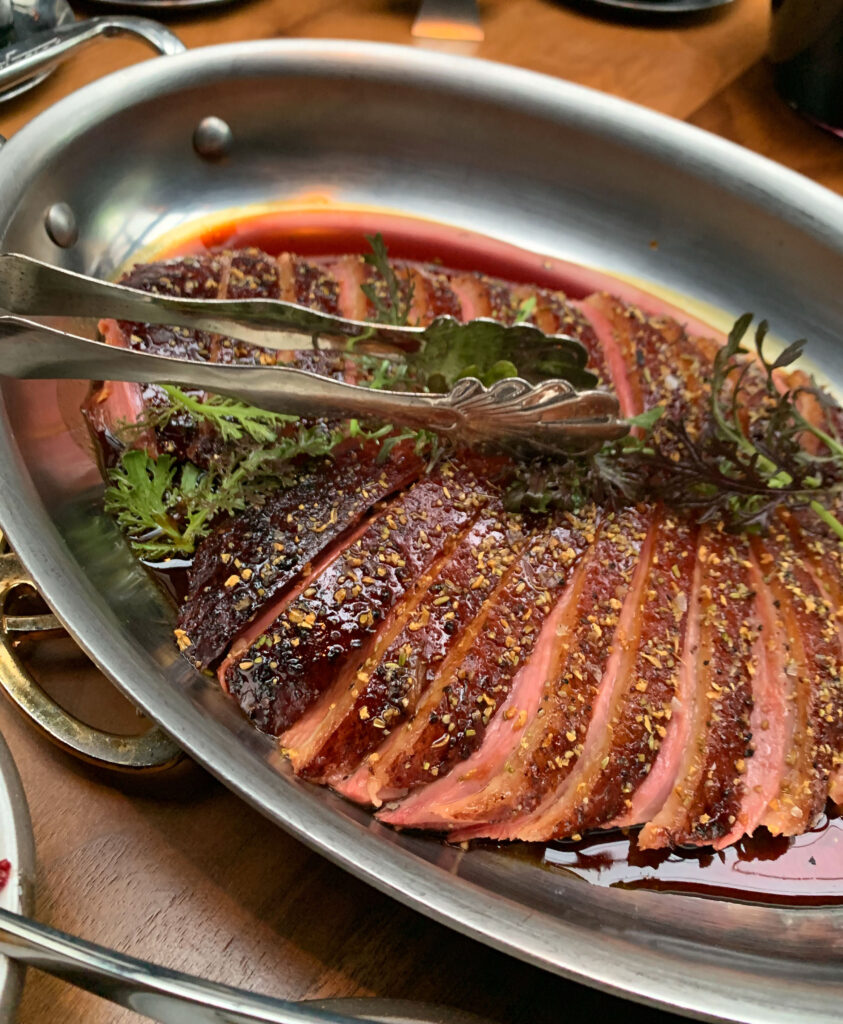
Starting with the duck’s breast, you must first note its crust. The bird’s skin is shatteringly crisp—so cleanly so—in a manner that the ingredient rarely attains. This effect, no doubt, is drawn from the dry-aging process and is inspired, rather clearly, by the method used for Daniel Humm’s “Lavender-Glazed Duck” (which the EMP chef calls “one of only few recipes” he has “truly perfected”). The skin in Boka’s version displays the same gorgeous, lacquered sheen with a generous sprinkling of spice (cumin, coriander) and plenty—in some cases almost too much—salt. On the palate, the transition from the duck’s outer crust to its subcutaneous, well-rendered layer of fat and, finally, its interior is glorious. The meat displays a satisfying degree of chew (though the thinner slices are best) and a nice amount of juiciness. It benefits from the tart-sweet tones of the accompanying apricot purée; however, you would like more intensity out of the duck jus. This would preclude the need for quite so much seasoning and better distinguish the breast meat with a deep, resonant flavor drawn within, from the carcass, rather than without (from condiments and spices). Such an essence of duck would make for a superior pairing with wine, but, otherwise, the protein is well-executed.

Though presented as more of an auxiliary item, the bird’s confited leg meat might be the real star. Soaked more fully in the jus, these succulent morsels strike your palate with a good deal more intensity than the slices of breast. The crunch provided by the interlaced strips of skin and the subtle pop of the accompanying mustard (alongside various leafy greens) provide textural intricacy. However, this expression of duck is all about power and purity with just a hint of uplifting tang. It all makes for one of the most decadent, deeply flavored bites of the evening.
Turning to the sides, you find the bounty of vegetables provided to be intellectually appealing but not all that hedonistic or memorable. The roasted turnips, despite being nicely tender, are probably the weakest. They strike you as a subtly sweet attempt at a potato replacement that is missing any of the same pleasure. In being so basic (even with the accompanying turnip tops), the side dish feels like simple filler. The roasted endives are a bit better thanks to the intermingling of butter, char, and crisp shallot segments throughout the ingredient’s concentric, crunching layers. There’s more sweetness here, but it is better balanced by an undercurrent of bitterness and nuttiness. Finally, the beet mostarda—laced with nuts, berries, and breadcrumbs—is the most successful. It provides all the vividly sweet, sour, savory, and satisfying tones you desired from the “Grilled & Glazed Beets.” In its complexity (and still with a slight, balanced earthiness), you think the side better contrasts the duck than the more straightforward apricot purée.
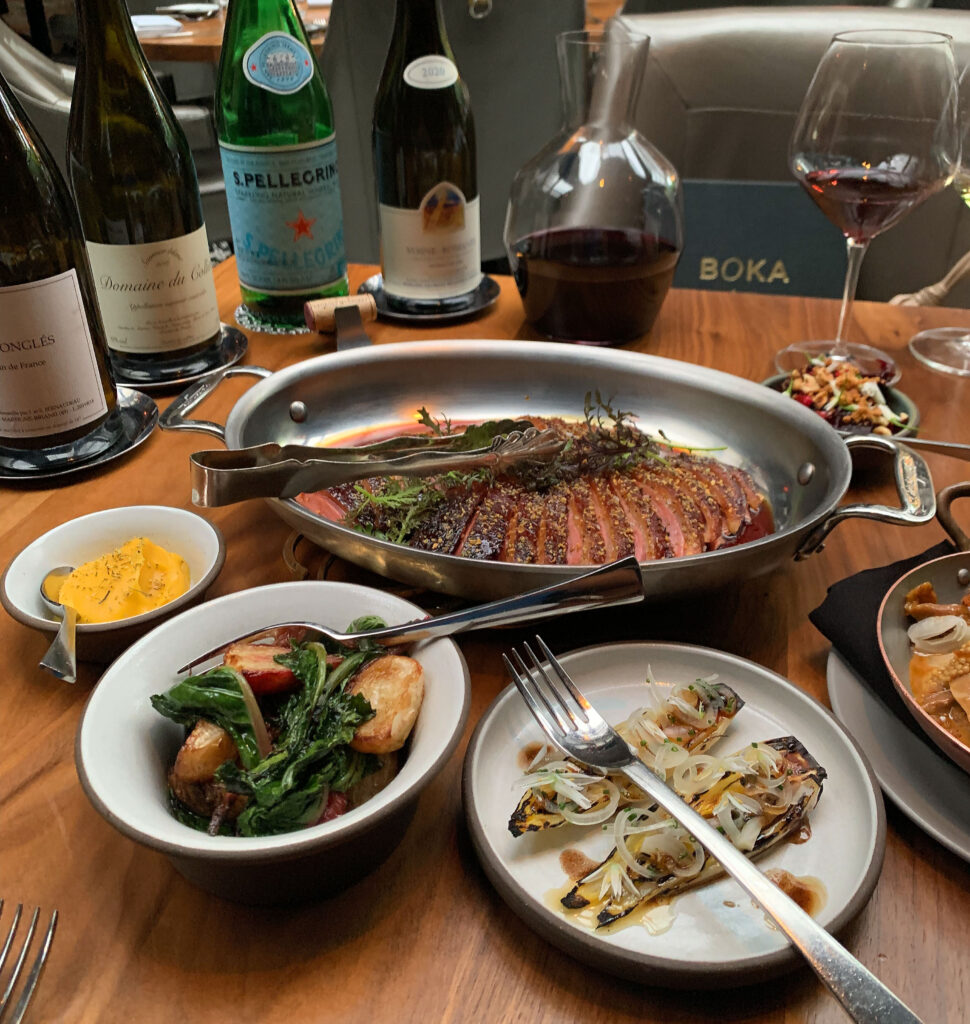
Ultimately, the “Whole Roasted Dry Aged Duck” makes for a worthy showpiece thanks to the virtuosity with which the protein is cooked. Still, you do not think those diners enjoying the smaller “Dry Aged Rohan Duck” preparation on the tasting menu are missing out on much. The breast meat, when you eat a lot of it, continues to impress with its texture but just misses that haunting—“this is the best duck I have ever tasted”—level of richness you might expect from such a longstanding item. The leg meat helps satisfy some of that carnal desire, but it represents a comparably meager portion of the presentation. The sides, too, make for a pretty picture but are not all that convincing. Each of them tends toward the sweeter side when, instead of contrasting the duck, you might wish revel in its savory flavor. Such a sensation, whether drawn from a better jus or some more hedonistic vegetable (to say nothing of the humble potato), would make you feel as though the kitchen was really aiming wholly at pleasure. But, as it stands (and considering the pretty penny it will cost you to pair the bird with a fine red from Boka’s list), it is hard to justify the preparation’s price or privileged status.
The “Whole Roasted Dry Aged Duck,” like much of the restaurant’s food, is technically sound but lacks the force of personality (or shall you say soul) to really feel special. The recipe trades on another chef’s idea without putting any definitive stamp on it or, to be honest, executing it quite as well. Rather, as a fossilized fixture buoyed by tableside flourishes, the dish only aspires to be “good enough” and nothing more. Surely, Chicago diners deserve something more than hand-me-downs?
Moving on, those who think the savory side of the tasting menu might end with duck will be pleasantly surprised to encounter a proper serving of steak. The “Châtel Farms American Wagyu,” as the dish is titled, centers on a surprisingly thick cut of striploin sourced from a herd of full-blood Akaushi cattle in Augusta, Georgia. This beef has featured on the menu at Adorn, Joe’s, Kindling, Maple & Ash, The Oakville, and RPM Steak over the past year. But, at Boka, it forms a headliner: being served, first, with spring onion, soubise, and bordelaise then, later, with artichoke, fava bean, and bordelaise.
You have repeatedly criticized Chicago chefs who serve thin pieces of that ubiquitous “A5 Miyazaki wagyu” as their star savory course, terming it a cop out, a crutch, a self-flagellation before the totemic luxury ingredient altar at a point in the meal where they should really be demonstrating the most creativity. But there are exceptions, and this is one of them. By sourcing his beef domestically, Wolen ensures that he can serve his guests a portion that really feels satiating. To begin, the striploin is tender, well salted, and possesses gushing veins of fat but retains enough sense of chew to please the American palate. In the first version, the charred spring onions and soubise imbue the steak with a rich, caramelized allium flavor that joins with the beefy, earthy bordelaise to shoot the dish’s savory flavor into the stratosphere. By comparison, the combination of nutty artichoke and fava bean is a bit more tame (though this may be influenced by the smaller serving of sauce). Thus, the second version misses a bit of the same wow factor, but, especially paired with Idenn’s aged Francs-Côtes-de-Bordeaux, this classic preparation—while hackneyed—yields a good degree of pleasure.
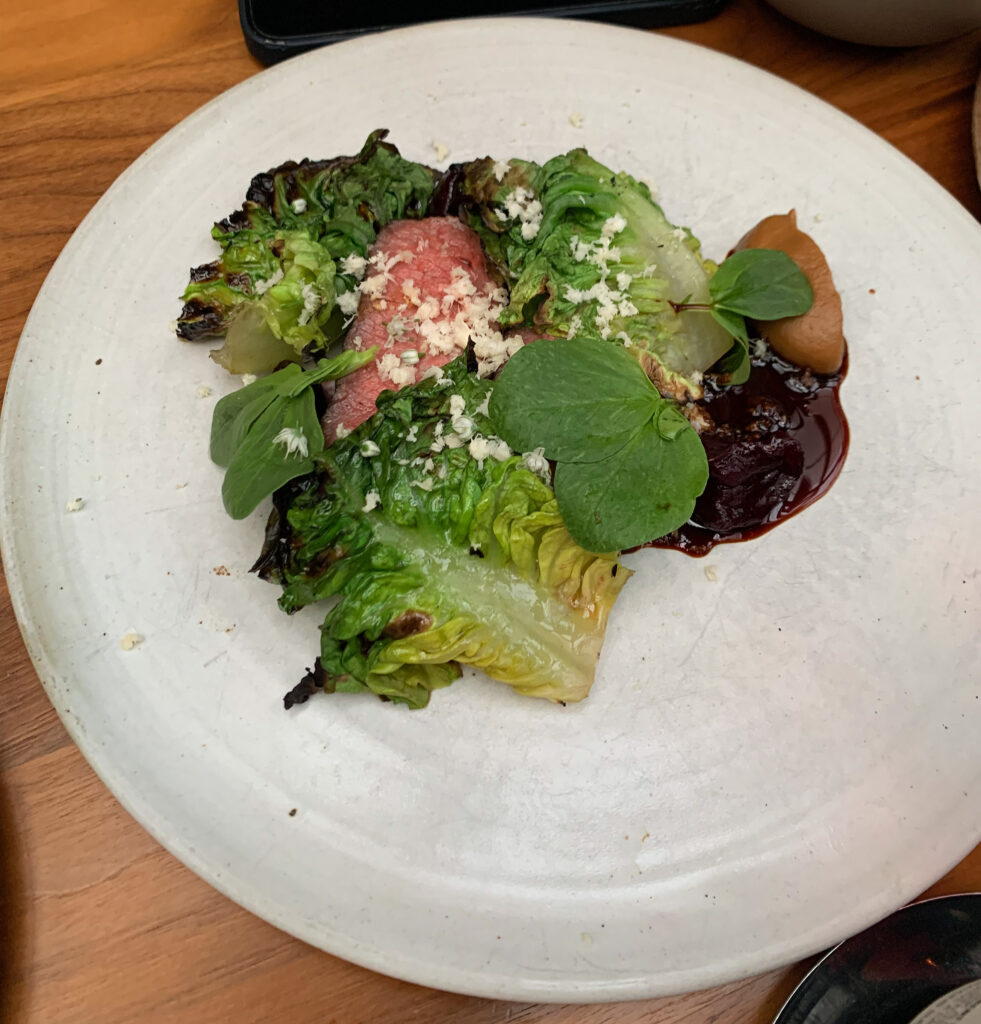
Customers searching for beef on the à la carte menu will find it courtesy of the “Grilled Short Rib.” Despite the title, the cut is given that 48-hour sous-vide treatment that was fashionable about 15 years ago. It is simply finished on the grill and comes paired with a healthy topping of gem lettuce, some smoked beets, and a black garlic sauce.
Though the origin of the beef used for the short rib is uncertain, it possesses a nice texture. While not, understandably, as marbled as the preceding striploin, the cut combines a charred crust with a fleeting (yet satisfying) firmness that yields to a tender, juicy interior. Yes, that sous-vide method ensures the beef, despite its thickness, displays a homogenously soft texture that invites the contrasting crunch of the lettuce and smoked beet. Though that root vegetable brings some subtly sweet and fruity flavors to the table, the black garlic sauce does the heavy lifting. It, like the bordelaise, charges the short rib with an added dose of umami that unlocks a greater, beefier depth. You would rank this preparation somewhere between the first (superior) and second (inferior) versions of “Châtel Farms American Wagyu,” which is to say that it is well executed (if not life-changing).
With that, the savory portion of the meal draws to a close, and you find yourself in the hands of pastry chef Kim Mok. Before the prospect of any à la carte dessert is approached, those enjoying the tasting menu are treated to a transitional course.
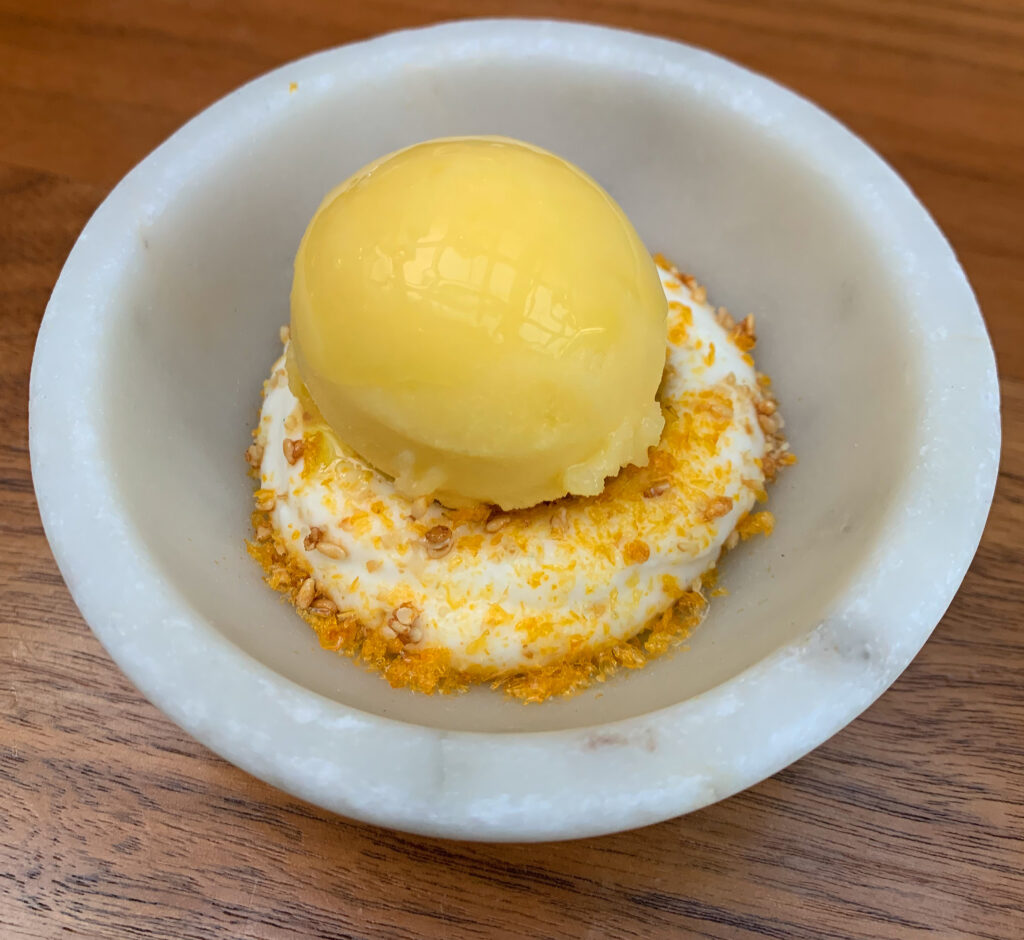
Mok’s “Kalamansi Sorbet” sounds simple enough—something cold and fruity to revitalize the palate as so many intermezzi do—but it actually displays a captivating depth. Yes, the titular frozen delight, made from the sour citrus hybrid native to the Philippines (and likened to a combination of lemon, lime, and orange), takes center stage. However, the shining globe of sorbet comes coated in olive oil and sits atop a mound of ricotta. Some bits of white sesame and thin shavings of mandarin orange then serve to complete the sundae. Diving in, the sorbet displays a perfectly smooth, melting texture that marries beautifully with the fluffy, almost marshmallowy ricotta and slick olive oil. The sesame seeds, as expected, provide a satisfying crunch. But the dish really impresses due to how the tangy-sweet kalamansi blends effortlessly with the milky-sweet (and very slightly sour) cheese. This allows the nutty notes of the white sesame, the subtle (but rich) olive notes, and the surprisingly vanillin mandarin zest to assert themselves and transform the dish from refreshing to decadent as you make your way through it. The “Kalamansi Sorbet” is quite impressive and stands as one of the best dishes you have tasted from the pastry chef.
Continuing with the tasting menu, the final course of the evening comprises “Pistachio,” which is rendered as a crémeux, and paired with several expressions of dark chocolate, malted milk ice cream, and a touch of lemon. Texturally, the dish combines the rich, green cream with the crunch of a chocolate cracker/crumble, the tongue-coating sensation of a chocolate shaving, and the fine, crisp layers of what almost seems like a chocolate baklava. The ice cream, meanwhile, is surprisingly light and serves to help moisten these more pronounced, drying components. With regard to flavor, the dish offers a cavalcade of nutty, roasted, toasted, caramel, and cocoa notes alleviated by just a bit of sourness. This makes for pure hedonism, kept in perfect balance, and represents another triumph for Mok. It stands as the strongest of the “proper” desserts alongside…
The “Roasted Rhubarb” ($14), offered à la carte, and paired with Japanese cheesecake, guava-rhubarb sorbet, toasted milk custard, a buckwheat crumble, and a sauce made with hibiscus. There’s a lot going on here, and it comes together beautifully. The cheesecake, your very favorite of all desserts, possesses a nice fluffy, “cotton” consistency but derives plenty of added flavor from the caramelly toasted milk. The nutty buckwheat, too, adds to a sense of decadence while calling to mind that beloved graham cracker crust. This all serves as a canvas for the smooth, faintly crisp pieces of rhubarb and the encompassing mouthfeel of the sorbet. These elements, when they join together with the hibiscus sauce, provide an array of sweet, sour, and ripe fruit notes that replicate something like a traditional strawberry sauce that might be served with a conventional cheesecake. The rhubarb remains the most forceful of all flavors, but there is an intensity of cheesy, custardy goodness here that is really delightful.
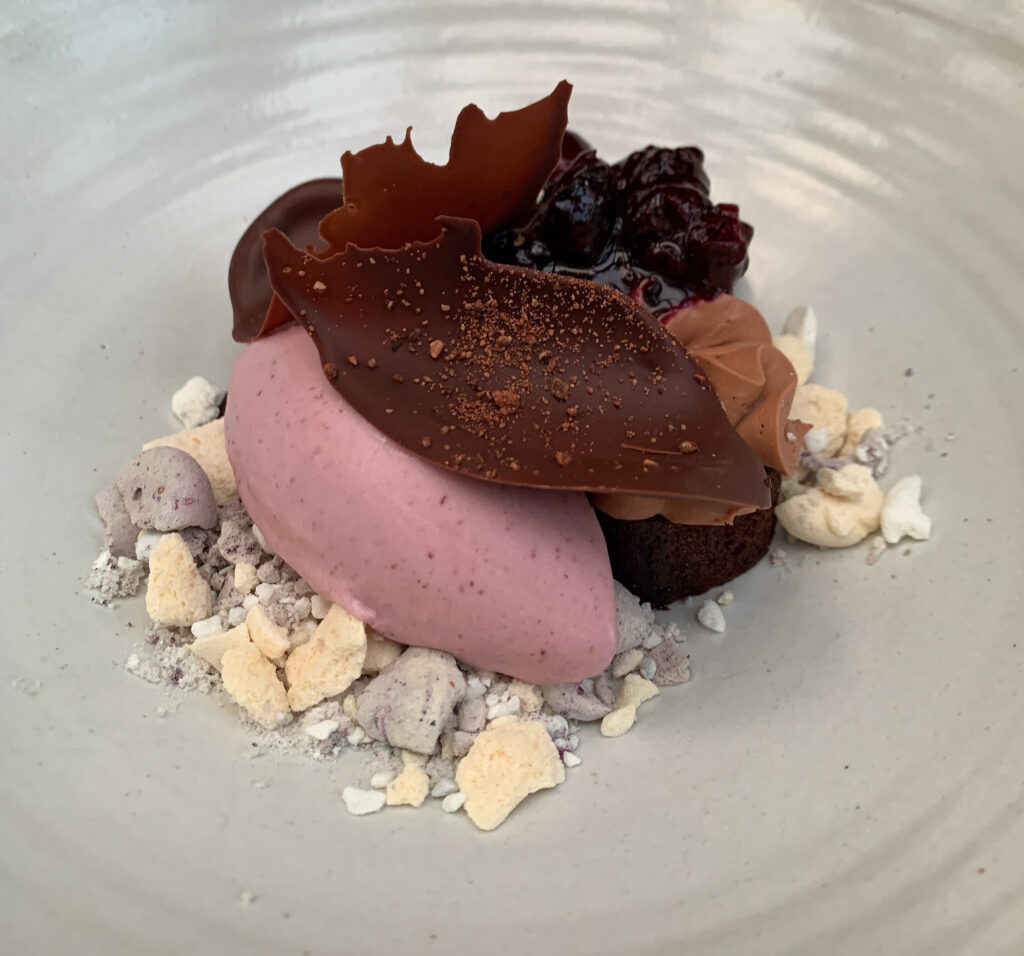
Mok’s “Mochi Brownie” ($14), by comparison, lands more on the interesting—rather than decadent—side. The dish revolves around its namesake confection (topped, as it should be, with chocolate frosting) and dresses it with a combination of blackberry frozen yogurt, blueberries, and sweet clover, which you think is rendered as part of the crumble at the bottom of the plate. There’s even a couple of attractive chocolate leaves that serve as a garnish. However, pretty as the preparation is, you find any chewy, mochi sensation to be rather mild. The flavors of the chocolate, the blueberry, the blackberry, and the sweet clover (often used as a replacement for vanilla) also seem muted. For some reason, everything seems to cancel each other out, yet the dish does make you think. There could be a good idea here.
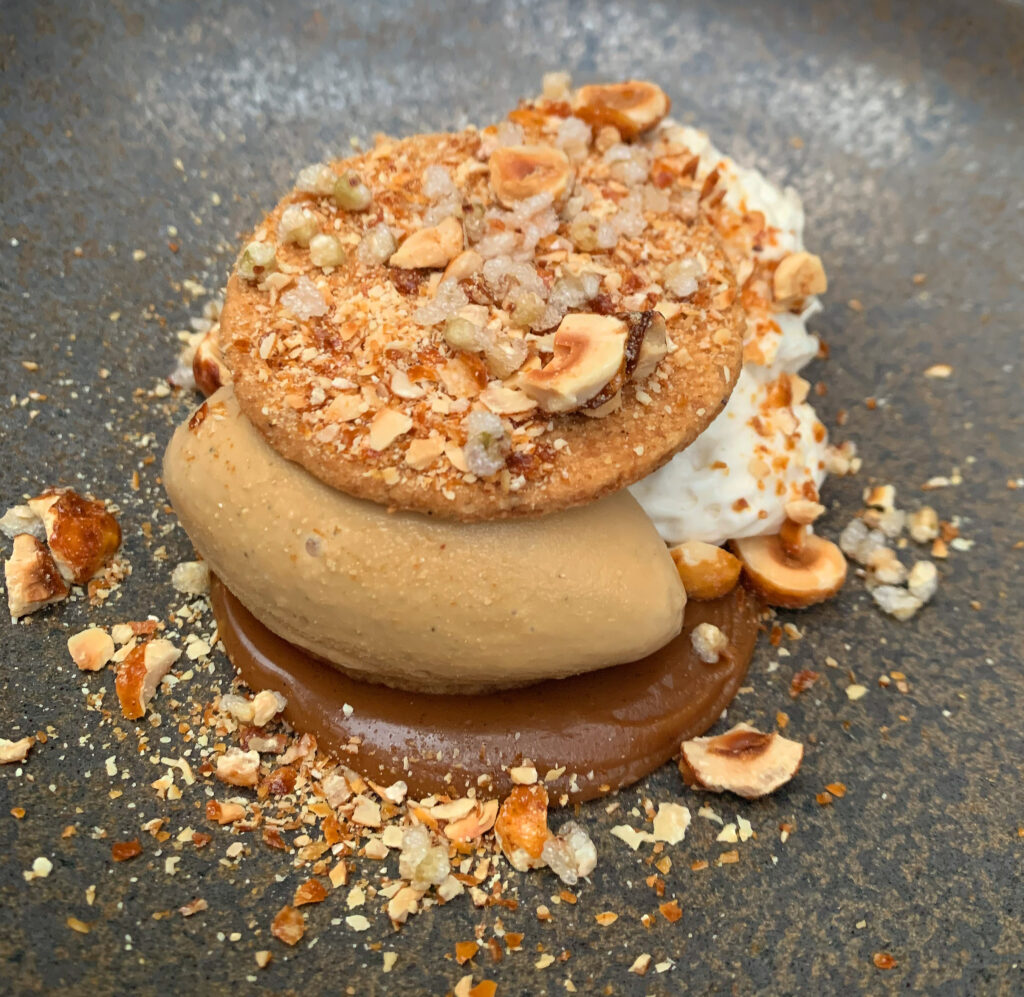
Finally, you have the “Caramelized Hazelnut” ($14), which sounds like it would be straightforwardly pleasing and, in fact, represents something of a signature for the restaurant. However, in its current form, the combination of hazelnut mousse, chicory ice cream, banana whipped cream, and buckwheat cookie leaves you perplexed. The crunchy, crumbly, sticky, and luscious textures are nice enough, but their resulting flavor is tinged with a strange chemically, plasticky note. This dessert is undoubtedly the weakest of the bunch, and it is hard to know what might have gone wrong on this particular occasion.
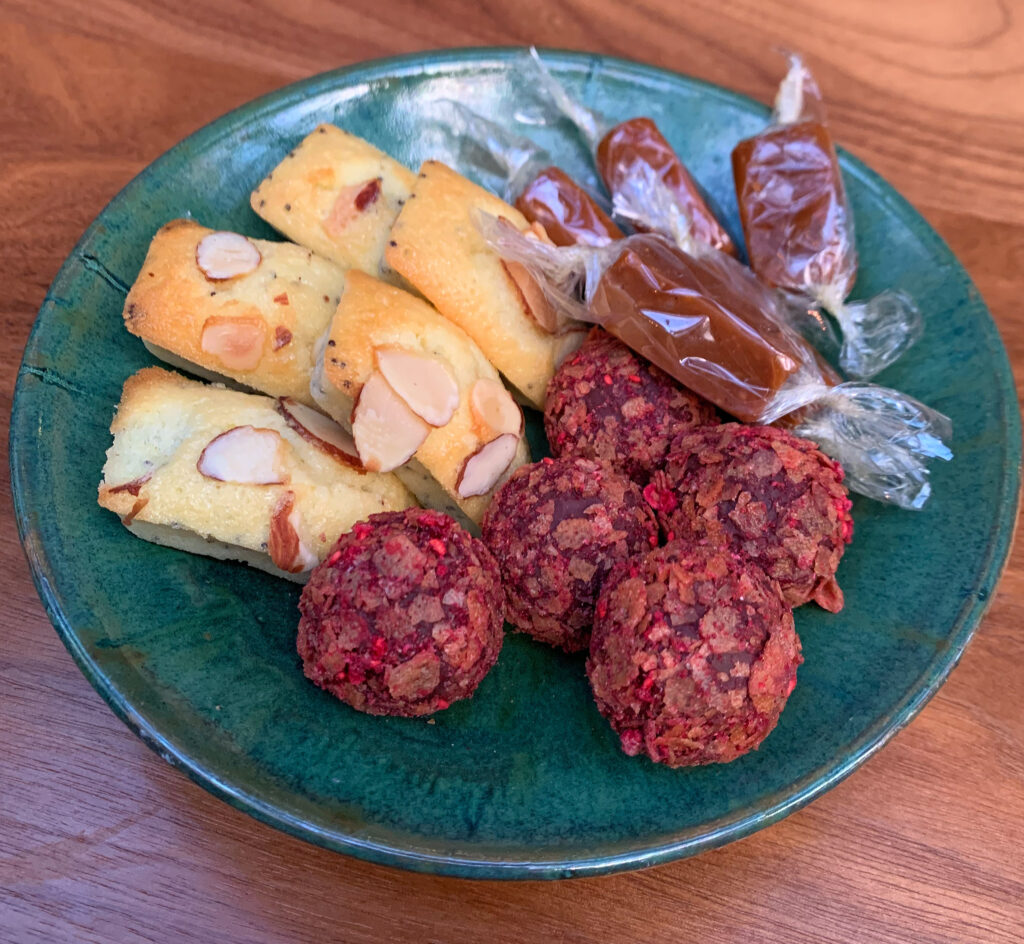
Though the desserts are now finished, the pastry chef—whether you have enjoyed the tasting menu or ordered à la carte—has a couple more surprises in store. First, there are the “Mignardises,” which presently include an almond-poppy seed financier (technically a petit four due to the fact that it is baked), a raspberry-cassis truffle, and a plastic-wrapped caramel. These bites are dainty, aesthetically pleasing (though the financier could be a bit cleaner), and executed well. You find the balance of chocolate and fruit in the truffle to be particularly nice.
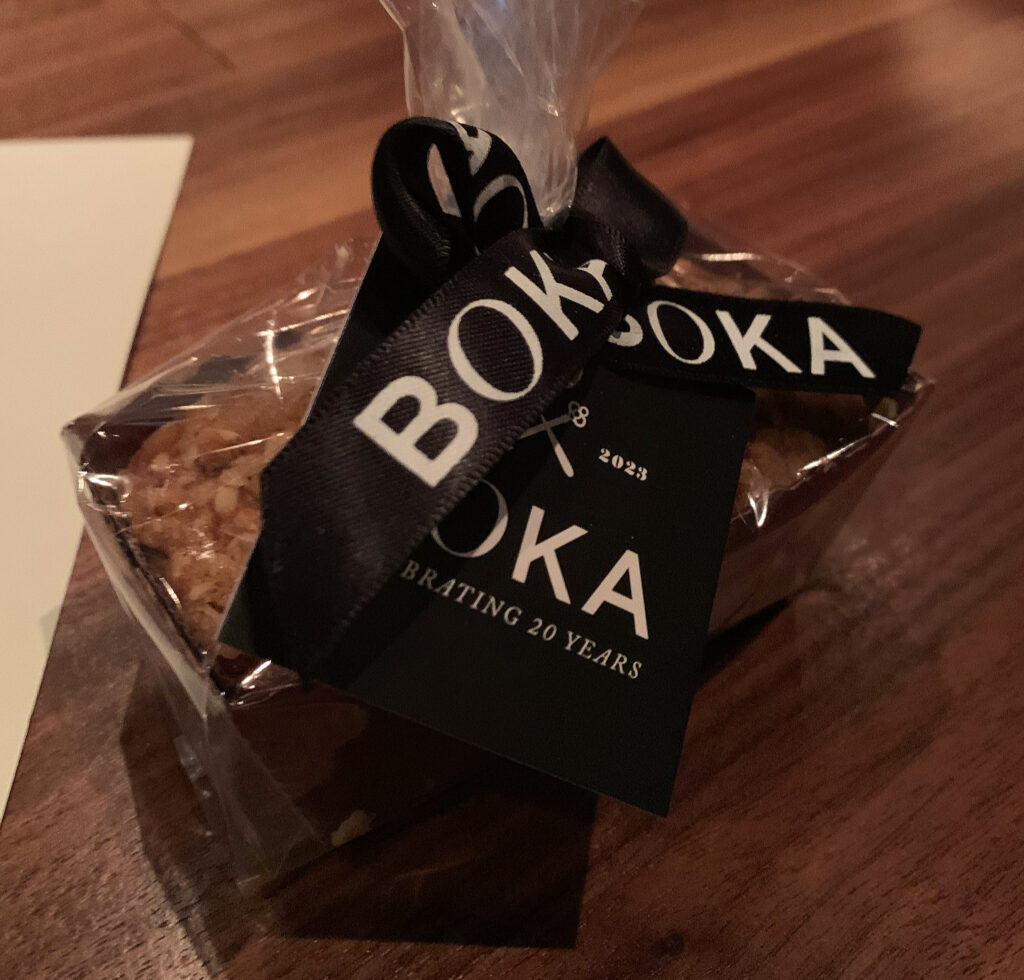
Lastly, there’s the take-home treat: a wrapped coffee cake—complete with “Celebrating 20 Years” card and ribbon—that arrives with the menu. Once more, this is an eye-catching little delight that, whether you eat it that night or several days later, strikes you with its crisp, then crumbly texture and lasting sweetness. This coffee cake calls the meal’s most pleasurable moments back to mind and, as far as throwbacks go, is a welcome one. Too many restaurants have begun to opt for inedible keepsakes that, while sometimes creative, usually amount to needless clutter.
With that, you pay the check and make the trek past Dave, past Bill, through the hardware-lined lobby, and back out the door. The transition—from the Michelin-starred sanctum to the front patio and then curbside on Halsted—is surprisingly serene. If not for the comings and goings of Alinea’s dapper, once-in-a-lifetime diners, you could be stepping out of any neighborhood restaurant on any street in the city. Therein lies the charm and the tragedy of Boka.
As a budding gastronome, BRG’s crown jewel formed your gentler introduction to fine dining. You had already seen the mountaintop at places like L2O and Alinea by the time you made your first visit. But Boka formed an important counterpoint, asserting that excellence, comfort, approachability, and attentiveness could shine—brightly—without the need for any worshipful posture or mind-bending theatrics. The restaurant was a sure thing. It was the perfect entry-level tasting menu for fine dining debutants, especially those who might harbor some skepticism of the form, and you recommended it as such. However, you, yourself, quickly tired of it. Boka was not avant-garde enough. It was the refined “neighborhood restaurant” located a bit too far from where you lived. The wine list, on occasion, enticed you to come in, yet the cuisine never left you clamoring to come back.
Boka has built a loyal clientele over the course of three executive chefs and two decades. It should be—and is—sensitive to the desires of those who have been along for the ride rather than someone, like yourself, who comes late to the party simply seeking a “Michelin-starred experience.” Why kill a golden goose by pushing boundaries and polarizing regulars who already live by the “anytime you have time” ethos? Food—even fine food—can shine as that familiar, steadfast friend: the perfect preparation you dream about because it satisfies, week after month after year, without fail. Leave challenging palates to the upstarts who still have a name to make. Be the benchmark, the foundation, against which and upon which the city’s dining culture grows.
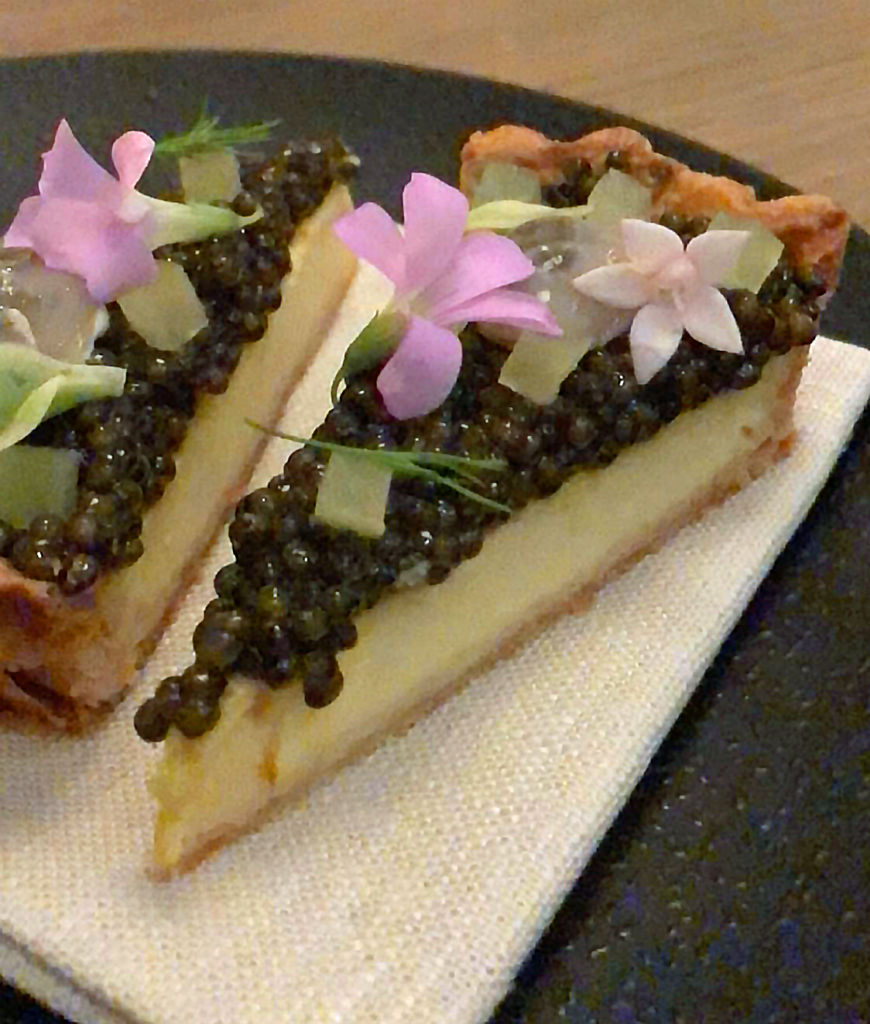
You might have made this argument 10 years ago, and, inarguably, BRG has reached ever-higher peaks since then. Boka’s consistency and credentials have empowered expansion into the oyster bar, sushi, steakhouse, diner, Chinese, Mediterranean, Peruvian, Italian, Basque, French, and Israeli genres. The crown jewel has made Boehm and Katz national players, authoritative voices on the art of hospitality. Bellemore, you think, might have been their chance to write the future of American cuisine had it succeeded. But, pandemic aside, the concept now seems poisoned from the start. It leaned on an overrated, viral “Oyster Pie” to get people through the door then treated them to fussy, “bold, bright and beautiful” “artistic American” fare from a chef being forced to cook the antithesis of the cuisine on which he made his name.
You have covered this all in detail before, but you think it still forms the key to understanding the game BRG is playing. The group—having won its James Beard Award—is no longer proactive, but reactive. It does not foster inspiration—the dreaming up of an experience the customer didn’t know they desired—but pursues the lowest common denominator with corporate concocted derivatives and half-assed copies of what someone, somewhere else, has already done.
You suppose that’s what Boka aimed at from the start when taking its cue from Gramercy Tavern, and that has proven to be a winning formula. But Gramercy Tavern—with an executive chef that has now been there for 17 years—has continued to grow without sacrificing its timeless appeal. Michael Anthony has uplifted successive chefs de cuisine that have put their personal stamps on seasonal American fare while keeping the menu accessible, affordable, and effortlessly pleasing. The wine list there has never stopped growing—never cynically revised its pricing scheme—and ranks as one of the best in the country (if not the world).
By comparison, Boka has stagnated and maybe even declined over Wolen’s tenure. It all started well enough: Eleven Madison Park credentials, a fancy renovation, an eager media apparatus (always exceptionally managed by BRG) ready to coronate the new and improved mothership. Some of the most longstanding dishes—the “Lightly Cured Hiramasa” (along with other marinated fish), the “Dry Aged Beef Tartare,” the “Black Truffle Tajarin,” the “Slow Cooked Ocean Trout” (along with other gently prepared fish), the “Whole Roasted Dry Aged Duck,” and the “Grilled Short Rib”—remain good, even great. But none of them are excellent. Only one (the hiramasa) ranks among the best preparations of its kind in the city. And the inconsistencies you have noted with regard to the “Ricotta Gnudi” and “Black Truffle Tajarin” are downright laughable.
Wolen is a paint-by-numbers chef who safely holds the fort—and the legitimacy that Michelin star affords—while BRG pursues expansion. You could respect that if Boehm and Katz were still looking to challenge Chicagoans and enrich their dining scene elsewhere. However, as BRG increasingly favors other markets and looks to cash out back home, it is right to question just what their reputation is built on.
Today, the Boka ambiance is still attractively divided into distinct zones, but some elements (celebrity portraits, anthropomorphic animals, the fake Oscar Wilde quote) strike you as a bit goofy. The wine list is among the most overpriced in the city while the food, whose cost is easier to stomach, is above average—sometimes very good—but static and boring. It offers a vision of American cuisine that is big on purées, frilly greens, and superfluous flowers but lacks any personality you can connect to, any boldness, any soul. To that point, the chef, now a figurehead for fast casual spinoffs, almost never shows his face. Though (and this is both a good and bad thing), the level of the cuisine does drop when he is not in the building.
There are, admittedly, some real bright spots. The front-of-house team, from top to bottom, is superb. You certainly received some special attention, but the warmth from all involved was totally canny. Such sincerity cannot be faked, and creating (as well as maintaining) an environment where the staff can be themselves and really shine is a testament to the culture Boehm and Katz have built.
Thorn, too, on the beverage side does a marvelous job. As does Idenn, who is able to transcend BRG’s pricing guidelines by offering stellar by-the-glass and pairing selections. His ability to train the staff and cultivate an overarching enthusiasm for what is being poured also really impresses you. (Still, you cannot help but feel like the wine director’s talent is being wasted a bit when the bottles he picks out are priced so egregiously.) Certain concessions, like the reasonable pricing of truffles, are worthy of respect (at least when the totemic luxury ingredient is treated properly). And, finally, Mok’s work with pastry, while hit or miss, shows flashes of quality and of the personality you find so missing across the savory side of the menu.
Imagine if such a superlative team had the chance to present (and complement) a cuisine that looked forward, took risks, and led Chicagoans toward a deeper, emotionally engaging expression of nature and craft. Rather than propping up decade-old recipes, they could tell a new story and really challenge themselves by pleasing customers who find themselves, just a bit, outside of their comfort zone. Is it totally wrong to expect that BRG, which all its resources and reputation, should look to cultivate connoisseurship in this city rather than profiting, year after year, on “good enough”? Is it right to trumpet “a new concept by Michelin Starred Chef Lee Wolen” when Boka may be the weakest restaurant in Chicago to presently be awarded that honor by Michelin? At least The Alinea Group, for all its sins, is still trying to push itself toward some new frontier. BRG only wants more of the same, on a bigger and wider scale, to squeeze its customers harder and harder while offering less ingenuity and value.
In the final analysis, the state of Boka’s cuisine is not unforgiveable. With better bread, improved desserts, more consistent execution across the board, and a wine list that celebrates—rather than punishes—oenophiles, those timeworn recipes might actually still seem charming. But, when you consider how cynically BRG now approaches this market and how impersonally its star chef approaches his craft, the good work of the frontline hospitality staff rings hollow.
Boka is, no doubt, a grande dame of Chicago dining, but one who has gone senile. She can still show you a good time so long as you know to be gentle, to not expect too much, to laugh at the same old jokes, and to listen patiently as she tells the same story for the umpteenth time. (Oh, and don’t let her get into her cups.) You may even still love her—if you knew her in the flush of youth—but the glory days are over. She doesn’t try to please any more (nor would she even know how to), for she is stuck in her ways and now grows increasing stingy. Her caretakers, meanwhile, pick her purse and prostitute her reputation for the sake of promoting the next hot young thing. Boka, as an institution, still deserves respect. She is not bad by any means, but you must accept the deluded grande dame for what she is: a neighborhood relic that holds great memories but no longer makes them. Has the rigor mortis already set in?


